


TIMBUKTU REGION, MALI, 21 SEPTEMBER 2009: Tuareg Nomads end the Ramadan fast in the desert about 50 kilometers outside of Timbuktu with prayer and dancing, Timbuktu Region, Mali, September 21 2009. (Photo by Brent Stirton/National Geographic.)

INGAL, NIGER, OCTOBER 2009: Two young Tuareg women have their hair dressed by other Tuareg women inside a traditional nomad tent at a Tuareg Nomad camp, Ingal Region, Niger, 11 October 2009. Tuareg Nomads have two traditional priorities, their animals and access to water. This group has moved to this region at this time to enjoy the remaining good grassland of the rainy season and will soon move again to be close to a good water source. The nomads survive on a diet of millet and camel milk which is occasionally supplemented by goat meat. (Photo by Brent Stirton/National Geographic.)

INGAL, NIGER, OCTOBER 2009: Scenes at a Baptism in a Tuareg Nomad camp, Ingal Region, Niger, 11 October 2009. Tuareg Baptism is very simple, three names are discussed by elders and then straws are drawn to choose the final name. The women perform a ritual of walking around the tent in a line with the leading woman brandishing two knives to symbolically cut away misfortune from the future of the child. The women then dance and sing and play the drums while men prepare goat mead and drink tea and discuss things while people visit from the surrounding nomad camps. Tuareg Nomads have two traditional priorities, their animals and access to water. This group has moved to this region at this time to enjoy the remaining good grassland of the rainy season and will soon move again to be close to a good water source. The nomads survive on a diet of millet and camel milk which is occasionally supplemented by goat meat. (Photo by Brent Stirton/National Geographic.)

TIMBUKTU, MALI, JANUARY 2010: A young Tuareg artisan boy, Anara Ag Hamay Cisse, 13 years old, stands in the dunes outside of Timbuktu, the mythical Northern Mali city, January 18, 2010. (Photo by Brent Stirton/Reportage by Getty images.)

TIMBUKTU, MALI, JANUARY 2010: Two Tuareg men drive a traditional Camel caravan laiden with salt tablets on twenty camels making the 16 day journey through the desert from Taodenni, a salt mine in the north of Mali, to the home of an Arab businessman in Timbuktu, Mali, 22 January 2010. The salt industry is in transition, long the province of the Tuareg and their camel caravanss, modernization has seen the Arabs come to dominate this trade, using powerful trucks to transport the salt over the desert in a tenth of the traditional time with far more salt onboard. As a result the camel caravans are now seen as the poor man's alternative and trucks are more and more the route of the future. Disputes between the clans of the Tuareg have also seen the caravans become far smaller, they are no longer incentivised to work together for a large caravan and it is rare to see a caravan of more than 20 camels nowadays. Everytime the caravan stops, the camels must be unloaded and it is hard and brutal work, many young Tuaregs would rather do something else or work with the Arab traders and their trucks. The Tuareg men on this caravan feel that the trade will continue on camels but that it will be the poor who undertake the long, arduous journey as they have no alternative. Ironically, most of the route with the exception of two small zones is now undertaken by the camel caravan on the same road that is used by the trucks. (Photo by Brent Stirton/Reportage by Getty images.)

AGADEZ, NIGER, SEPTEMBER 2009: Scenes at the Agadez animal market, Niger 29 September 2009. (Photo by Brent Stirton/National Geographic.)

AGADEZ REGION, NIGER, SEPTEMBER 2009: Tuareg master sword maker Abda Ahmoudou, 35, works on Tuareg swords in his workshop in Agadez city, Niger, 30 September 2009. Tuareg swords are seen as an important symbol for a Tuareg man but functions primarily as decoration and less as a defensive weapon nowadays. The best swords says Ahmoudou are made from the driveshafts of 1960's LandRover driveshafts which apparently produce the best weight and the straightest piece of metal with which to fashion the sword. The swords can fetch prices often in excess of 150 000 CFA, around $350. "A man without a sword is missing something. Every Tuareg man must have a sword. It would take me a month to explain the reasons behind the Tuareg sword, every sword has a name based on the quality of the blade and the swordmaker. "(Photo by Brent Stirton/National Geographic.)

ASSEKREM, TASSILI DU HOGGAR, SOUTHERN ALGERIA, APRIL 2009: Achmed, a Tuareg guide and elder photgraphed in a mountain cabin in the Tassili Du Hoggar, a series of beautiful rock plateaus that begin approximately 300km's south of Tamanrasset and extend all the way to the Niger border, 17 April 2009, Assekrem, Tassili Du Hoggar. These images were photographed from a small mountaintop cloister run by followers of the Frenchman Charles De Foucald. Foucald, once a hedonistic 19th century playboy, became devoutly religous and moved to Tamanrasset and in 1911 chose Assekrem as the site of his hermitage. He was assasinated by Tuaregs in 1916 after he was suspected of being a French spy. (Photo by Brent Stirton/National Geographic.)

TASSILI 'N AJJER, SOUTHERN ALGERIA, APRIL 2009: Images of famed tourist site and traditional Tuareg land, Tassili 'n Ajjer, in the south of Algeria, 02 May 2009. (photo by Brent Stirton/National Geographic Magazine.)

ASSEKREM, TASSILI DU HOGGAR, SOUTHERN ALGERIA, APRIL 2009: Images in the Tassili Du Hoggar, a series of beautiful rock plateaus that begin approximately 300km's south of Tamanrasset and extend all the way to the Niger border, 17 April 2009, Assekrem, Tassili Du Hoggar. These images were photographed from a small mountaintop cloister run by followers of the Frenchman Charles De Foucald. Foucald, once a hedonistic 19th century playboy, became devoutly religous and moved to Tamanrasset and in 1911 chose Assekrem as the site of his hermitage. He was assasinated by Tuaregs in 1916 after he was suspected of being a French spy. (Photo by Brent Stirton/National Geographic.)


INGAL, NIGER, OCTOBER 2009: Tuareg men and their camels at a Baptism in a Tuareg Nomad camp, Ingal Region, Niger, 11 October 2009. Tuareg Baptism is very simple, three names are discussed by elders and then straws are drawn to choose the final name. The women perform a ritual of walking around the tent in a line with the leading woman brandishing two knives to symbolically cut away misfortune from the future of the child. The women then dance and sing and play the drums while men prepare goat mead and drink tea and discuss things while people visit from the surrounding nomad camps. Tuareg Nomads have two traditional priorities, their animals and access to water. This group has moved to this region at this time to enjoy the remaining good grassland of the rainy season and will soon move again to be close to a good water source. The nomads survive on a diet of millet and camel milk which is occasionally supplemented by goat meat. (Photo by Brent Stirton/National Geographic.)

INGAL, NIGER, OCTOBER 2009: Tuareg Nomads on the move to a place of better grazing and water supply, Ingal Region, Niger, 10 October 2009. This group has been in this region for the rainy season, taking advantage of easy water access and good grasses for the animals. The moving is done in stages, usually the Camel herd goes first with a few men, then come the goats and then the rest of the Nomads follow with all their possessions mounted onto donkeys. Tuareg nomad tents are lightweight using wood from the south of Niger, the matting and material which cover them fold down easily. Tuareg Nomads have two traditional priorities, their animals and access to water. This group has moved to this region at this time to enjoy the remaining good grassland of the rainy season and now have to move again to be close to a good water source. The nomads survive on a diet of millet and camel milk which is occasionally supplemented by goat meat. (Photo by Brent Stirton/National Geographic.)

TIMBUKTU, MALI, JANUARY 2010: Two Tuareg men drive a traditional Camel caravan laiden with salt tablets on twenty camels making the 16 day journey through the desert from Taodenni, a salt mine in the north of Mali, to the home of an Arab businessman in Timbuktu, Mali, 22 January 2010. The salt industry is in transition, long the province of the Tuareg and their camel caravanss, modernization has seen the Arabs come to dominate this trade, using powerful trucks to transport the salt over the desert in a tenth of the traditional time with far more salt onboard. As a result the camel caravans are now seen as the poor man's alternative and trucks are more and more the route of the future. Disputes between the clans of the Tuareg have also seen the caravans become far smaller, they are no longer incentivised to work together for a large caravan and it is rare to see a caravan of more than 20 camels nowadays. Everytime the caravan stops, the camels must be unloaded and it is hard and brutal work, many young Tuaregs would rather do something else or work with the Arab traders and their trucks. The Tuareg men on this caravan feel that the trade will continue on camels but that it will be the poor who undertake the long, arduous journey as they have no alternative. Ironically, most of the route with the exception of two small zones is now undertaken by the camel caravan on the same road that is used by the trucks. (Photo by Brent Stirton/Reportage by Getty images.)

TIMBUKTU, MALI, JANUARY 2010: Two Tuareg men drive a traditional Camel caravan laiden with salt tablets on twenty camels making the 16 day journey through the desert from Taodenni, a salt mine in the north of Mali, to the home of an Arab businessman in Timbuktu, Mali, 22 January 2010. The salt industry is in transition, long the province of the Tuareg and their camel caravanss, modernization has seen the Arabs come to dominate this trade, using powerful trucks to transport the salt over the desert in a tenth of the traditional time with far more salt onboard. As a result the camel caravans are now seen as the poor man's alternative and trucks are more and more the route of the future. Disputes between the clans of the Tuareg have also seen the caravans become far smaller, they are no longer incentivised to work together for a large caravan and it is rare to see a caravan of more than 20 camels nowadays. Everytime the caravan stops, the camels must be unloaded and it is hard and brutal work, many young Tuaregs would rather do something else or work with the Arab traders and their trucks. The Tuareg men on this caravan feel that the trade will continue on camels but that it will be the poor who undertake the long, arduous journey as they have no alternative. Ironically, most of the route with the exception of two small zones is now undertaken by the camel caravan on the same road that is used by the trucks. (Photo by Brent Stirton/Reportage by Getty images.)

TIMBUKTU, MALI, JANUARY 2010: Two Tuareg men drive a traditional Camel caravan laiden with salt tablets on twenty camels making the 16 day journey through the desert from Taodenni, a salt mine in the north of Mali, to the home of an Arab businessman in Timbuktu, Mali, 22 January 2010. The salt industry is in transition, long the province of the Tuareg and their camel caravanss, modernization has seen the Arabs come to dominate this trade, using powerful trucks to transport the salt over the desert in a tenth of the traditional time with far more salt onboard. As a result the camel caravans are now seen as the poor man's alternative and trucks are more and more the route of the future. Disputes between the clans of the Tuareg have also seen the caravans become far smaller, they are no longer incentivised to work together for a large caravan and it is rare to see a caravan of more than 20 camels nowadays. Everytime the caravan stops, the camels must be unloaded and it is hard and brutal work, many young Tuaregs would rather do something else or work with the Arab traders and their trucks. The Tuareg men on this caravan feel that the trade will continue on camels but that it will be the poor who undertake the long, arduous journey as they have no alternative. Ironically, most of the route with the exception of two small zones is now undertaken by the camel caravan on the same road that is used by the trucks. (Photo by Brent Stirton/Reportage by Getty images.)

TIMBUKTU, MALI, JANUARY 2010: Two Tuareg men drive a traditional Camel caravan laiden with salt tablets on twenty camels making the 16 day journey through the desert from Taodenni, a salt mine in the north of Mali, to the home of an Arab businessman in Timbuktu, Mali, 22 January 2010. The salt industry is in transition, long the province of the Tuareg and their camel caravanss, modernization has seen the Arabs come to dominate this trade, using powerful trucks to transport the salt over the desert in a tenth of the traditional time with far more salt onboard. As a result the camel caravans are now seen as the poor man's alternative and trucks are more and more the route of the future. Disputes between the clans of the Tuareg have also seen the caravans become far smaller, they are no longer incentivised to work together for a large caravan and it is rare to see a caravan of more than 20 camels nowadays. Everytime the caravan stops, the camels must be unloaded and it is hard and brutal work, many young Tuaregs would rather do something else or work with the Arab traders and their trucks. The Tuareg men on this caravan feel that the trade will continue on camels but that it will be the poor who undertake the long, arduous journey as they have no alternative. Ironically, most of the route with the exception of two small zones is now undertaken by the camel caravan on the same road that is used by the trucks. (Photo by Brent Stirton/Reportage by Getty images.)

TIMBUKTU, MALI, JANUARY 2010: Two Tuareg men drive a traditional Camel caravan laiden with salt tablets on twenty camels making the 16 day journey through the desert from Taodenni, a salt mine in the north of Mali, to the home of an Arab businessman in Timbuktu, Mali, 22 January 2010. The salt industry is in transition, long the province of the Tuareg and their camel caravanss, modernization has seen the Arabs come to dominate this trade, using powerful trucks to transport the salt over the desert in a tenth of the traditional time with far more salt onboard. As a result the camel caravans are now seen as the poor man's alternative and trucks are more and more the route of the future. Disputes between the clans of the Tuareg have also seen the caravans become far smaller, they are no longer incentivised to work together for a large caravan and it is rare to see a caravan of more than 20 camels nowadays. Everytime the caravan stops, the camels must be unloaded and it is hard and brutal work, many young Tuaregs would rather do something else or work with the Arab traders and their trucks. The Tuareg men on this caravan feel that the trade will continue on camels but that it will be the poor who undertake the long, arduous journey as they have no alternative. Ironically, most of the route with the exception of two small zones is now undertaken by the camel caravan on the same road that is used by the trucks. (Photo by Brent Stirton/Reportage by Getty images.)

TIMBUKTU, MALI, JANUARY 2010: Two Tuareg men arrive in Timbuktu with their traditional Camel caravan laiden with salt tablets after making the 16 day journey through the desert from Taodenni, a salt mine in the north of Mali, to the home of Arab businessman in Timbuktu, Mali, 22 January 2010. The men are greeted warmly by the Arab traders who will now move the salt both across Mali and further afield. The salt industry is in transition, long the province of the Tuareg and their camel caravanss, modernization has seen the Arabs come to dominate this trade, using powerful trucks to transport the salt over the desert in a tenth of the traditional time with far more salt onboard. As a result the camel caravans are now seen as the poor man's alternative and trucks are more and more the route of the future. Disputes between the clans of the Tuareg have also seen the caravans become far smaller, they are no longer incentivised to work together for a large caravan and it is rare to see a caravan of more than 20 camels nowadays. Everytime the caravan stops, the camels must be unloaded and it is hard and brutal work, many young Tuaregs would rather do something else or work with the Arab traders and their trucks. The Tuareg men on this caravan feel that the trade will continue on camels but that it will be the poor who undertake the long, arduous journey as they have no alternative. Ironically, most of the route with the exception of two small zones is now undertaken by the camel caravan on the same road that is used by the trucks. (Photo by Brent Stirton/Reportage by Getty images.)

INGAL, NIGER, OCTOBER 2009: Tuareg men gather in a Tuareg Nomad camp, Ingal Region, Niger, 11 October 2009. The men are here to discuss things with a local Tuareg political candidate. They will eat together, drink traditional tea and then sleep during the afternoon heat. Tuareg Nomads have two traditional priorities, their animals and access to water. This group has moved to this region at this time to enjoy the remaining good grassland of the rainy season and will soon move again to be close to a good water source. The nomads survive on a diet of millet and camel milk which is occasionally supplemented by goat meat. (Photo by Brent Stirton/National Geographic.)

TAMANARANSSET, SOUTHERN ALGERIA, APRIL 2009: A Tuareg Nobleman related to Tuareg royalty stands in a courtyard in Tamanarasset, Southern Algeria, 14th April 2009. Tuareg Nobility is no longer recognised by the Algerian authorities but continues to matter to the Tuaregs themselves. The Tuareg Royal line ended in 1902 when the Tuareg were finally conclusively defeated at the Battle of Tit, an area 45 km outside of Tamanaransset. Tamanarasset is a former Tuareg town which has now been taken over by Algerian Arabs as well as many other immigrant groups, partly as a result of the Algerian Civil War and also as a strategic economic and military base for the Algerian government. (Photo by Brent Stirton/National Geographic.)

TIMBUKTU, TIN-TELOUT VILLAGE, SEPTEMBER 2009: Tin-Telout Tuareg village scenes on the outskirts of Timbuktu, September 10, 2009. This village is made up of sedentary Tuareg people who fled the Tuareg Rebellion and subsequent Mali Tuareg purges. They lived as refugees in Mauritania in poor conditions, having left all their possesions and livestock behind when they fled Mali. They only returned to Mali after the peace accord was signed and their leader had personally been back to see for himself if it was safe. They now live sedentary lives alongside Songhay people in Tin-Telout raising goats and cattle, they have adoped this sedentary practise as a joint result of long periods of drought and instability. (Photo by Brent Stirton/National Geographic.)

TIMBUKTU, SEPTEMBER 2009: Two young men go through the Tuareg Chesh ceremony where each is ceremonially turbanned in front of their families by an elder man, Timbuktu, 20 September 2009. This signifies their coming of age and elegibility to marry and be recognised as a man of the clan. These Tuaregs are Bela, a former slave of the Tuareg dating back to the 15th century. They are now considered Tuareg and have adopted all the customs of Tuareg as well as the Tamashek language. (Photo by Brent Stirton/National Geographic.)

TIMBUKTU, SEPTEMBER 2009: Two young men go through the Tuareg Chesh ceremony where each is ceremonially turbanned in front of their families by an elder man, Timbuktu, 20 September 2009. This signifies their coming of age and elegibility to marry and be recognised as a man of the clan. These Tuaregs are Bela, a former slave of the Tuareg dating back to the 15th century. They are now considered Tuareg and have adopted all the customs of Tuareg as well as the Tamashek language. (Photo by Brent Stirton/National Geographic.)


TIMBUKTU, TIN-TELOUT VILLAGE, SEPTEMBER 2009: Tin-Telout Tuareg village scenes on the outskirts of Timbuktu, September 10, 2009. This village is made up of sedentary Tuareg people who fled the Tuareg Rebellion and subsequent Mali Tuareg purges. They lived as refugees in Mauritania in poor conditions, having left all their possesions and livestock behind when they fled Mali. They only returned to Mali after the peace accord was signed and their leader had personally been back to see for himself if it was safe. They now live sedentary lives alongside Songhay people in Tin-Telout raising goats and cattle, they have adoped this sedentary practise as a joint result of long periods of drought and instability. (Photo by Brent Stirton/National Geographic.)

TIMBUKTU, SEPTEMBER 2009: Tuareg nomads and their families camped on the outskirts of Timbuktu during the rainy season, September 6, 2009. The nomads have used this route for centuries, using the same campsites as their forefathers for centuries. They remain in place to fatten up the animals on grasses produced during the rainy season and then head out back into the desert on their nomadic routes. Timbuktu is a historical Malian city, a long established centre of learning for Africa, Islam is at the heart of that learning as is medicine, science, law and technology. (Photo by Brent Stirton/National Geographic.)

INGAL, NIGER, OCTOBER 2009: Scenes at a Baptism in a Tuareg Nomad camp, Ingal Region, Niger, 11 October 2009. Tuareg Baptism is very simple, three names are discussed by elders and then straws are drawn to choose the final name. The women perform a ritual of walking around the tent in a line with the leading woman brandishing two knives to symbolically cut away misfortune from the future of the child. The women then dance and sing and play the drums while men prepare goat mead and drink tea and discuss things while people visit from the surrounding nomad camps. Tuareg Nomads have two traditional priorities, their animals and access to water. This group has moved to this region at this time to enjoy the remaining good grassland of the rainy season and will soon move again to be close to a good water source. The nomads survive on a diet of millet and camel milk which is occasionally supplemented by goat meat. (Photo by Brent Stirton/National Geographic.)

INGAL, NIGER, OCTOBER 2009: Scenes at a Baptism in a Tuareg Nomad camp, Ingal Region, Niger, 11 October 2009. Tuareg Baptism is very simple, three names are discussed by elders and then straws are drawn to choose the final name. The women perform a ritual of walking around the tent in a line with the leading woman brandishing two knives to symbolically cut away misfortune from the future of the child. The women then dance and sing and play the drums while men prepare goat mead and drink tea and discuss things while people visit from the surrounding nomad camps. Tuareg Nomads have two traditional priorities, their animals and access to water. This group has moved to this region at this time to enjoy the remaining good grassland of the rainy season and will soon move again to be close to a good water source. The nomads survive on a diet of millet and camel milk which is occasionally supplemented by goat meat. (Photo by Brent Stirton/National Geographic.)

TIMBUKTU REGION, MALI, 21 SEPTEMBER 2009: Tuareg Nomads end the Ramadan fast in the desert about 50 kilometers outside of Timbuktu with prayer and dancing, Timbuktu Region, Mali, September 21 2009. (Photo by Brent Stirton/National Geographic.)

TOUWA, NIGER, SEPTEMBER 2009: A young Tuareg girl, Mariam Francois Acosta, 17, a girl descended from mixed Tuareg French blood, prepares for her wedding in the Niger city of Touwa, Spetember 25 2009. She is tended by the female members of her family and her friends. It is similar to a traditional wedding except for the nature of the clothing which is worn. She is dressed and made up, a meal is eaten, there is dancing with a Tuareg band on electric guitars, everyone goes to the Mosque at 3pm to give thanks for the wedding and after that she is considered married. That evening a party is thrown with more music and dancing. The bride and groom do not appear together for an official nuptials, it all occurs seperately. The name of the groom is Ibrahim Mahmoudane. (Photo by Brent Stirton/National Geographic.)

TOUWA, NIGER, SEPTEMBER 2009: A young Tuareg girl, Mariam Francois Acosta, 17, a girl descended from mixed Tuareg French blood, prepares for her wedding in the Niger city of Touwa, Spetember 25 2009. She is tended by the female members of her family and her friends. It is similar to a traditional wedding except for the nature of the clothing which is worn. She is dressed and made up, a meal is eaten, there is dancing with a Tuareg band on electric guitars, everyone goes to the Mosque at 3pm to give thanks for the wedding and after that she is considered married. That evening a party is thrown with more music and dancing. The bride and groom do not appear together for an official nuptials, it all occurs seperately. The name of the groom is Ibrahim Mahmoudane. (Photo by Brent Stirton/National Geographic.)

INGAL, NIGER, OCTOBER 2009: Evening scenes in a Tuareg Nomad camp, Ingal Region, Niger, 04 October 2009. Tuareg Nomads have two traditional priorities, their animals and access to water. This group has moved to this region at this time to enjoy the remaining good grassland of the rainy season and will soon move again to be close to a good water source. The nomads survive on a diet of millet and camel milk which is occasionally supplemented by goat meat. (Photo by Brent Stirton/National Geographic.)

INGAL, NIGER, OCTOBER 2009: Scenes at a Baptism in a Tuareg Nomad camp, Ingal Region, Niger, 11 October 2009. Tuareg Baptism is very simple, three names are discussed by elders and then straws are drawn to choose the final name. The women perform a ritual of walking around the tent in a line with the leading woman brandishing two knives to symbolically cut away misfortune from the future of the child. The women then dance and sing and play the drums while men prepare goat mead and drink tea and discuss things while people visit from the surrounding nomad camps. Tuareg Nomads have two traditional priorities, their animals and access to water. This group has moved to this region at this time to enjoy the remaining good grassland of the rainy season and will soon move again to be close to a good water source. The nomads survive on a diet of millet and camel milk which is occasionally supplemented by goat meat. (Photo by Brent Stirton/National Geographic.)

ZAGADO, NORTHERN NIGER, APRIL 2009: Images of Tuareg Nomad people gathered around a well site in Zagado, Nothern Niger, 7 April 2009. (Photo by Brent Stirton/National Geographic.)

INGAL, NIGER, OCTOBER 2009: Evening scenes of a Baptism in a Tuareg Nomad camp, Ingal Region, Niger, 11 October 2009. Tuareg Baptism is very simple, three names are discussed by elders and then straws are drawn to choose the final name. The women perform a ritual of walking around the tent in a line with the leading woman brandishing two knives to symbolically cut away misfortune from the future of the child. The women then dance and sing and play the drums while men prepare goat mead and drink tea and discuss things while people visit from the surrounding nomad camps. Tuareg Nomads have two traditional priorities, their animals and access to water. This group has moved to this region at this time to enjoy the remaining good grassland of the rainy season and will soon move again to be close to a good water source. The nomads survive on a diet of millet and camel milk which is occasionally supplemented by goat meat. (Photo by Brent Stirton/National Geographic.)

INGAL, NIGER, OCTOBER 2009: Early morning scenes at a Baptism in a Tuareg Nomad camp, Ingal Region, Niger, 11 October 2009. Tuareg Baptism is very simple, three names are discussed by elders and then straws are drawn to choose the final name. The women perform a ritual of walking around the tent in a line with the leading woman brandishing two knives to symbolically cut away misfortune from the future of the child. The women then dance and sing and play the drums while men prepare goat mead and drink tea and discuss things while people visit from the surrounding nomad camps. Tuareg Nomads have two traditional priorities, their animals and access to water. This group has moved to this region at this time to enjoy the remaining good grassland of the rainy season and will soon move again to be close to a good water source. The nomads survive on a diet of millet and camel milk which is occasionally supplemented by goat meat. (Photo by Brent Stirton/National Geographic.)

INGAL, NIGER, OCTOBER 2009: Evening scenes in a Tuareg Nomad camp, Ingal Region, Niger, 11 October 2009. Tuareg Nomads have two traditional priorities, their animals and access to water. This group has moved to this region at this time to enjoy the remaining good grassland of the rainy season and will soon move again to be close to a good water source. The nomads survive on a diet of millet and camel milk which is occasionally supplemented by goat meat. (Photo by Brent Stirton/National Geographic.)

INGAL, NIGER, OCTOBER 2009: Early morning scenes at a Tuareg Nomad camp, Ingal Region, Niger, 08 October 2009. Tuareg Nomads have two traditional priorities, their animals and access to water. This group has moved to this region at this time to enjoy the remaining good grassland of the rainy season and will soon move again to be close to a good water source. The nomads survive on a diet of millet and camel milk which is occasionally supplemented by goat meat. (Photo by Brent Stirton/National Geographic.)

INGAL, NIGER, OCTOBER 2009: Early morning scenes at a Baptism in a Tuareg Nomad camp, Ingal Region, Niger, 11 October 2009. Tuareg Baptism is very simple, three names are discussed by elders and then straws are drawn to choose the final name. The women perform a ritual of walking around the tent in a line with the leading woman brandishing two knives to symbolically cut away misfortune from the future of the child. The women then dance and sing and play the drums while men prepare goat mead and drink tea and discuss things while people visit from the surrounding nomad camps. Tuareg Nomads have two traditional priorities, their animals and access to water. This group has moved to this region at this time to enjoy the remaining good grassland of the rainy season and will soon move again to be close to a good water source. The nomads survive on a diet of millet and camel milk which is occasionally supplemented by goat meat. (Photo by Brent Stirton/National Geographic.)

INGAL, NIGER, OCTOBER 2009: Scenes at a Baptism in a Tuareg Nomad camp, Ingal Region, Niger, 11 October 2009. Tuareg Baptism is very simple, three names are discussed by elders and then straws are drawn to choose the final name. The women perform a ritual of walking around the tent in a line with the leading woman brandishing two knives to symbolically cut away misfortune from the future of the child. The women then dance and sing and play the drums while men prepare goat mead and drink tea and discuss things while people visit from the surrounding nomad camps. Tuareg Nomads have two traditional priorities, their animals and access to water. This group has moved to this region at this time to enjoy the remaining good grassland of the rainy season and will soon move again to be close to a good water source. The nomads survive on a diet of millet and camel milk which is occasionally supplemented by goat meat. (Photo by Brent Stirton/National Geographic.)

INGAL, NIGER, OCTOBER 2009: Early morning scenes at a water well used by a number of nearby Tuareg Nomad camps, Ingal Region, Niger, 04 October 2009. Tuareg Nomads have two traditional priorities, their animals and access to water. This group has moved to this region at this time to enjoy the remaining good grassland of the rainy season and will soon move again to be close to a good water source. The nomads survive on a diet of millet and camel milk which is occasionally supplemented by goat meat. (Photo by Brent Stirton/National Geographic.)

DAG ALLAL, TIMBUKTU, MALI, SEPTEMBER 2009: Tuareg men plant grass in the banks of the Niger River to grow a forage crop for their animals and for sale in the markets in the sedentary Tuareg village of Dag Allal in Mali on 11 September 2009. Unusual amongst Tuareg for their sedentary, non-nomadic existence, these Tuaregs remain in place all year and care for their animals by utilising agricultural techniques. They have received help from the Millenium Village Project which aims to empower local communities through education. They grow rice and forage grass in the nearby Niger river, using a canal and small pump to divert water into ricepaddies. Their leader, El Hadg Agali Ag Mohammoud, 70, explains that reasons of drought, rebellion, identity issues and a lack of union amongst the Tuareg caused this group to choose to remain in one place, "We live here all year, we take care of our animals by growing the grass that they wouldn't normally have in the hot summer months, other Tuareg don't always understand this, they think that this grass grows naturally. We sometimes have to prevent them taking it, we have to explain that we grow it for our animals and it is not free. Sometimes there is a confrontation as a result, this is not the traditional Tuareg way so we have to explain it to them. I think in the future there will be more Tuareg living this way. "(Photo by Brent Stirton/National Geographic.)

TABALAK, NIGER, SEPTEMBER 2009: Impoverished Tuareg lift water from a very deep well using donkey teams, Tabalak, Niger, September 26, 2009. (Photo by Brent Stirton/National Geographic.)

MARARABA, NIGER, SEPTEMBER , 2009: Scenes of Tuareg semi-nomadic life from the small transit town of Mararaba, Niger, September 27 2009. This small town is an intersection point for Agadez and Niamey. (Photo by Brent Stirton/National Geographic.)

INGAL, NIGER, OCTOBER 2009: Tuareg Nomads on the move to a place of better grazing and water supply, Ingal Region, Niger, 10 October 2009. This group has been in this region for the rainy season, taking advantage of easy water access and good grasses for the animals. The moving is done in stages, usually the Camel herd goes first with a few men, then come the goats and then the rest of the Nomads follow with all their possessions mounted onto donkeys. Tuareg nomad tents are lightweight using wood from the south of Niger, the matting and material which cover them fold down easily. Tuareg Nomads have two traditional priorities, their animals and access to water. This group has moved to this region at this time to enjoy the remaining good grassland of the rainy season and now have to move again to be close to a good water source. The nomads survive on a diet of millet and camel milk which is occasionally supplemented by goat meat. (Photo by Brent Stirton/National Geographic.)

MARARABA, NIGER, SEPTEMBER , 2009: Scenes of Tuareg semi-nomadic life from the small transit town of Mararaba, Niger, September 27 2009. This small town is an intersection point for Agadez and Niamey. (Photo by Brent Stirton/National Geographic.)

INGAL, NIGER, OCTOBER 2009: Early morning scenes at a water well used by a number of nearby Tuareg Nomad camps, Ingal Region, Niger, 04 October 2009. Tuareg Nomads have two traditional priorities, their animals and access to water. This group has moved to this region at this time to enjoy the remaining good grassland of the rainy season and will soon move again to be close to a good water source. The nomads survive on a diet of millet and camel milk which is occasionally supplemented by goat meat. (Photo by Brent Stirton/National Geographic.)

INGAL, NIGER, OCTOBER 2009: Early morning scenes of Tuareg Nomads bringing their animals to a well for drinking water, Ingal Region, Niger, 11 October 2009. Tuareg Nomads have two traditional priorities, their animals and access to water. This group has moved to this region at this time to enjoy the remaining good grassland of the rainy season and will soon move again to be close to a good water source and grazing for their goats, camels, cows and donkeys. Every morning the animals are milked and then walked to water at a busy well 3 kilometers away. The main family in this group is Amitame Bouloume and his wife Bitti Taowa, the other families are all their relatives. They have been utilising this camp area since 1984. There is a well here which was originally build for a nomad school but which now supports a number of nomad groups in the region. Amitame says, "Living in the city is like living in prison. Nomads love this way of life. If we have easy access to water then everything is good. Our only concern is healthcare for our children and for pregnant women and water for our animals." The nomads survive on a diet of millet and camel milk which is occasionally supplemented by goat meat. (Photo by Brent Stirton/National Geographic.)

INGAL, NIGER, OCTOBER 2009: Tuareg men gather in a Tuareg Nomad camp, Ingal Region, Niger, 11 October 2009. The men are here to discuss things with a local Tuareg political candidate. They will eat together, drink traditional tea and then sleep during the afternoon heat. Tuareg Nomads have two traditional priorities, their animals and access to water. This group has moved to this region at this time to enjoy the remaining good grassland of the rainy season and will soon move again to be close to a good water source. The nomads survive on a diet of millet and camel milk which is occasionally supplemented by goat meat. (Photo by Brent Stirton/National Geographic.)

INGAL, NIGER, OCTOBER 2009: Tuareg men repair a small engined motorcycle in a Tuareg Nomad camp while a man on the more traditional camel looks on, Ingal Region, Niger, 09 October 2009. Motorbikes have become the emergency vehicle of the Tuareg nomads. They are used to get sick people to help quickly and to convey messages in areas where there is no cellphone coverage. For most nomad transport the camel is still the vehicle of choice. Tuareg Nomads have two traditional priorities, their animals and access to water. This group has moved to this region at this time to enjoy the remaining good grassland of the rainy season and will soon move again to be close to a good water source. The nomads survive on a diet of millet and camel milk which is occasionally supplemented by goat meat. (Photo by Brent Stirton/National Geographic.)

TAMANARANSSET, SOUTHERN ALGERIA, APRIL 2009: Algerian Arabs load camels for sale at the local camel market in Tamanarasset, Southern Algeria, 14th April 2009. The Camel trade used to be a Tuareg business but Arabs have largely taken it over in Tamanarasset. Tamanarasset is a former Tuareg town which has now been taken over by Algerian Arabs as well as many other immigrant groups, partly as a result of the Algerian Civil War and also as a strategic economic and military base for the Algerian government. (Photo by Brent Stirton/National Geographic.)

MARARABA, NIGER, SEPTEMBER , 2009: Scenes of Tuareg semi-nomadic life from the small transit town of Mararaba, Niger, September 27 2009. This small town is an intersection point for Agadez and Niamey. (Photo by Brent Stirton/National Geographic.)

TOUWA, NIGER, SEPTEMBER 2009: A "Griot," profesionalpublic announcer broadcasts the wedding of young Tuareg girl, Mariam Francois Acosta, 17, a girl descended from mixed Tuareg French blood, in the Niger city of Touwa, Spetember 25 2009. She is tended by the female members of her family and her friends. It is similar to a traditional wedding except for the nature of the clothing which is worn. She is dressed and made up, a meal is eaten, there is dancing with a Tuareg band on electric guitars, everyone goes to the Mosque at 3pm to give thanks for the wedding and after that she is considered married. That evening a party is thrown with more music and dancing. The bride and groom do not appear together for an official nuptials, it all occurs seperately. The name of the groom is Ibrahim Mahmoudane. (Photo by Brent Stirton/National Geographic.)

AGADEZ, NIGER, OCTOBER 2009: Elections scenes with supporters of popular Tuareg Candidate Karada Aboubacar on the streets of the Northern Niger city of Agadez, Niger, October 2 2009. This is the first year in history where there have been no Arab candidates and many Tuareg Candidates, a move linked to Niger President Tangier's anti-corruption policy which reputedly has removed many other candidates from eligibility. (Photo by Brent Stirton/National Geographic.)

AGADEZ, NIGER, OCTOBER 2009: Elections scenes with supporters of popular Tuareg Candidate Karada Aboubacar on the streets of the Northern Niger city of Agadez, Niger, October 2 2009. This is the first year in history where there have been no Arab candidates and many Tuareg Candidates, a move linked to Niger President Tangier's anti-corruption policy which reputedly has removed many other candidates from eligibility. (Photo by Brent Stirton/National Geographic.)

AGADEZ REGION, NIGER, SEPTEMBER 2009: The Sultan of Agadez, Niger, 29 September 2009. The Sultan is not Tuareg but is chosen by the Tuareg as a neautral mediator between all three Kels of the Tuareg in the northern Niger region for the resolution of disputes and other mediations. His postion is solid evidence of the lack of unity between Tuareg tribes today. (Photo by Brent Stirton/National Geographic.)

DJANET, ALGERIA, 3 MAY: A Tuareg man poses with the sword handed to the Tuareg leader by the French after the Tuareg were finally defeated at the battle of Tit, photographed in the desert outside the Tuareg town of Djanet, on April 9, 2009. (Photo by Brent Stirton/National Geographic.)
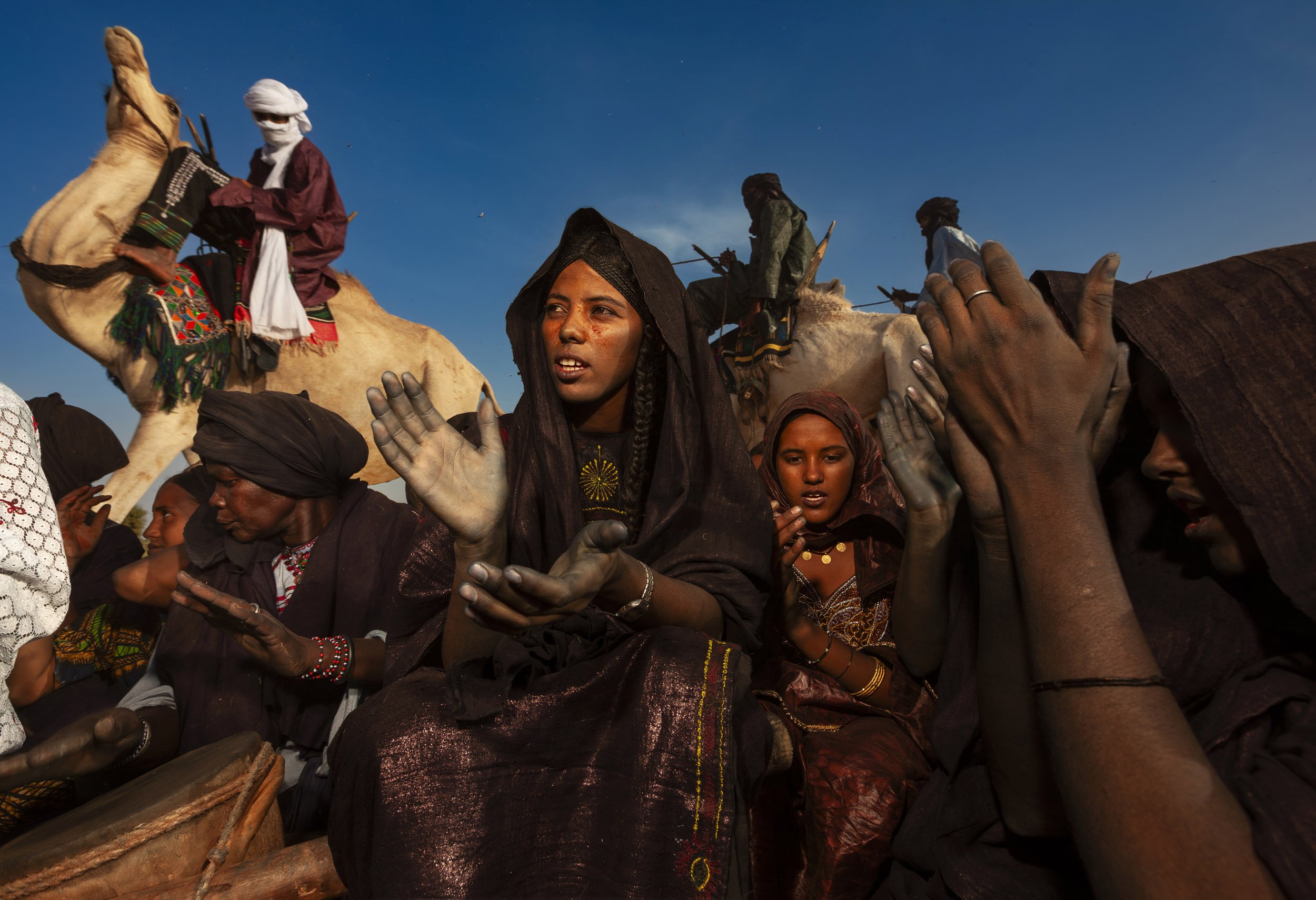
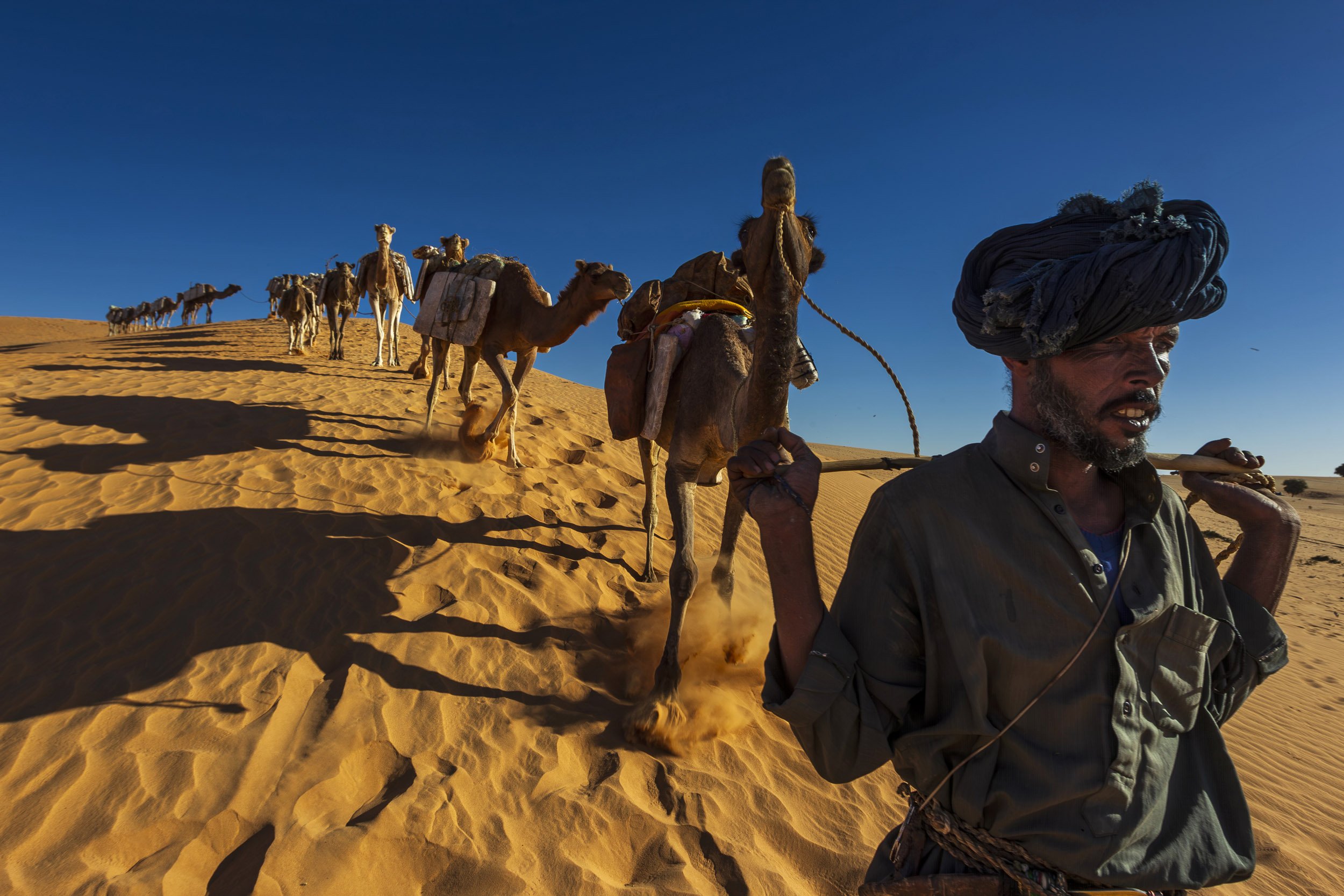
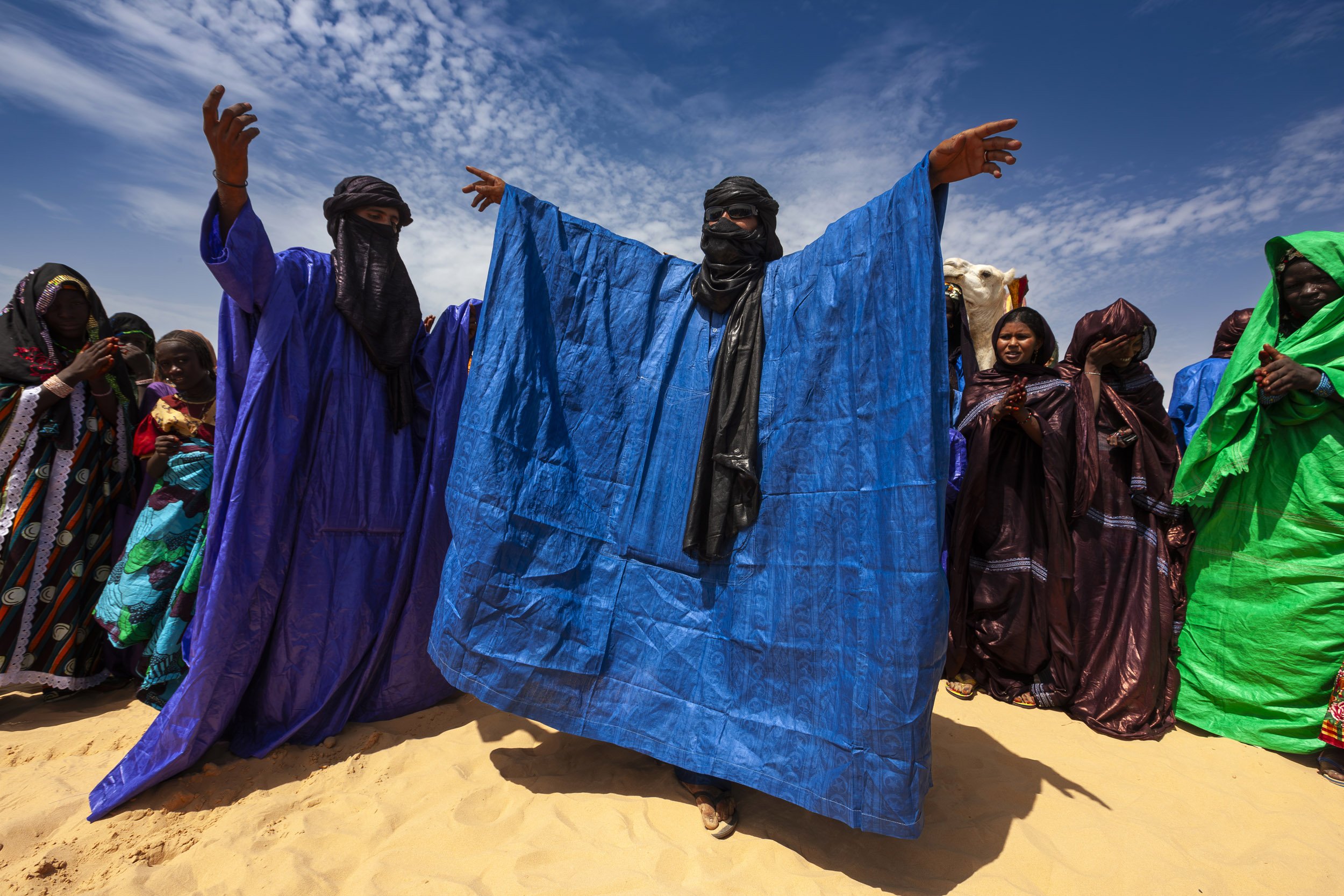
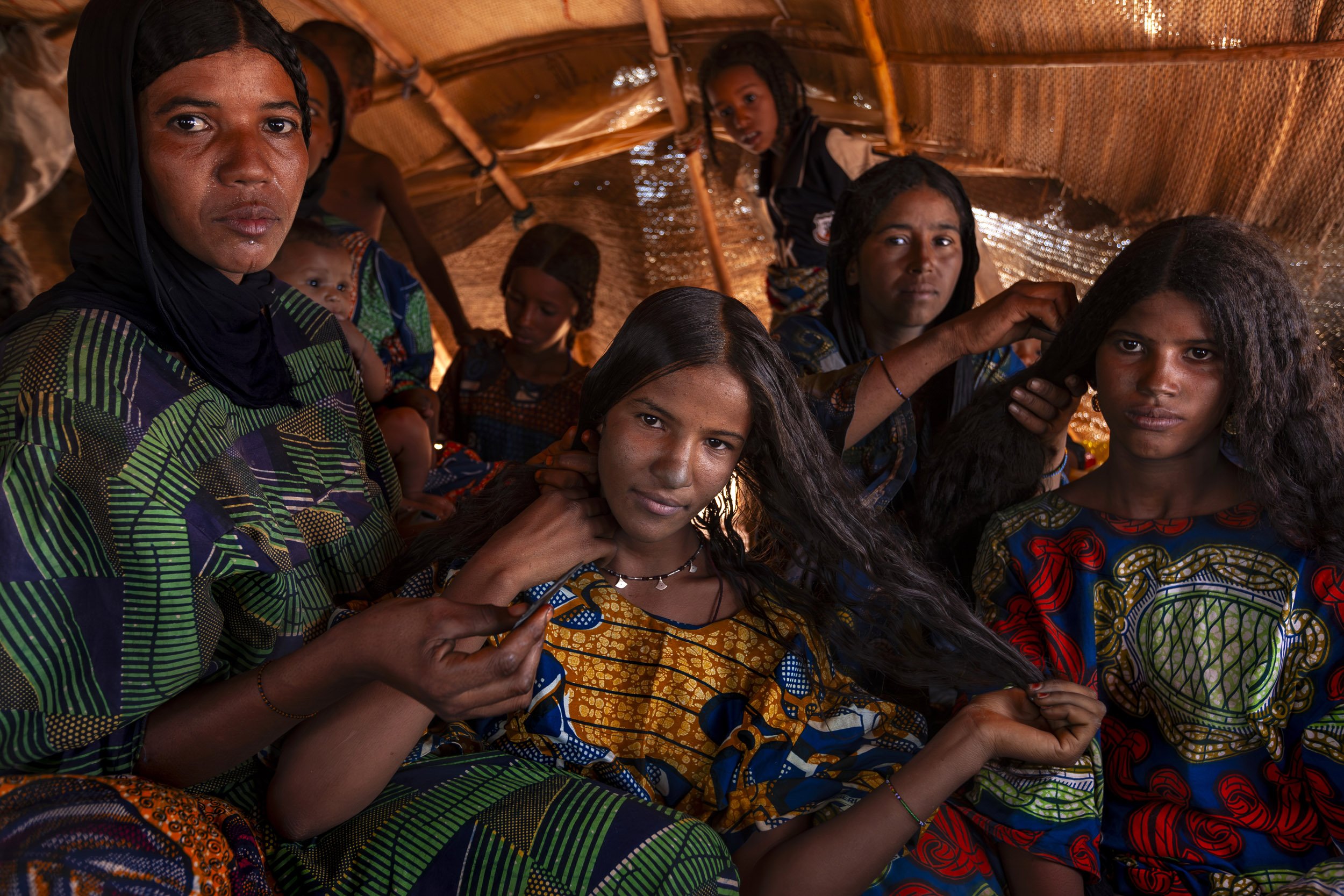
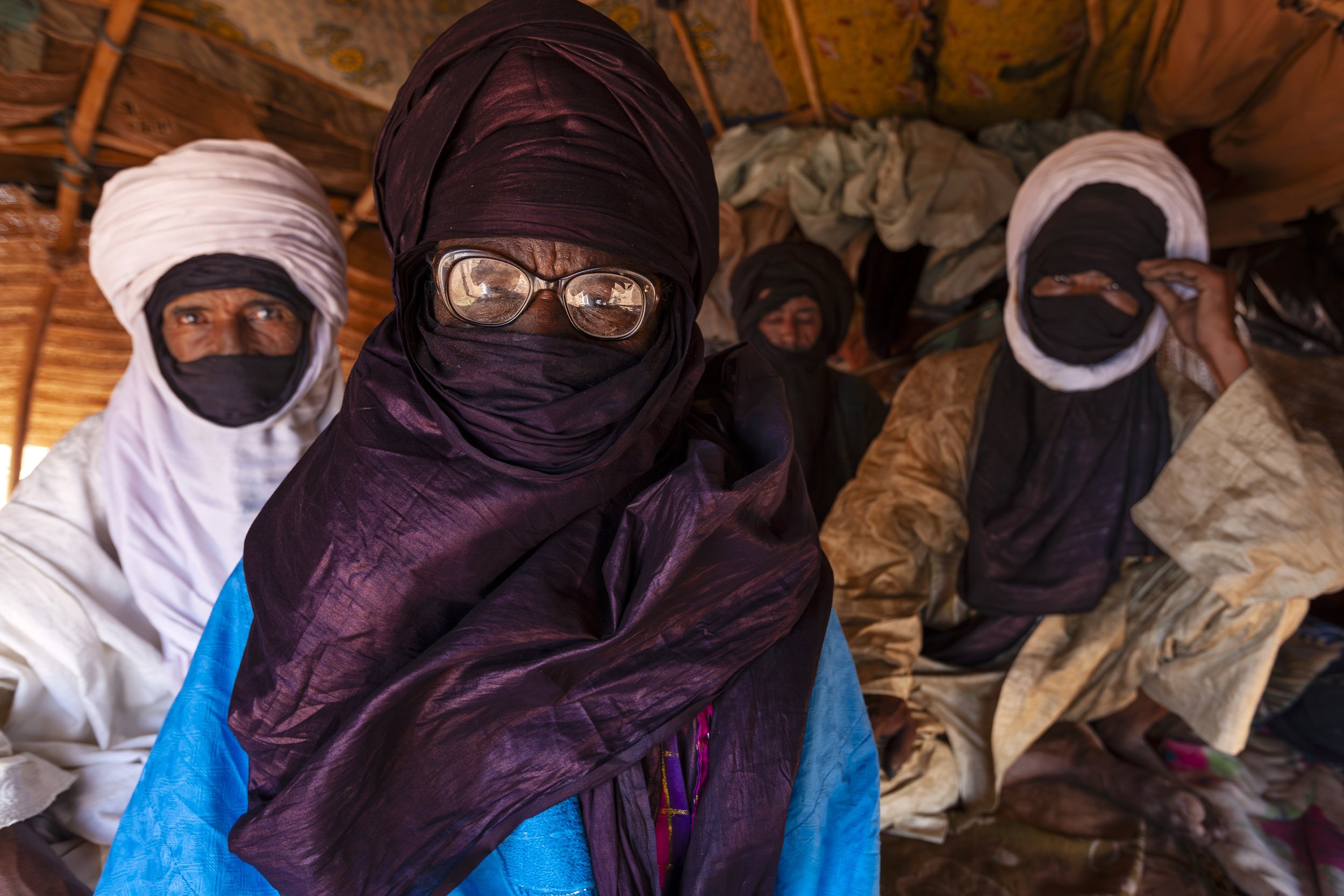

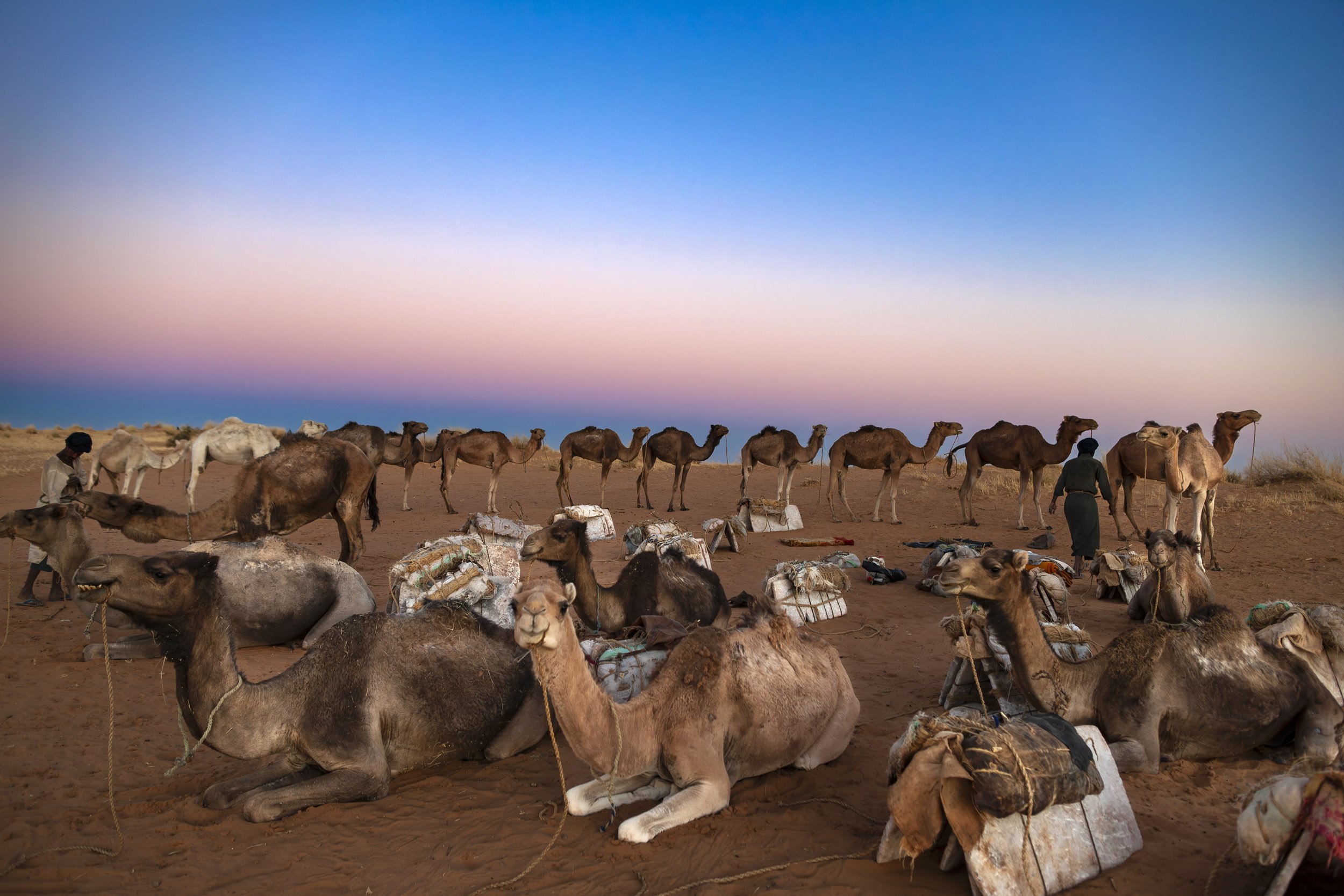
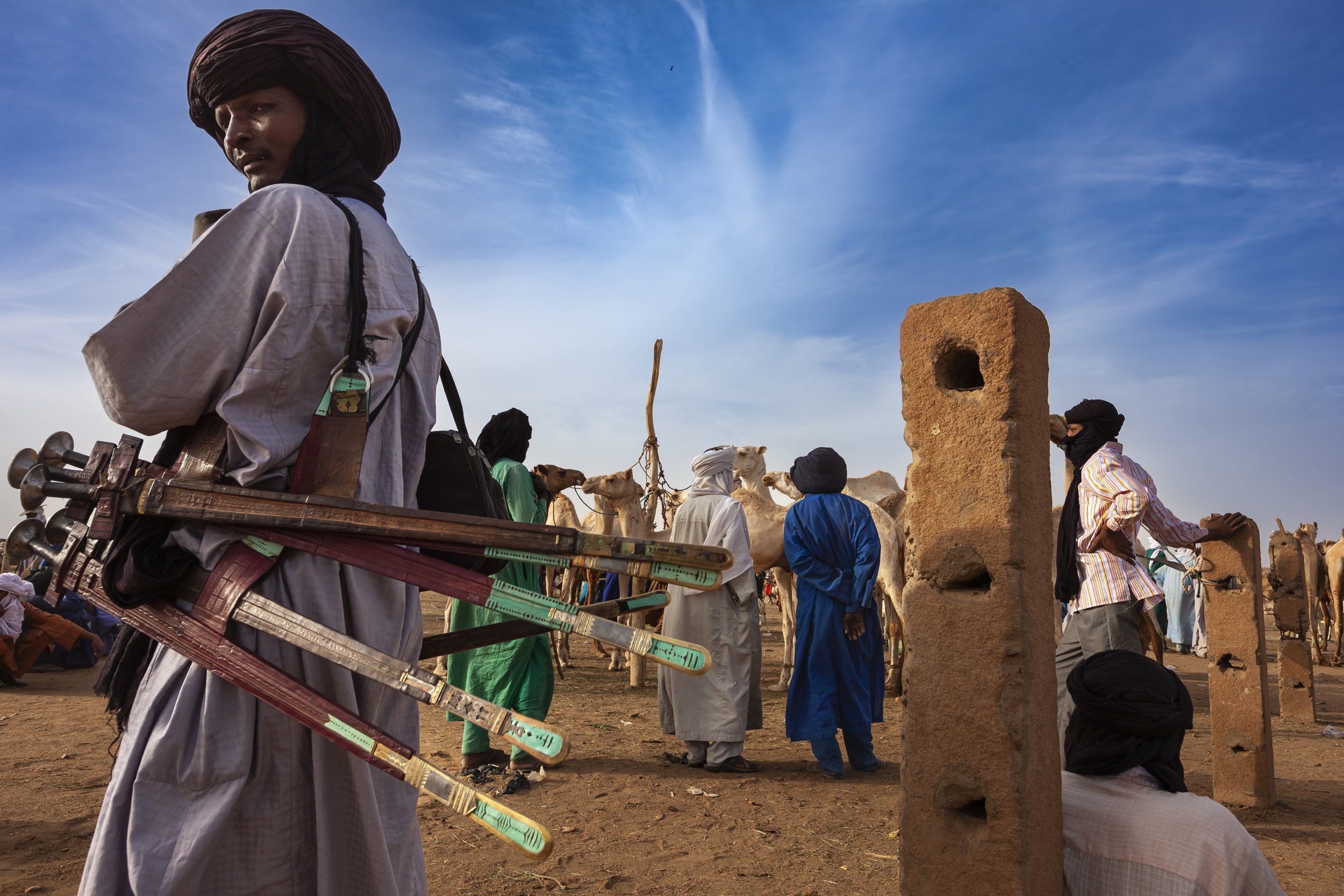
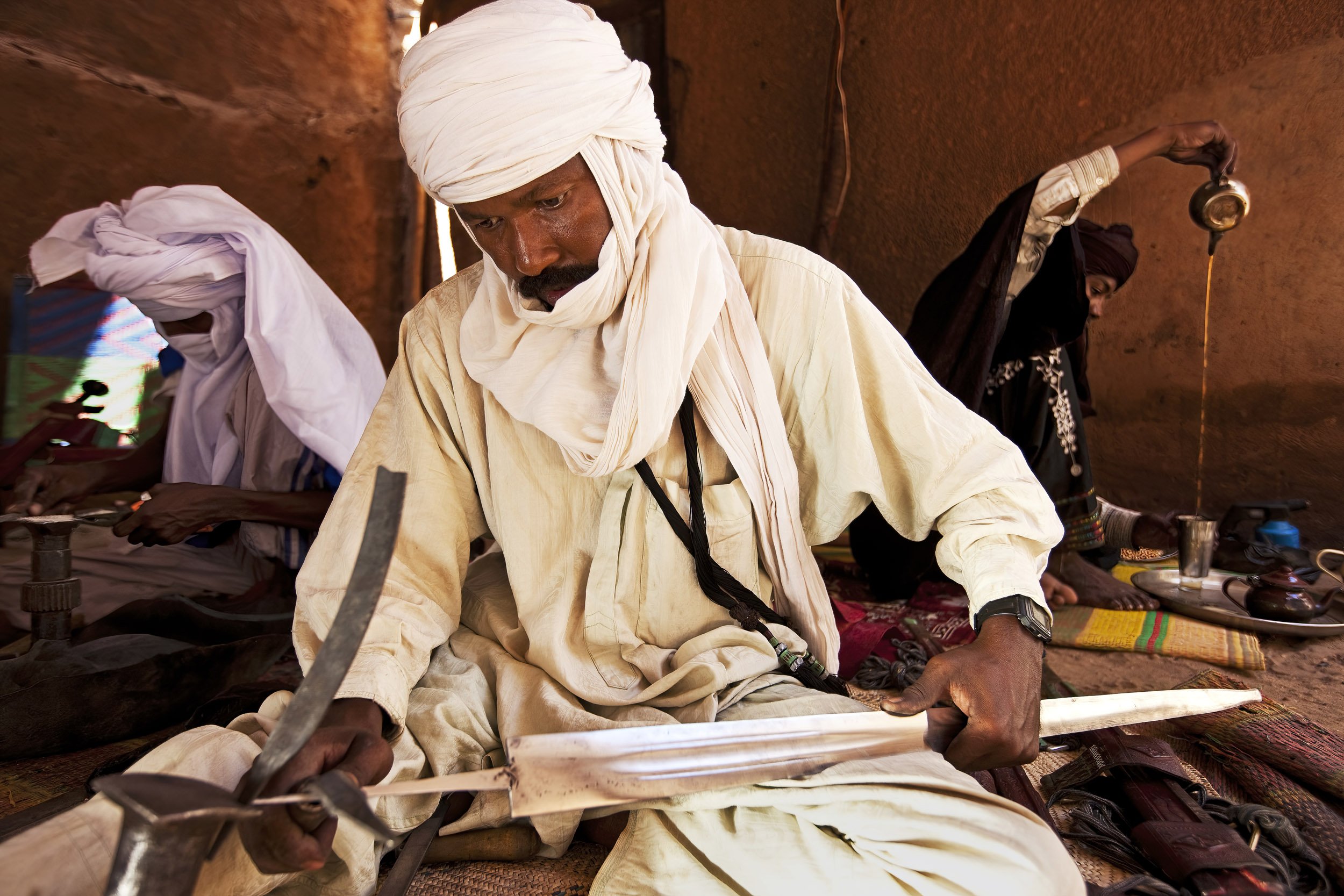
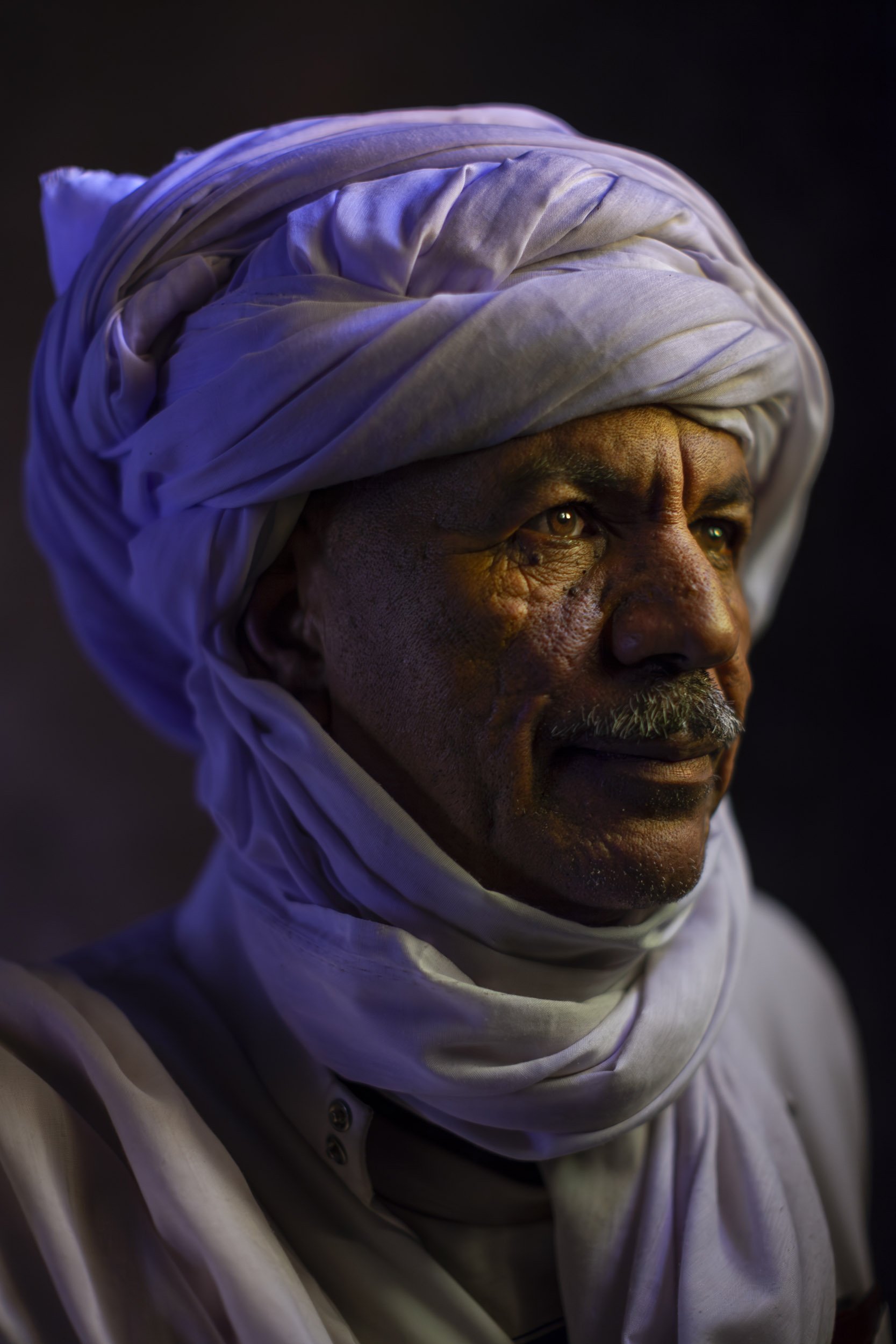

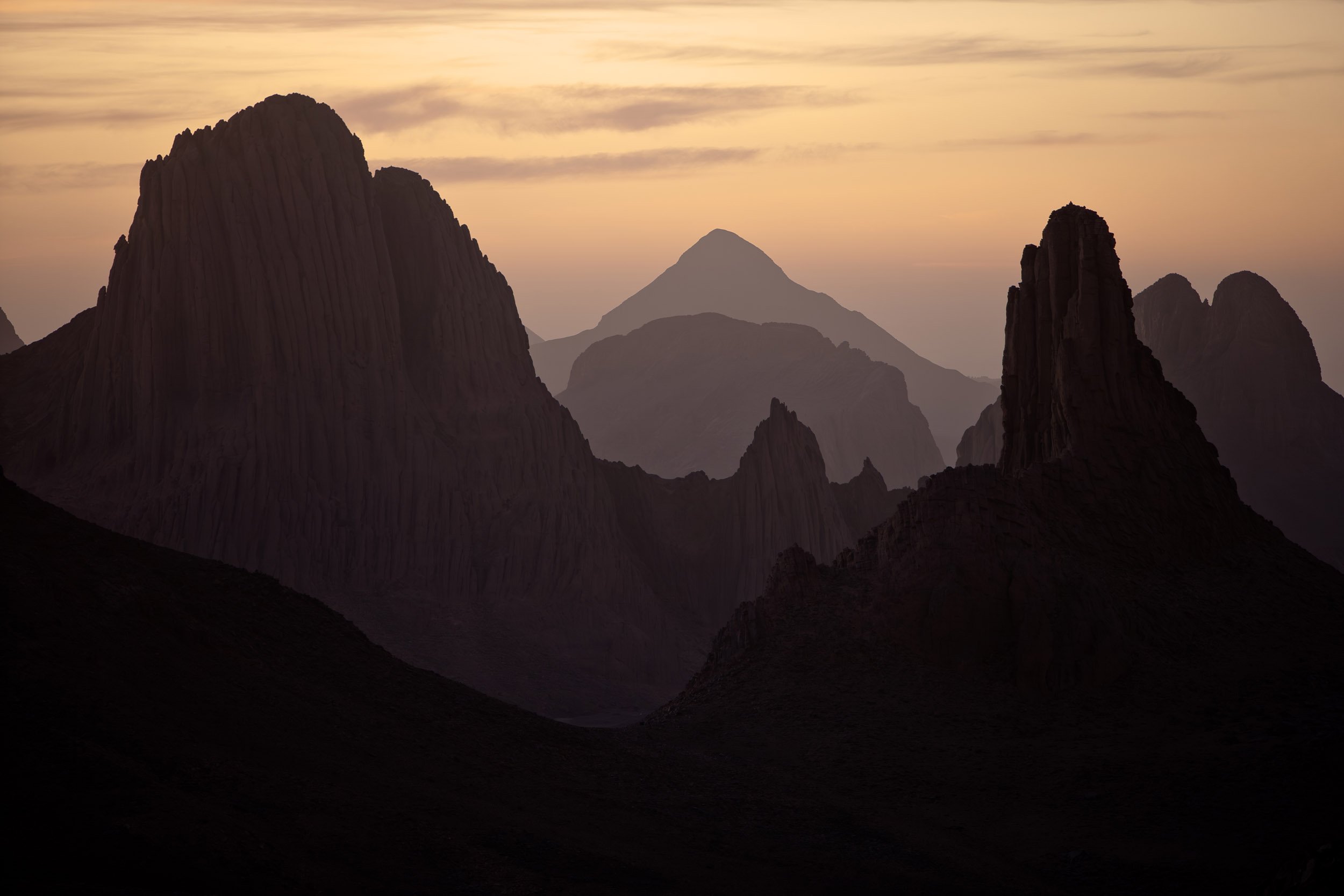

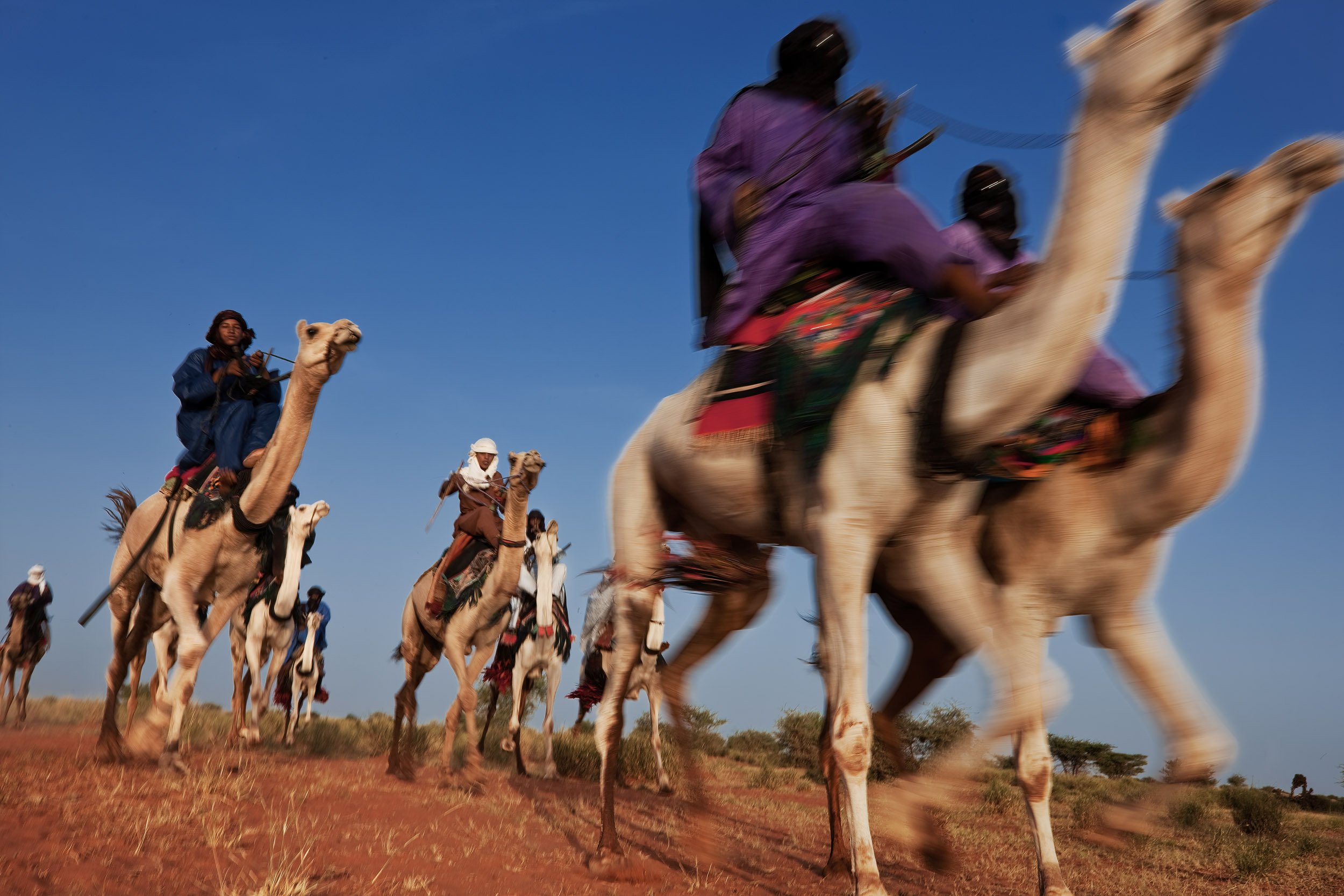
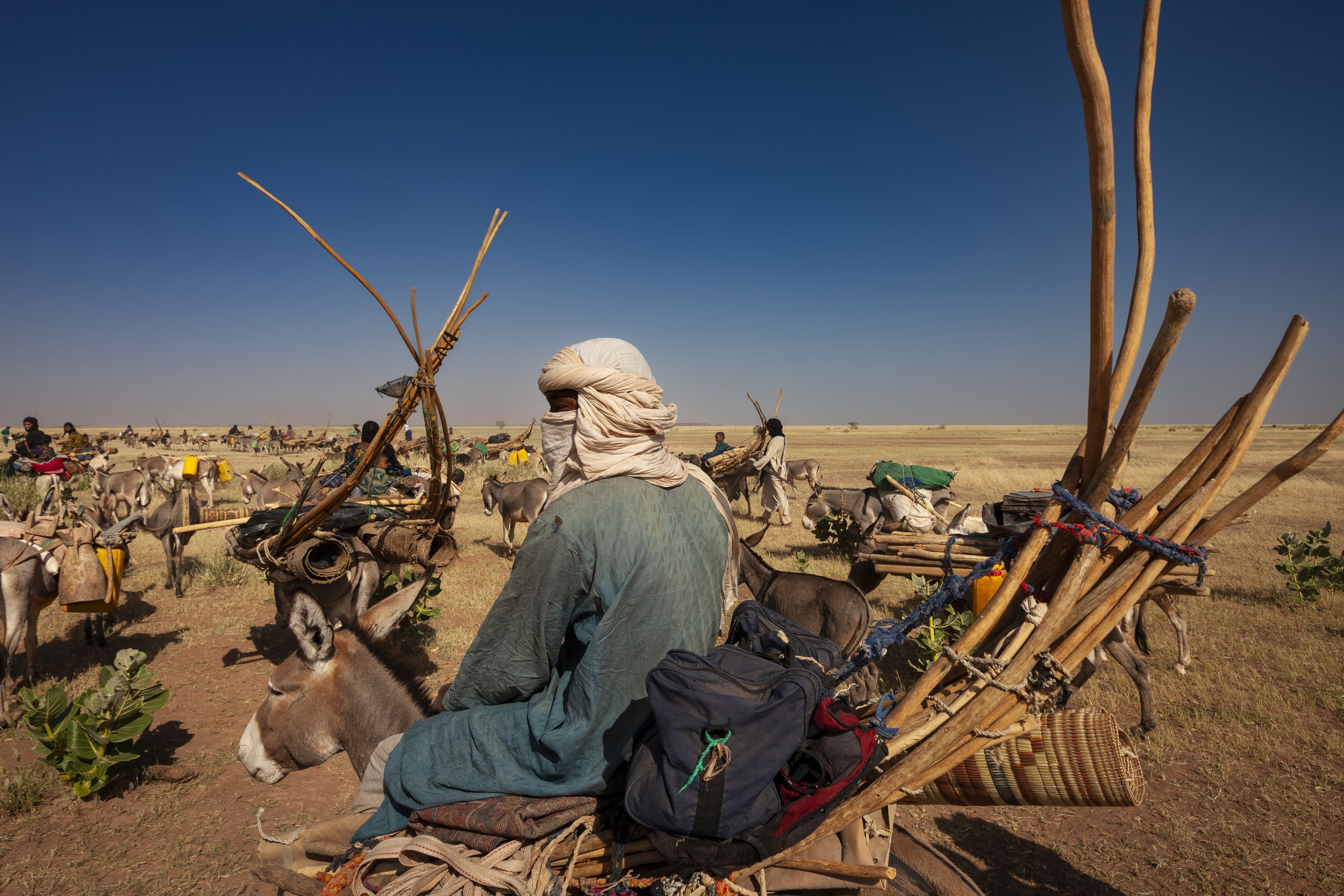
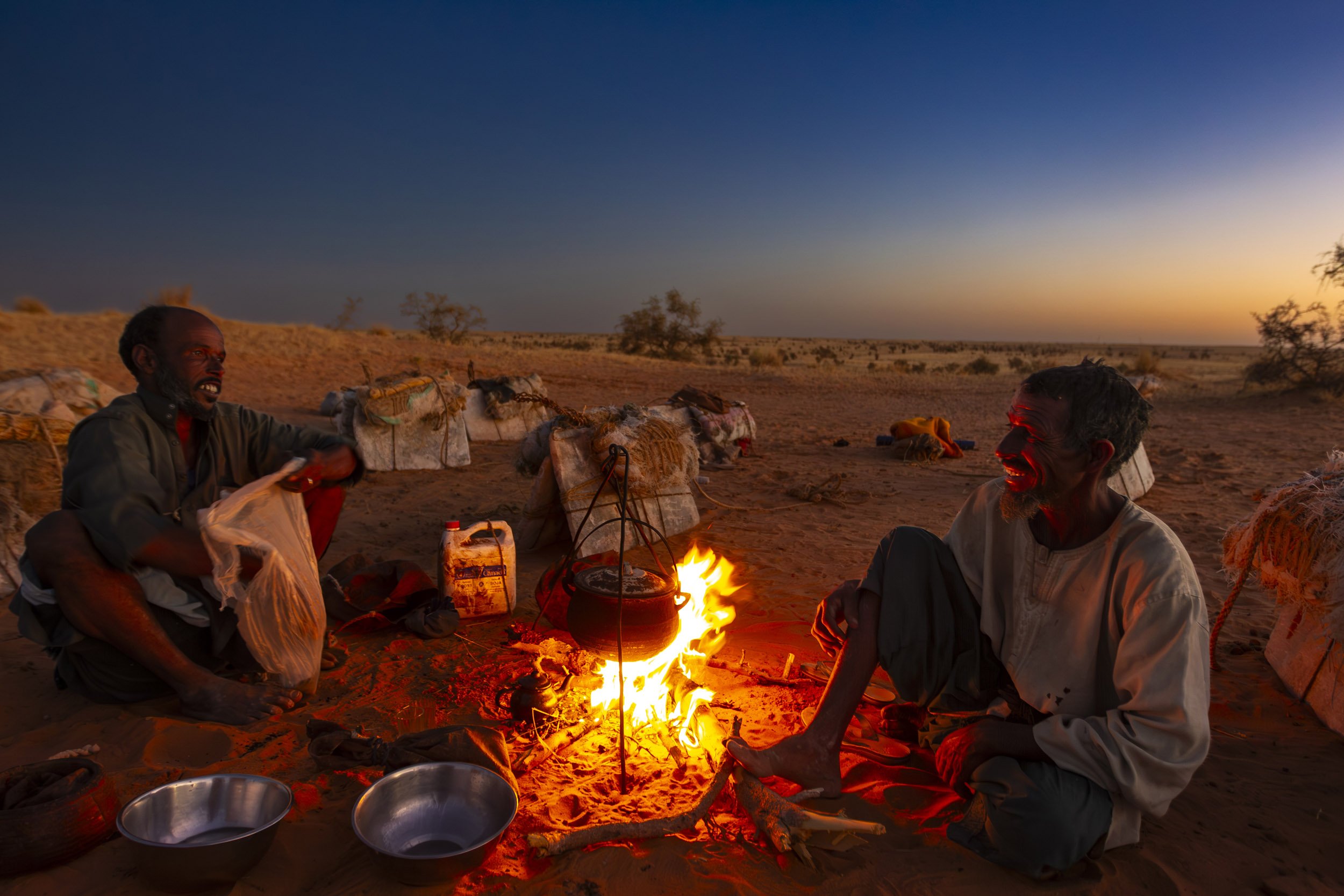
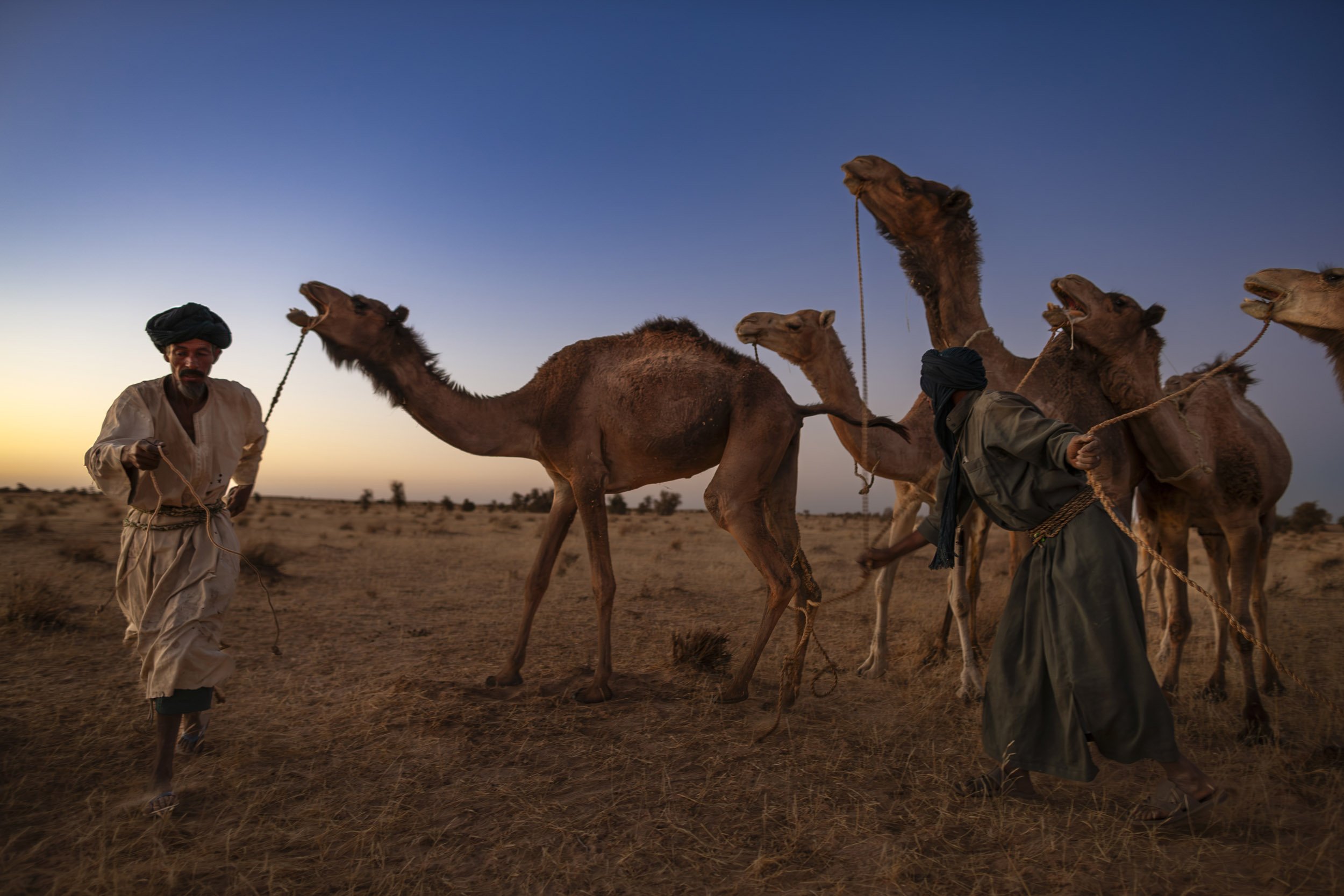
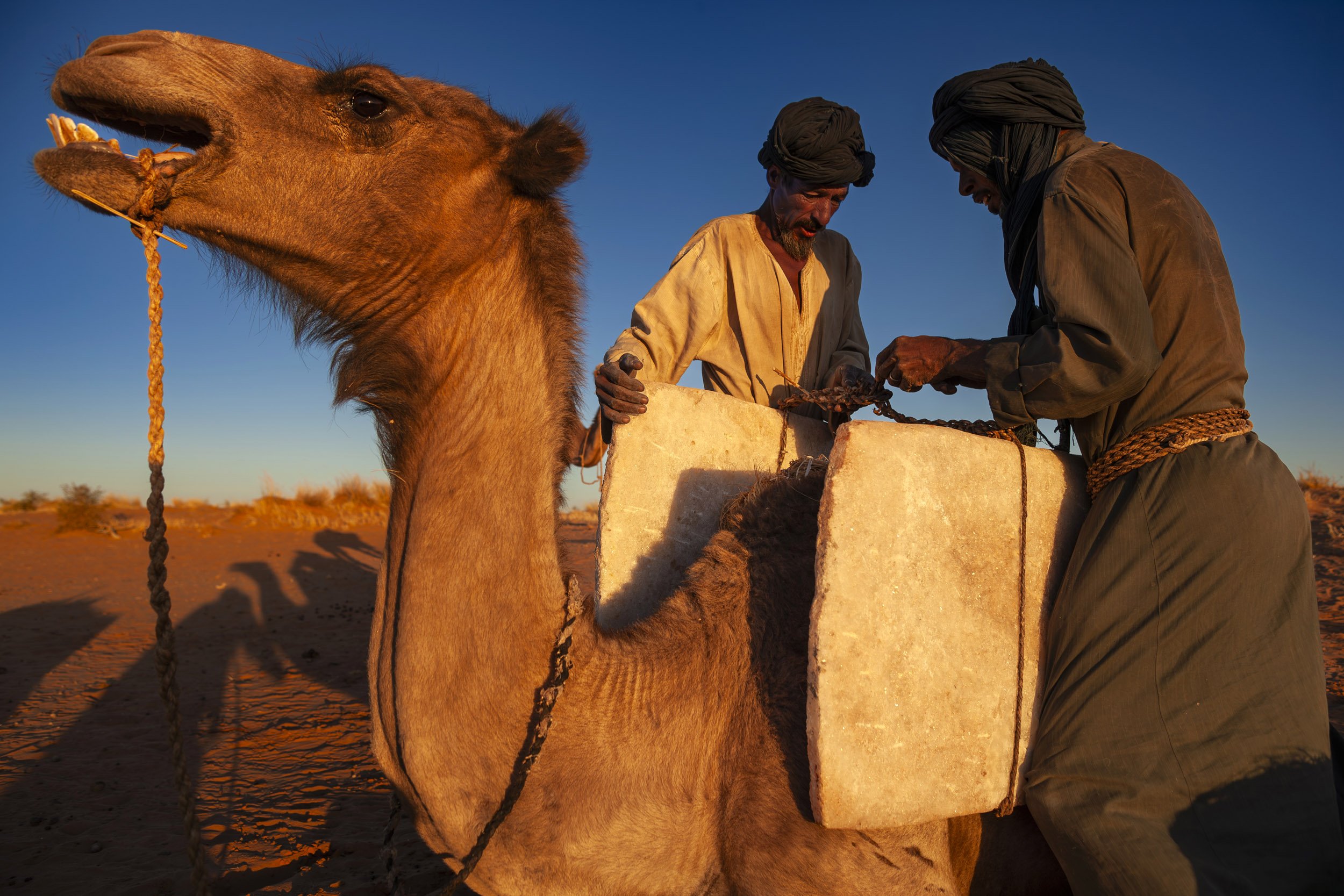
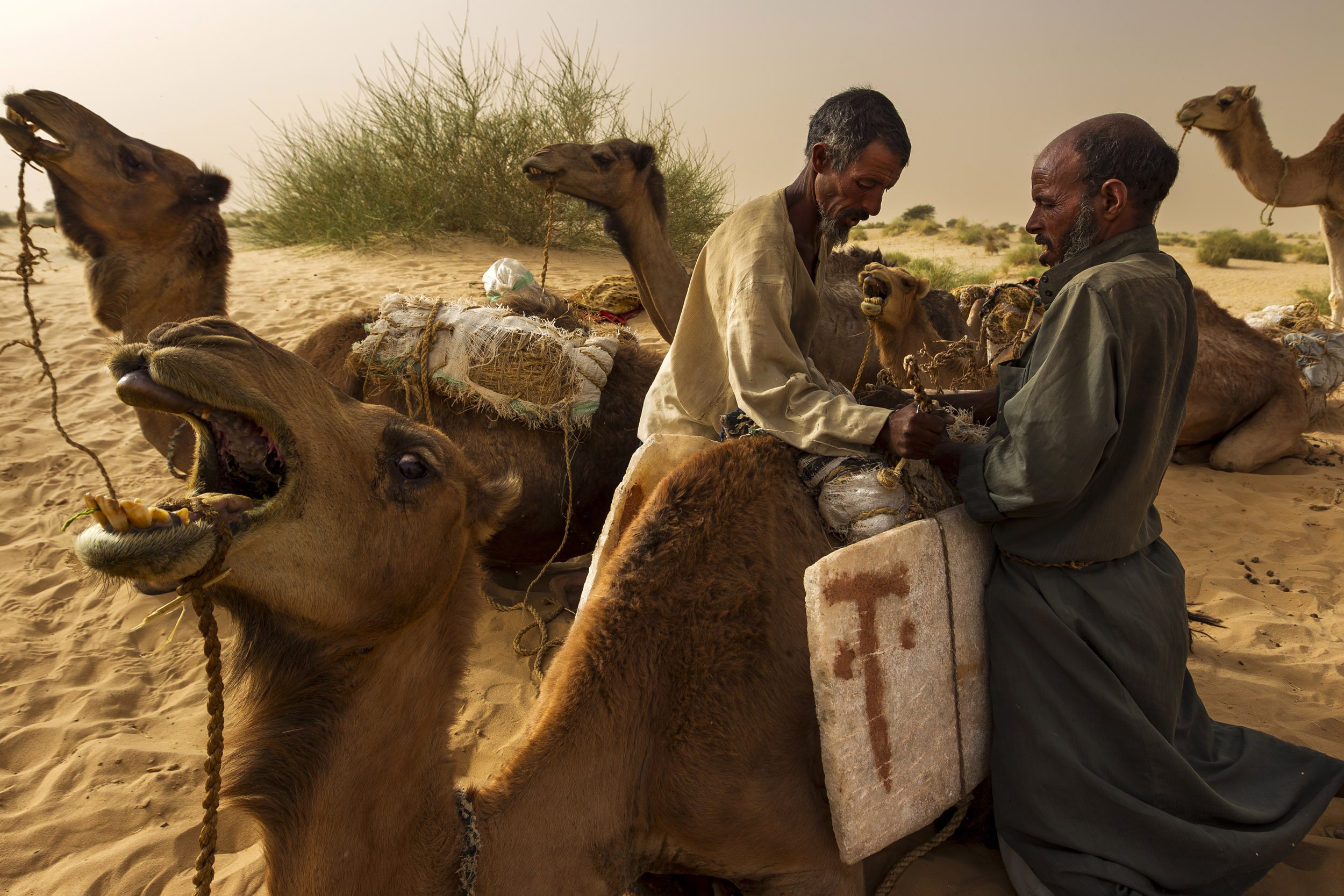
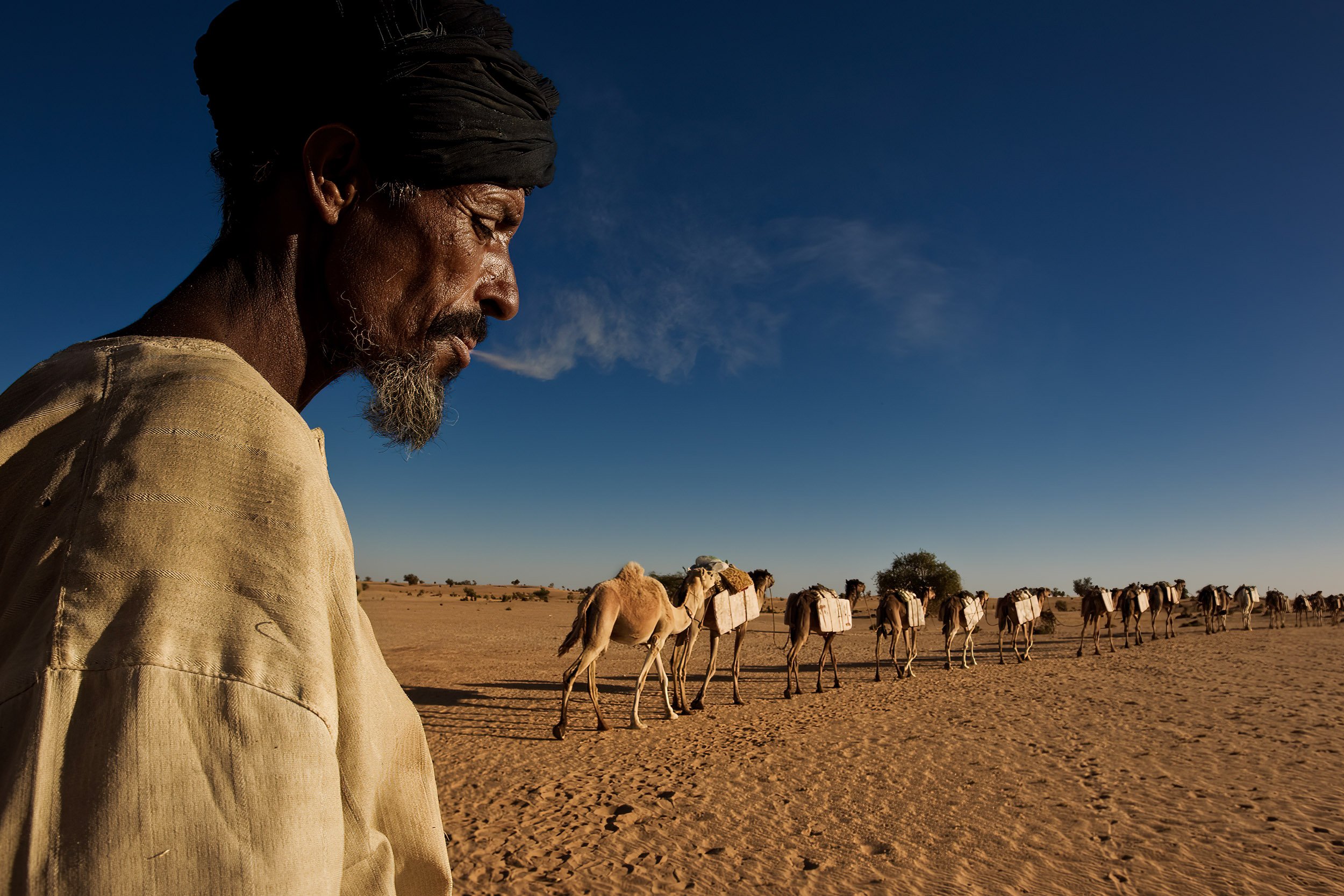
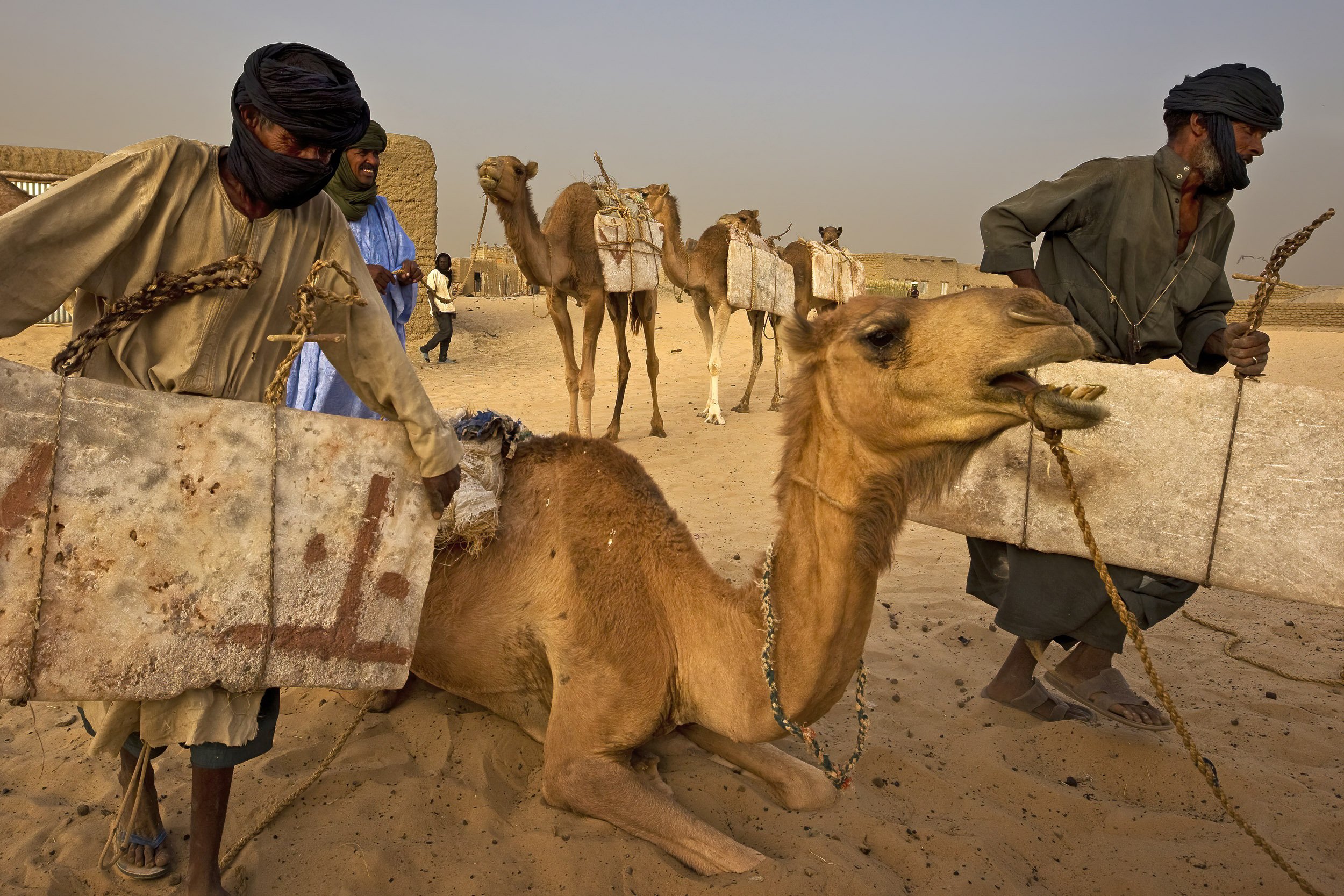
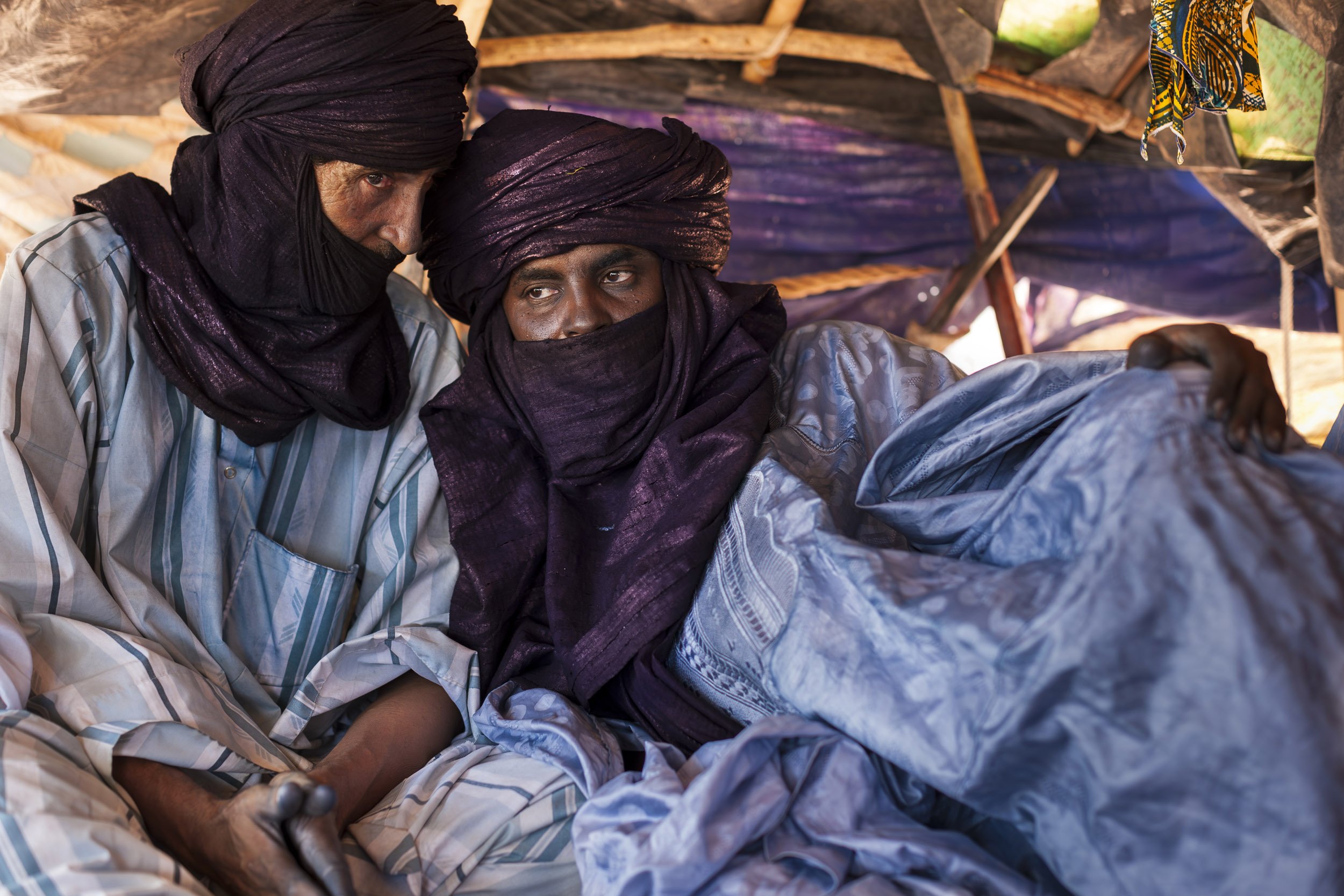
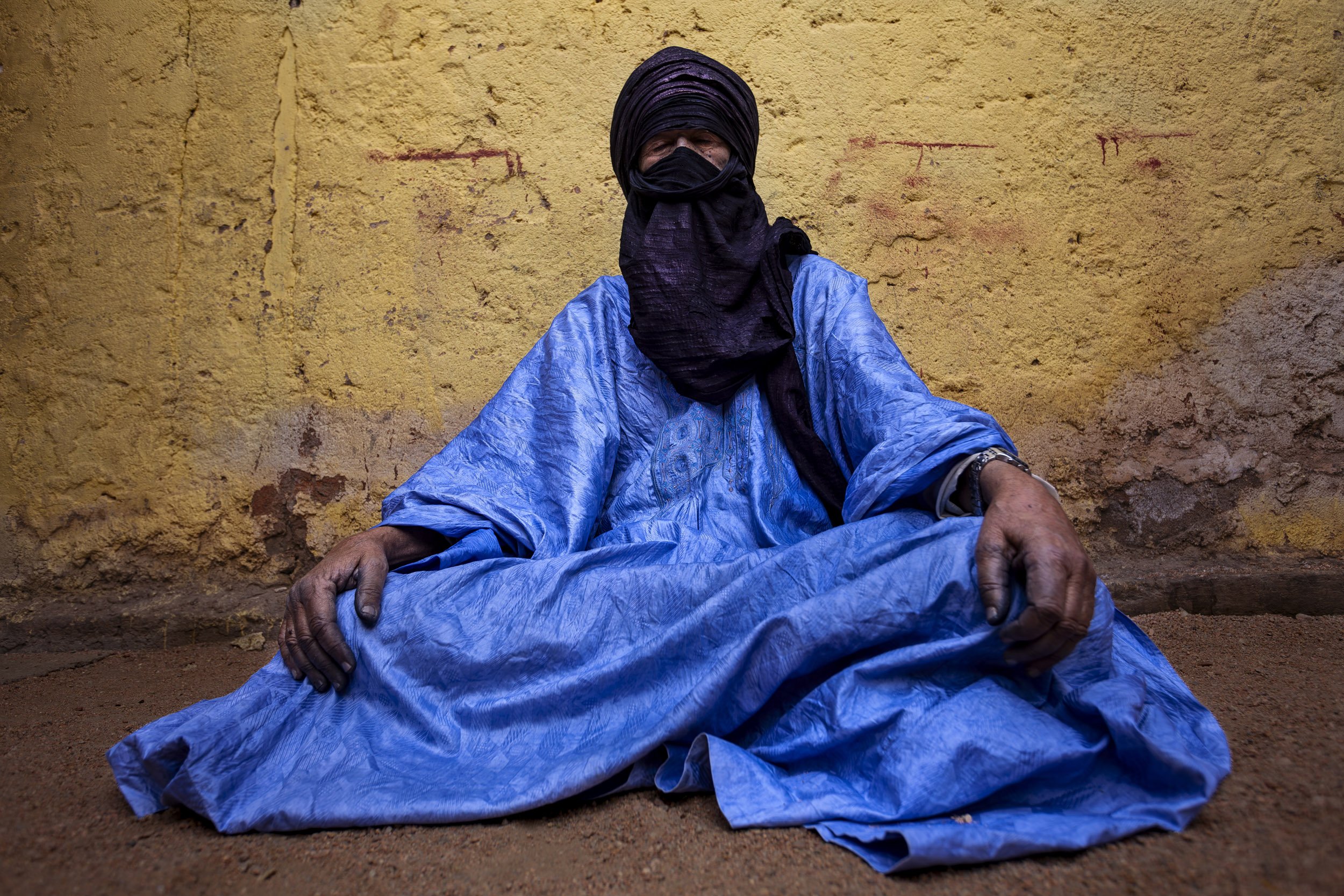
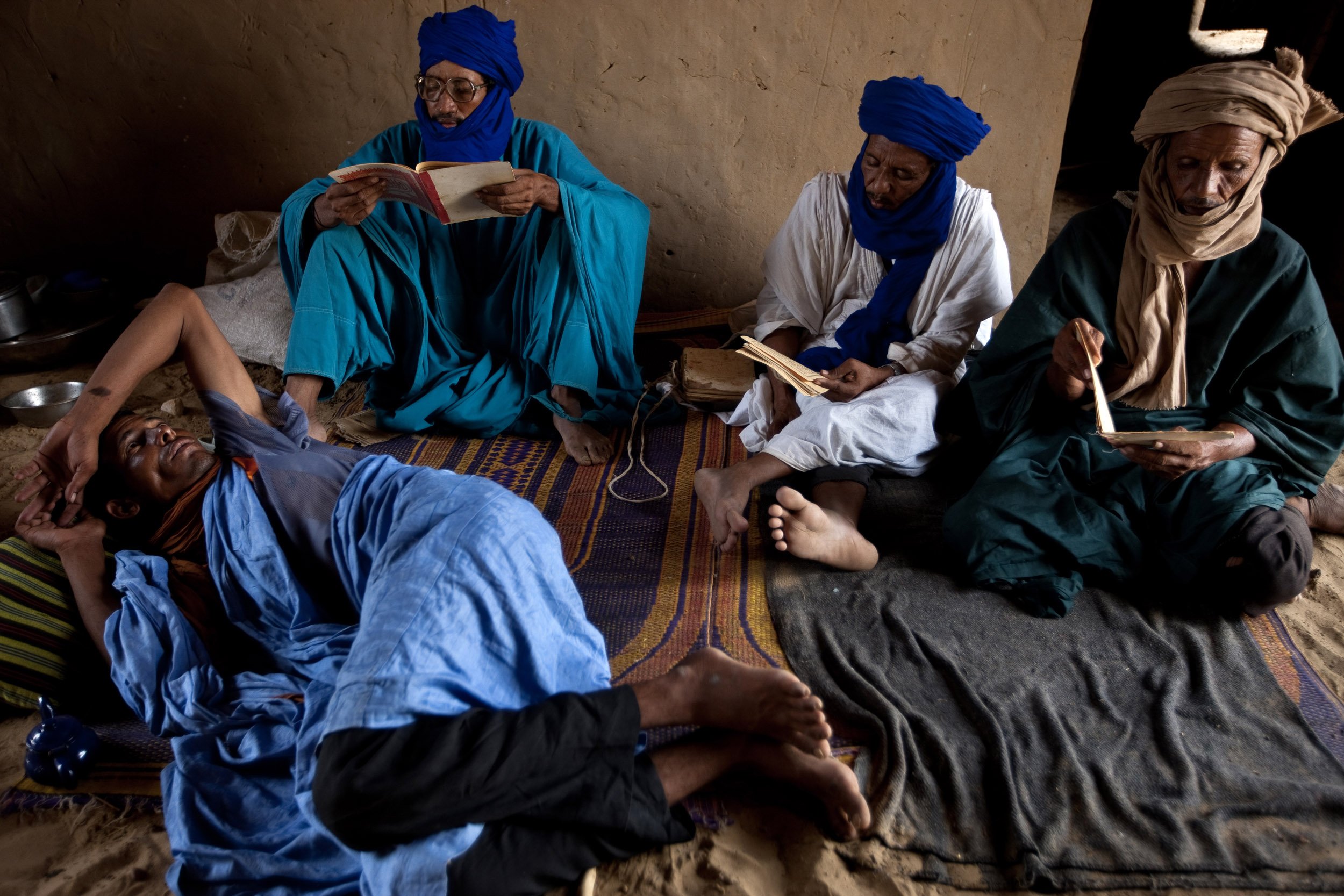
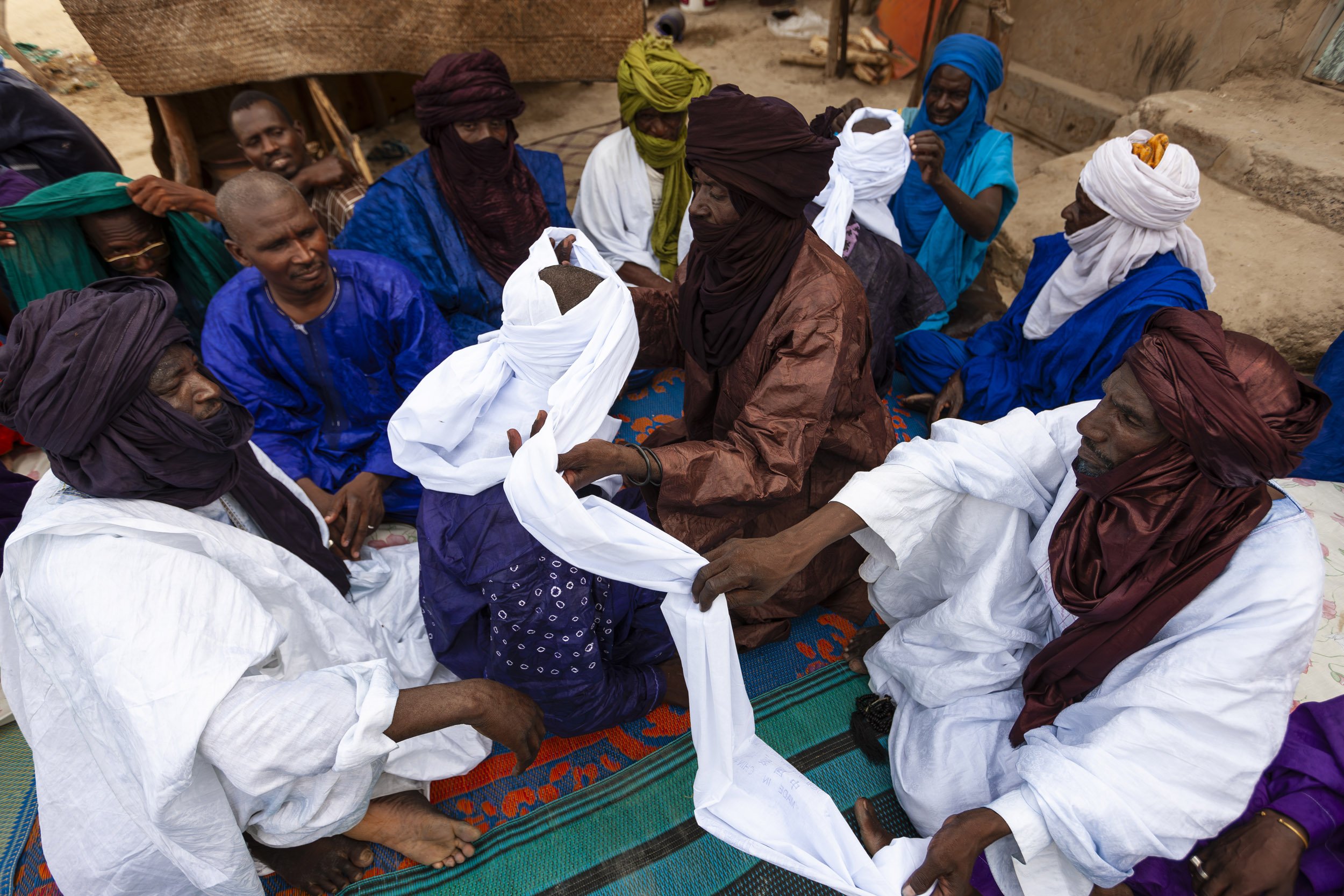
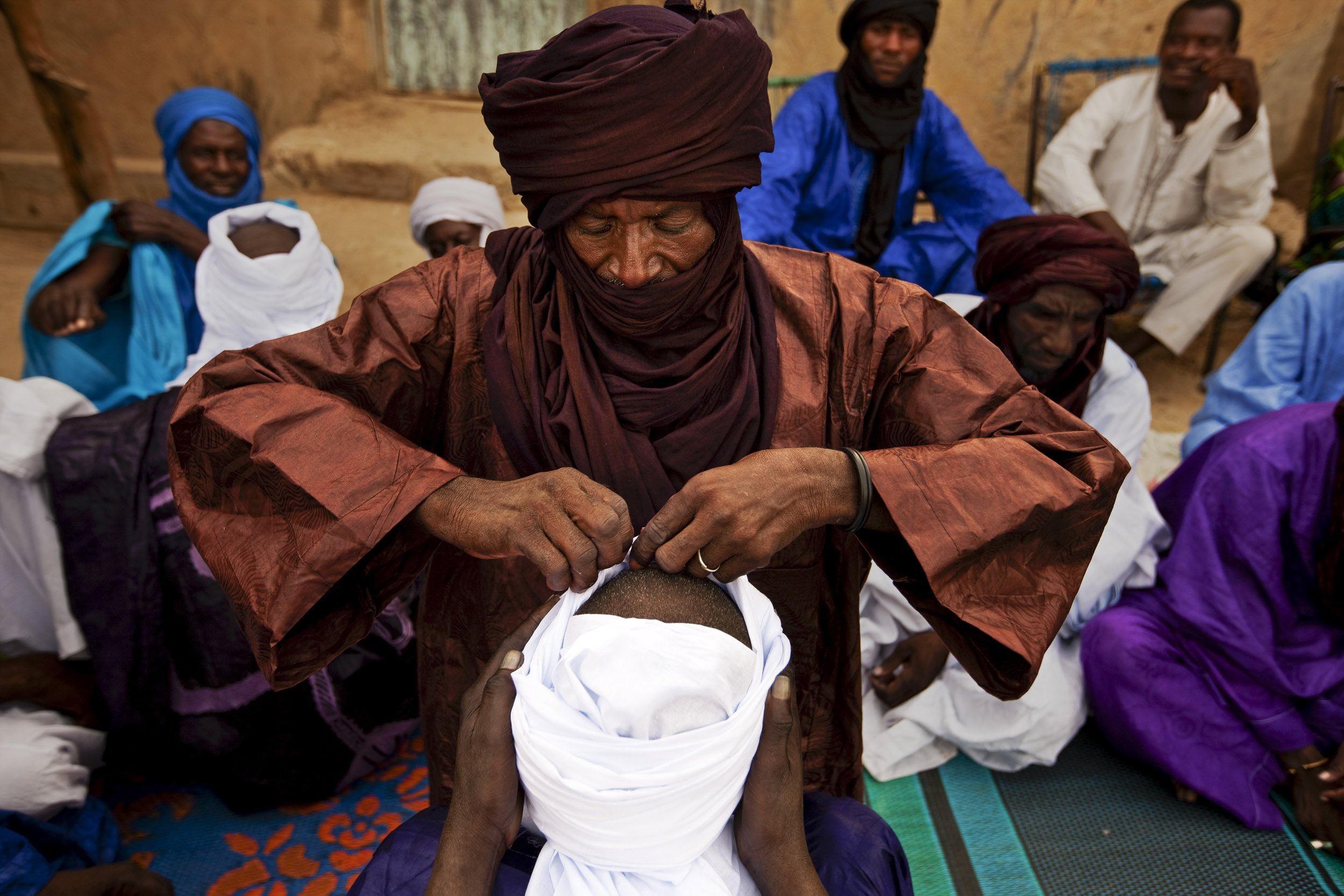
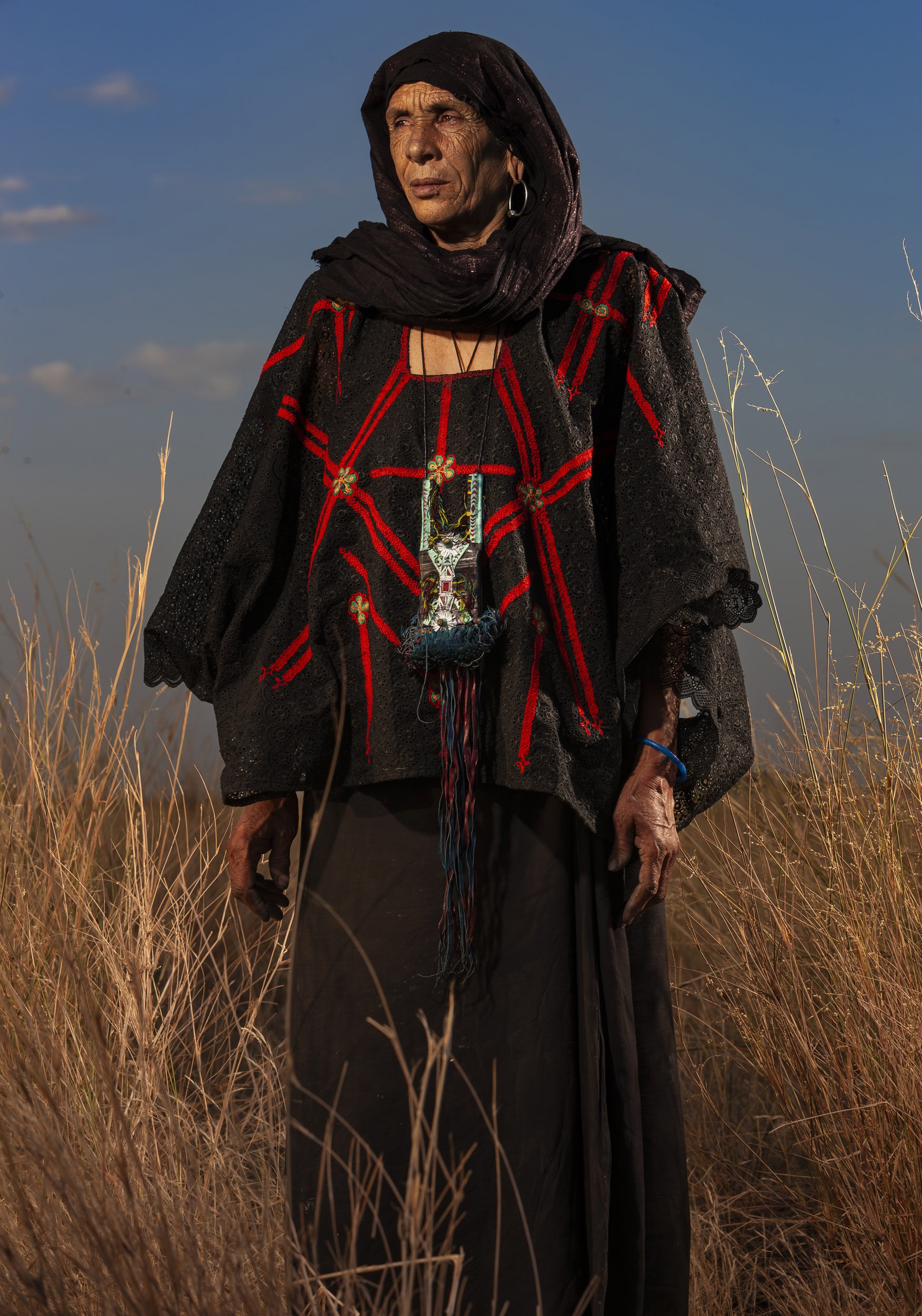
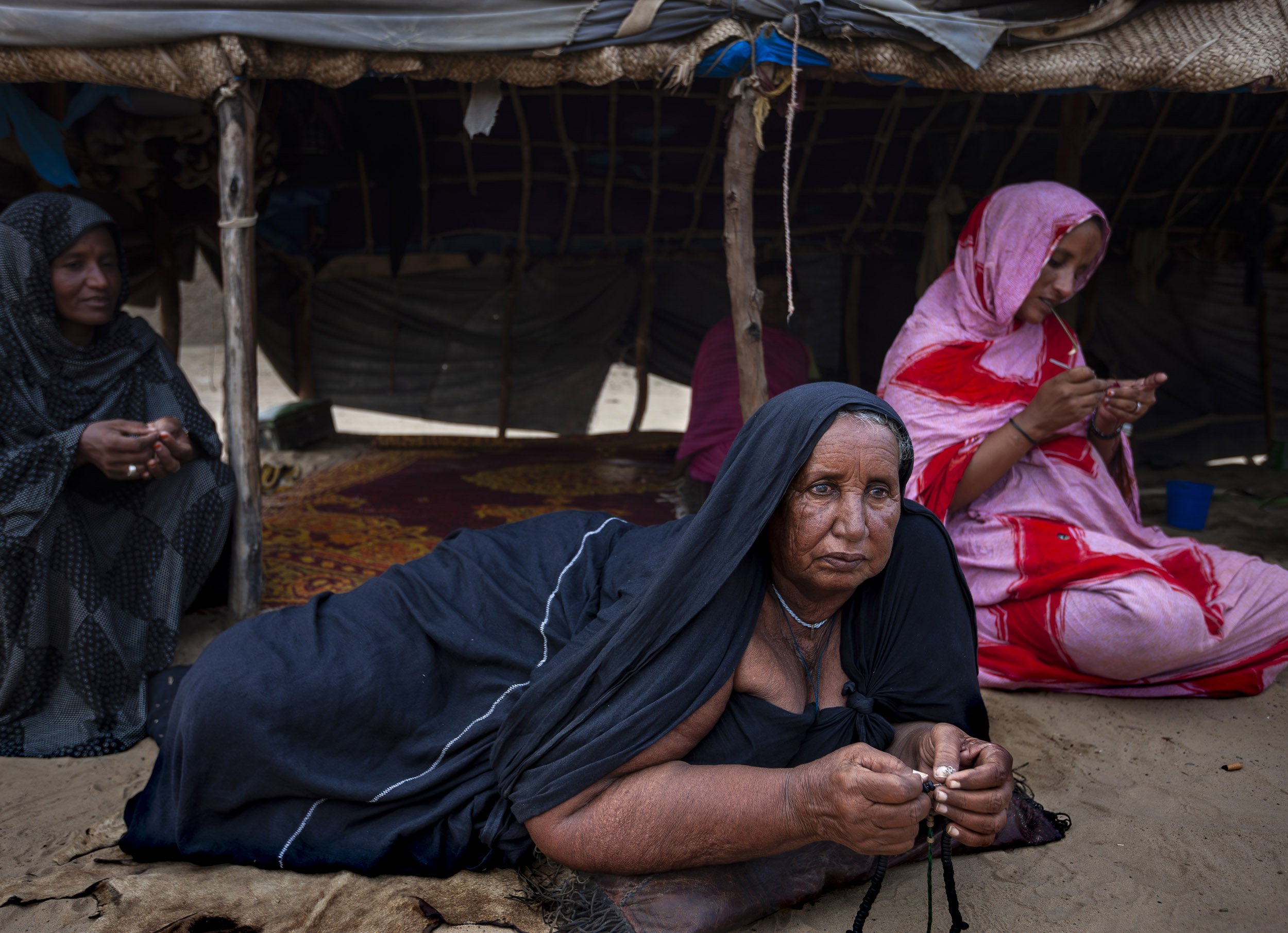

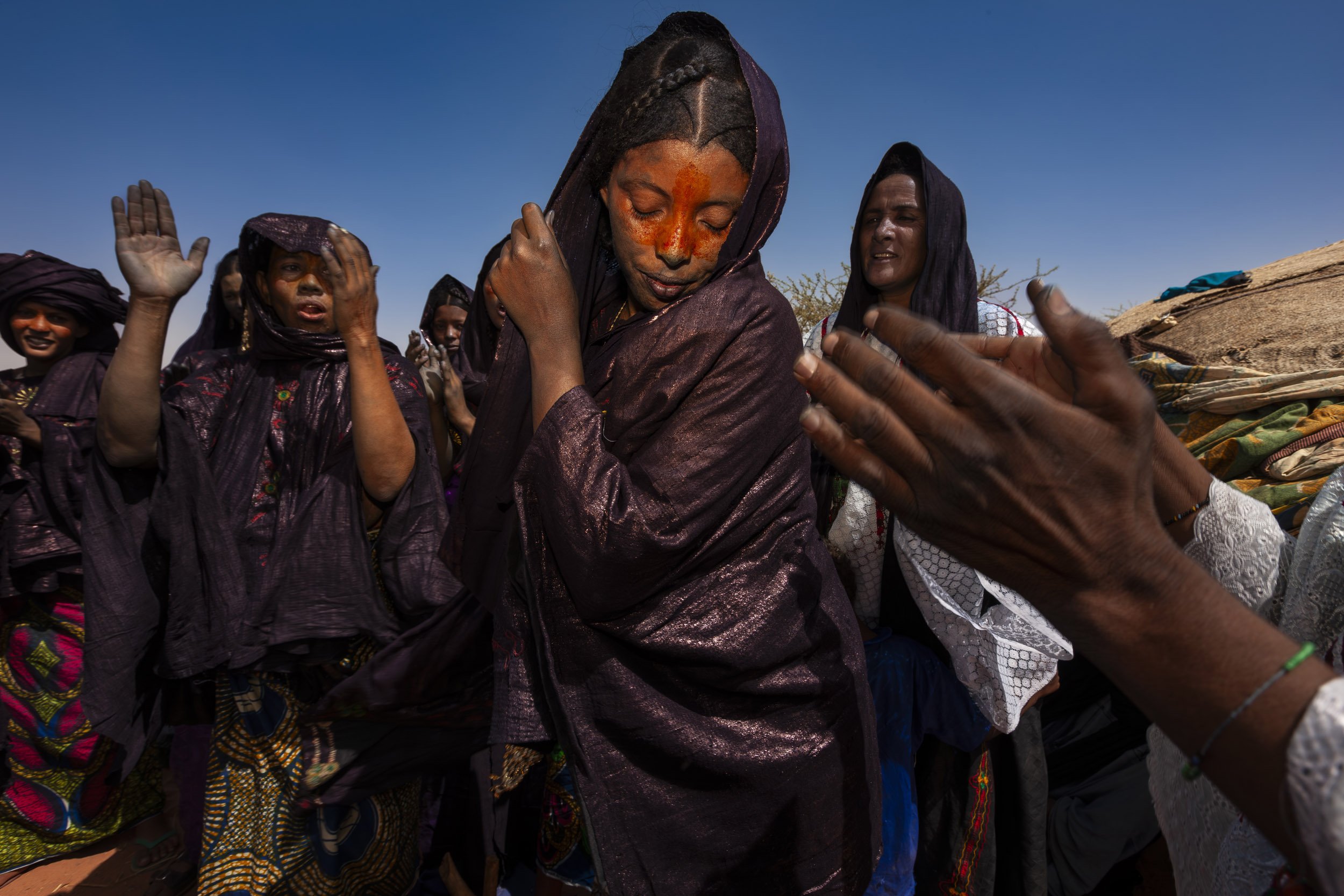

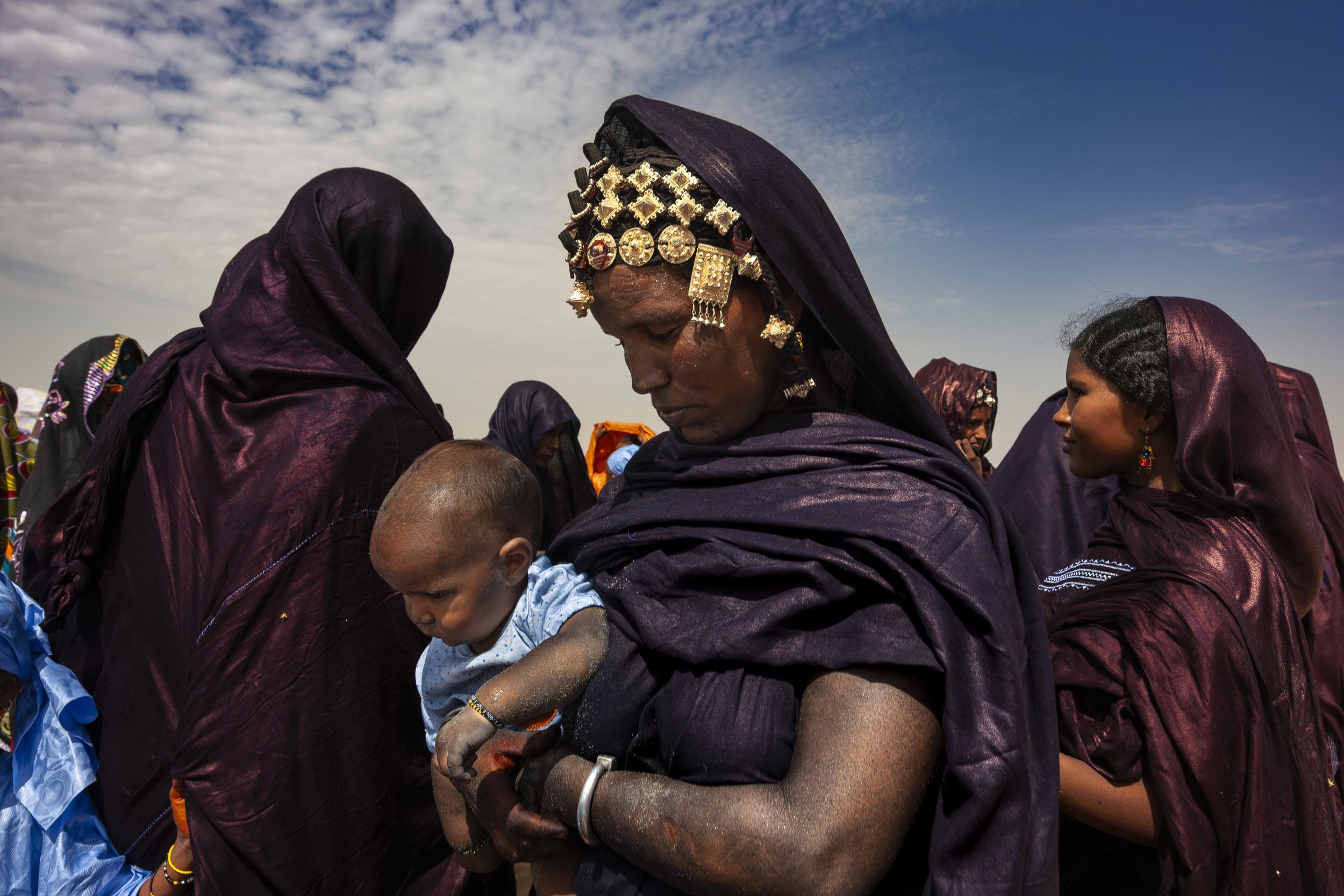
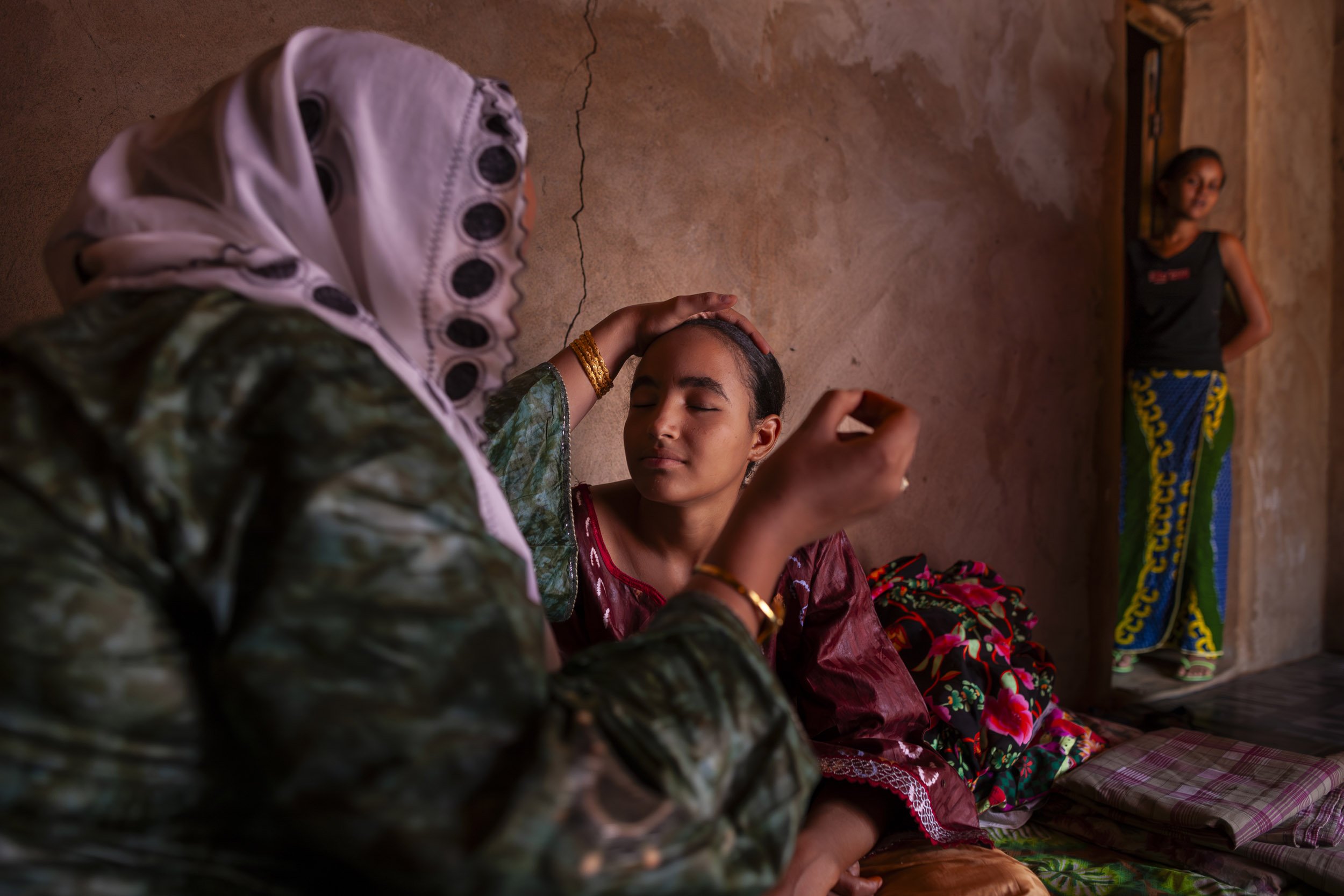
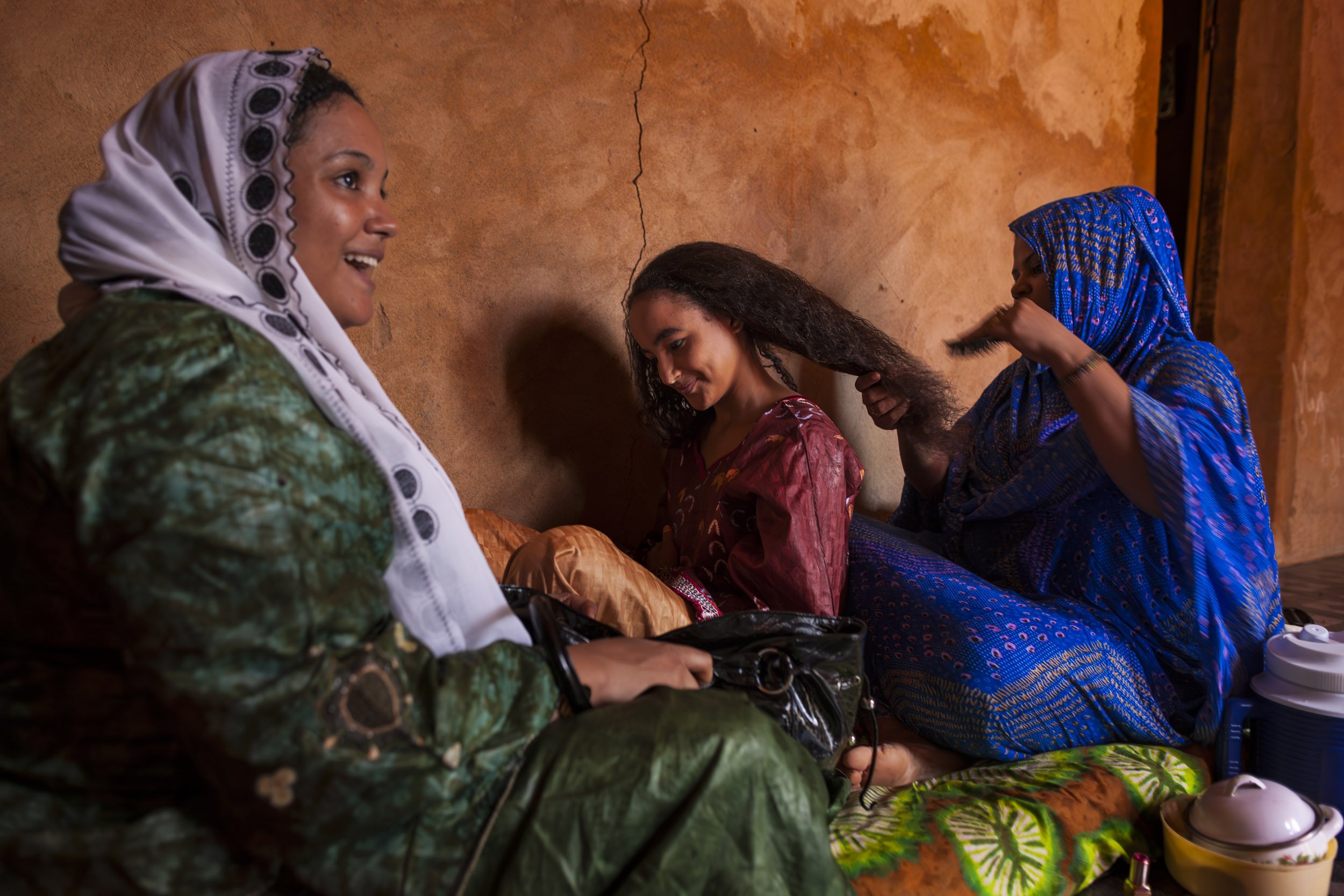
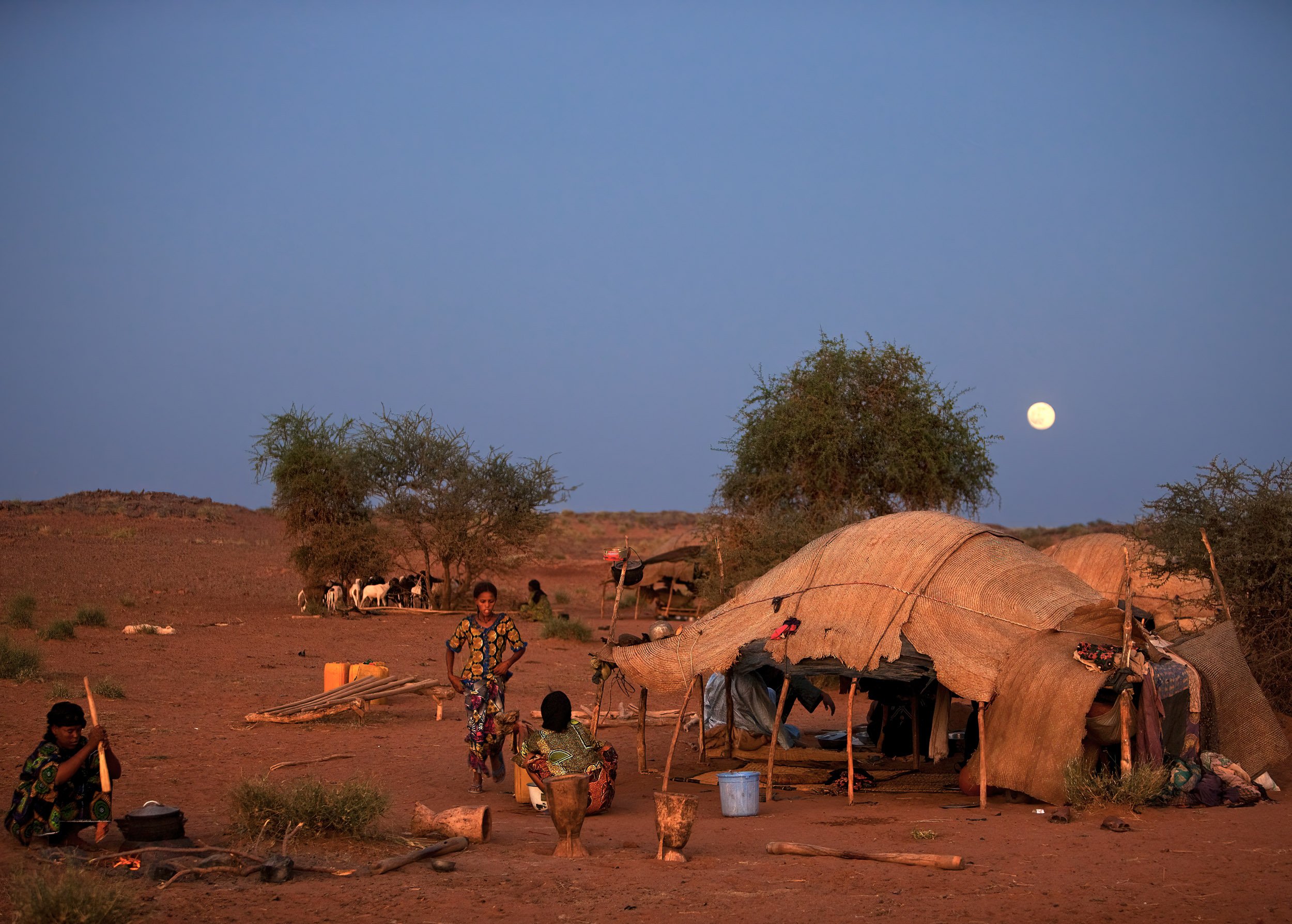
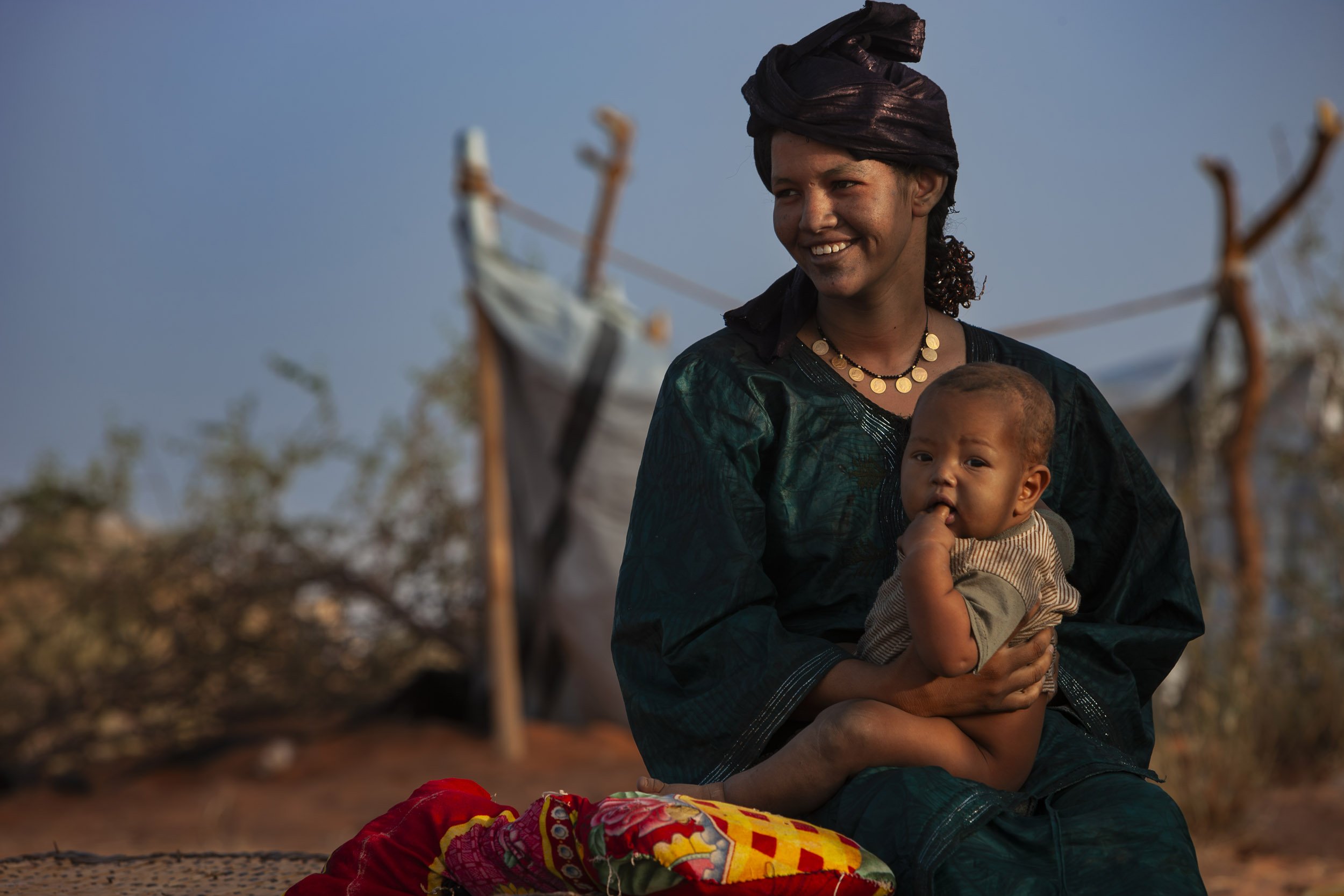
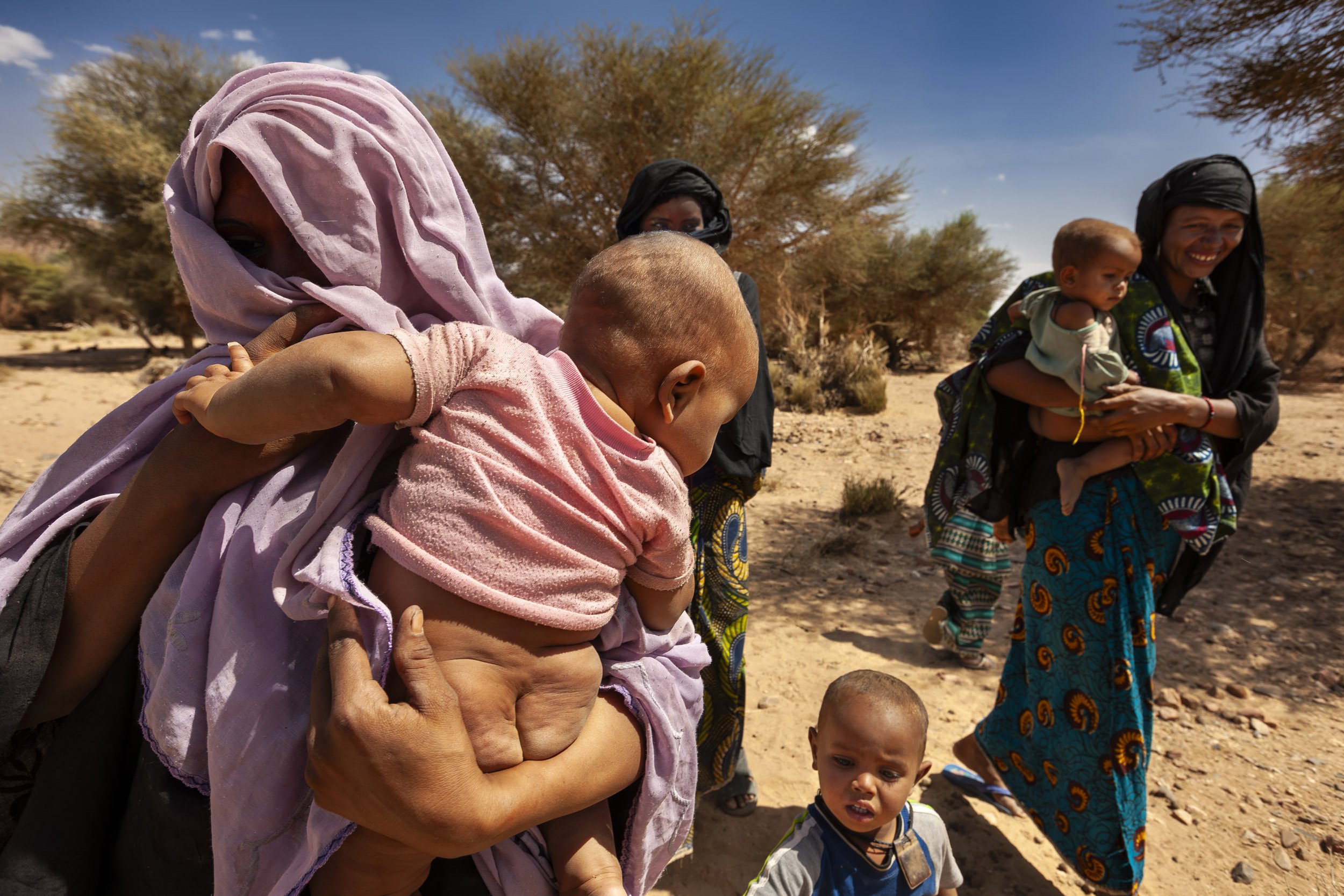
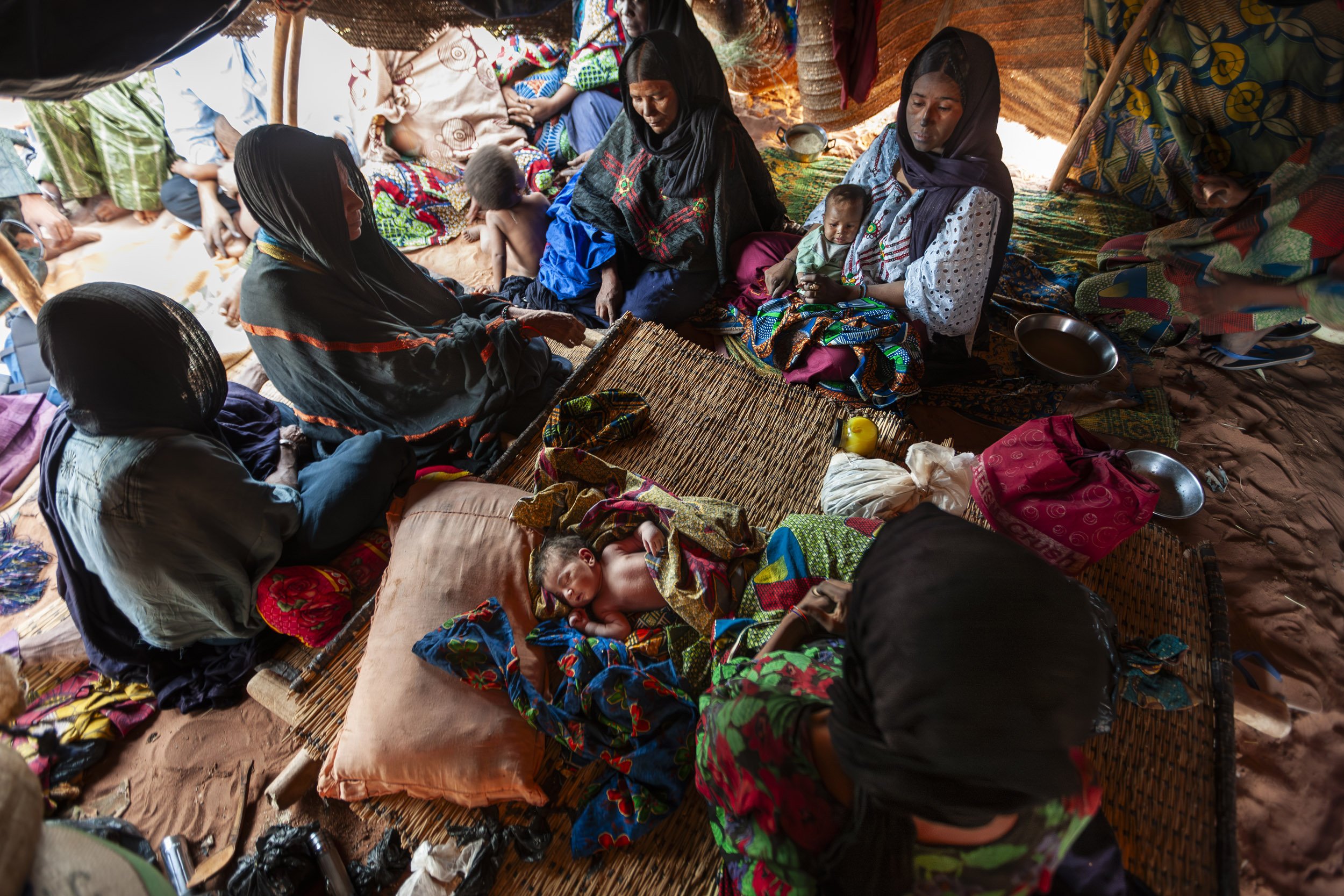
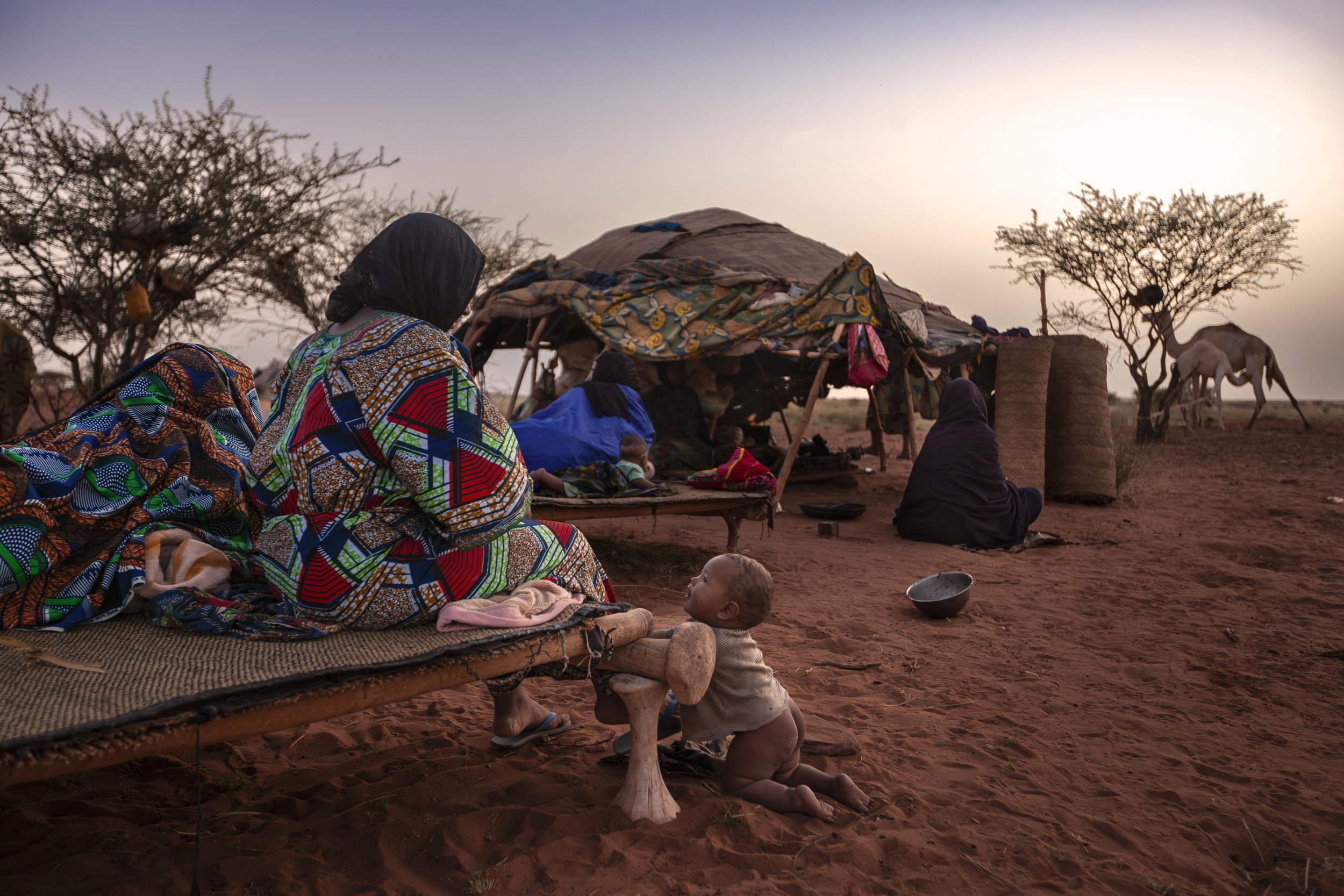
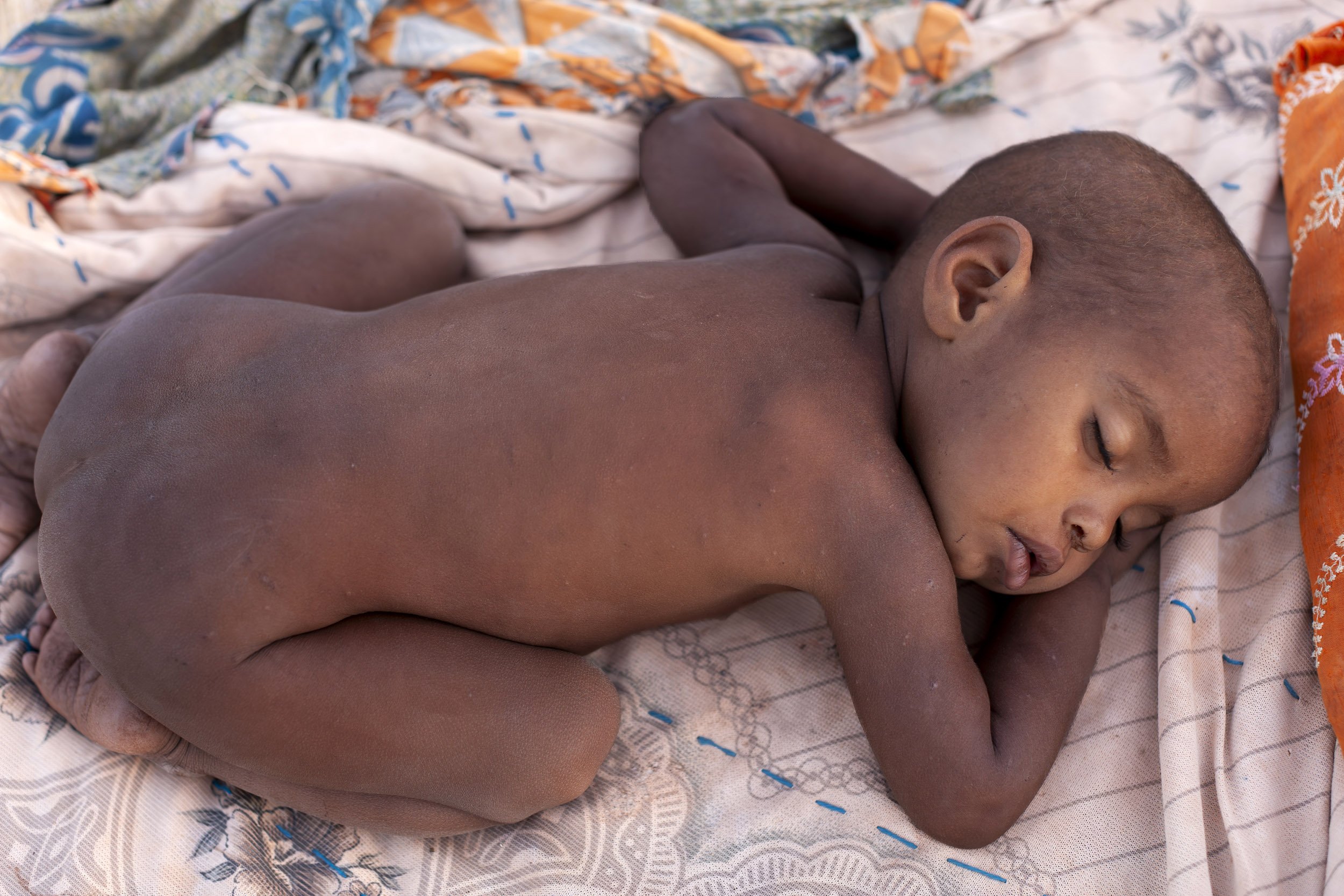
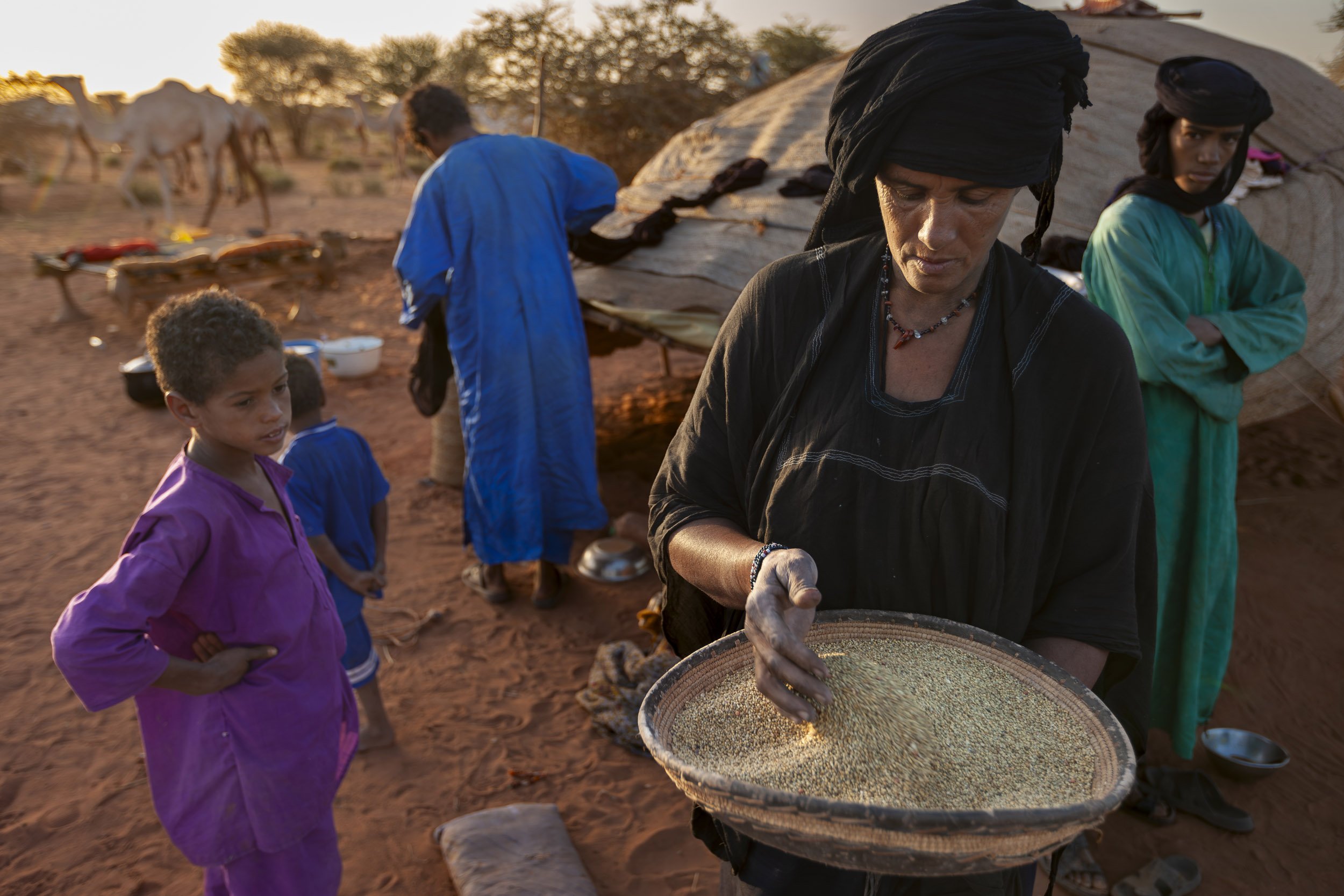
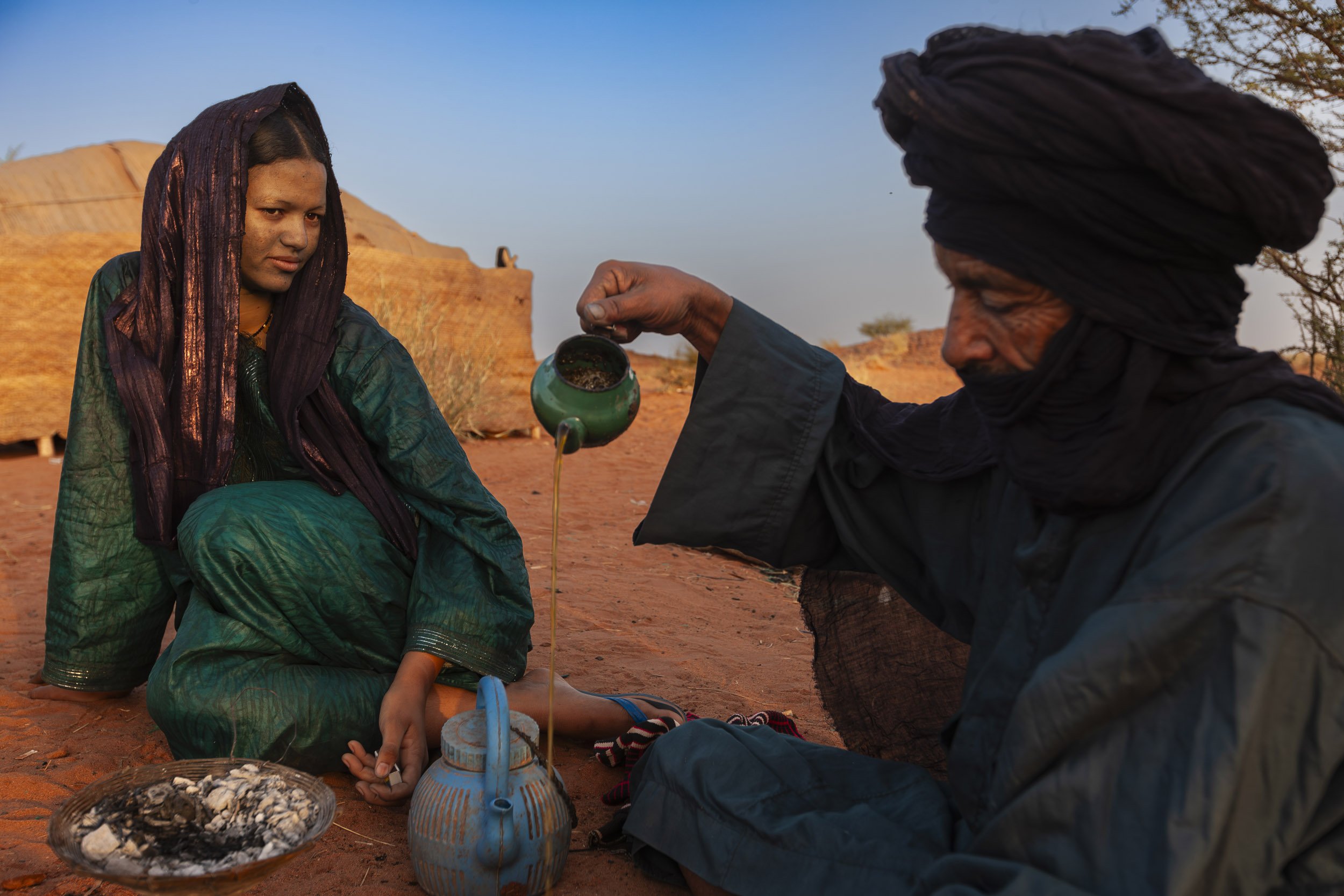
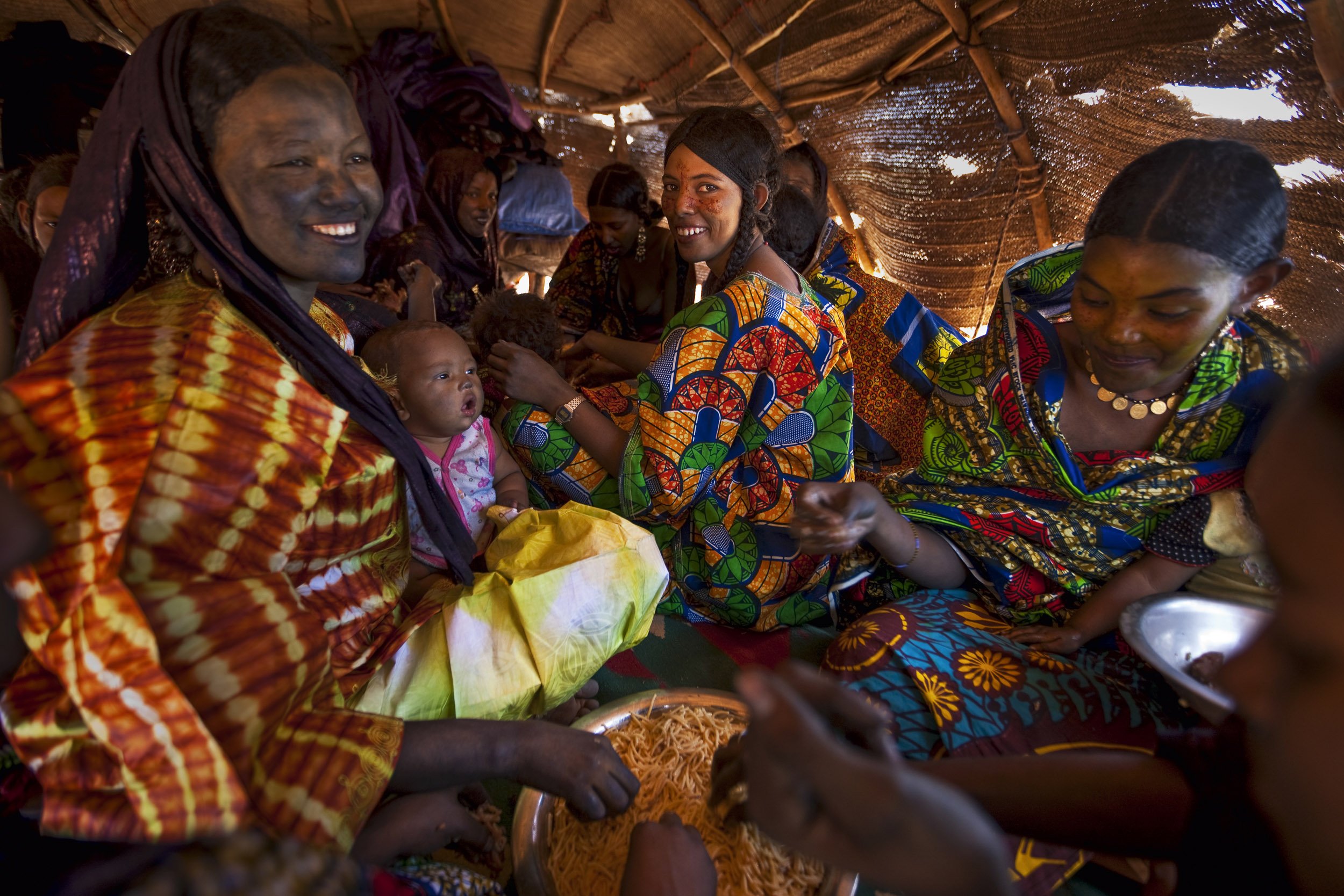
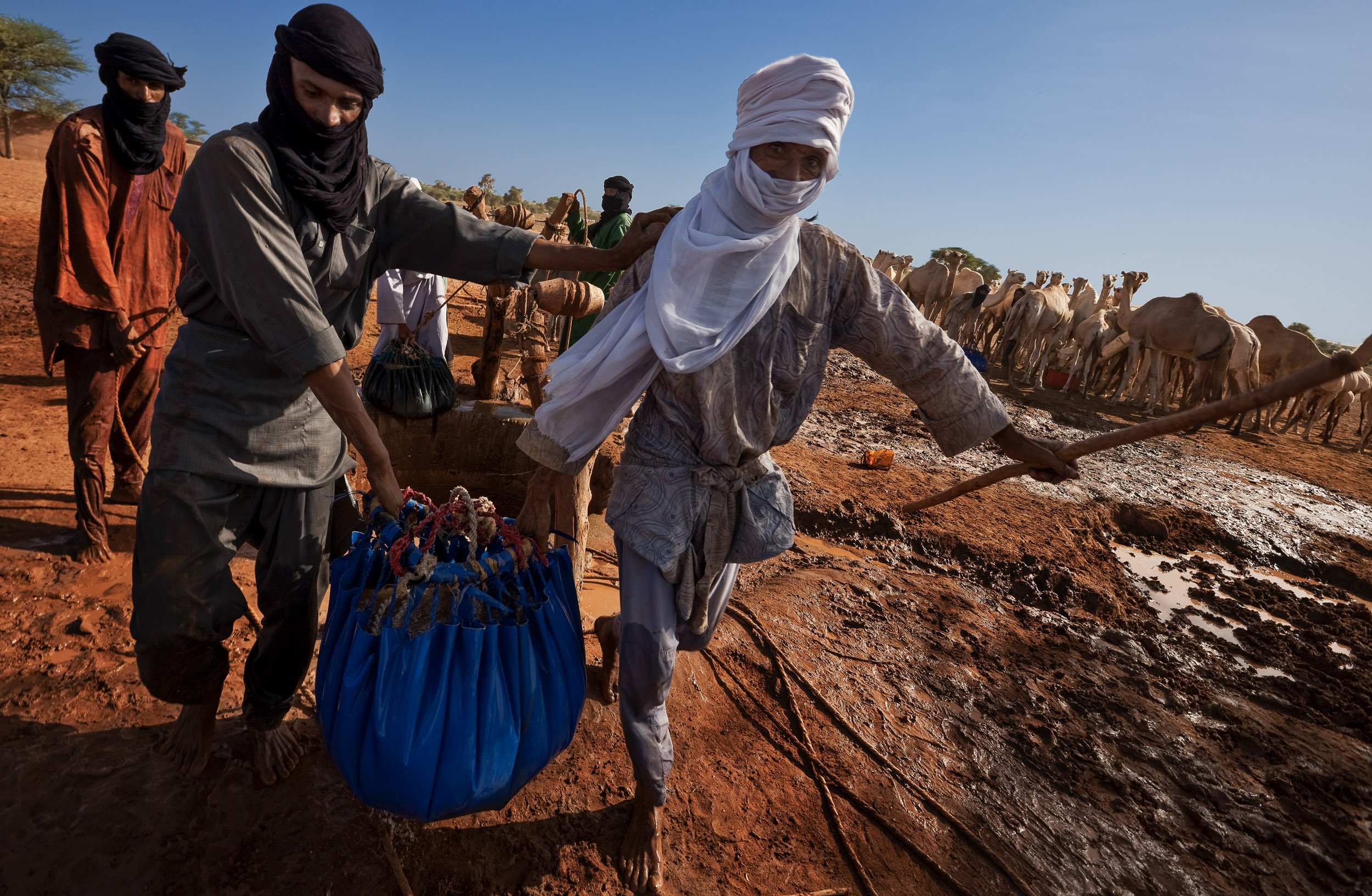
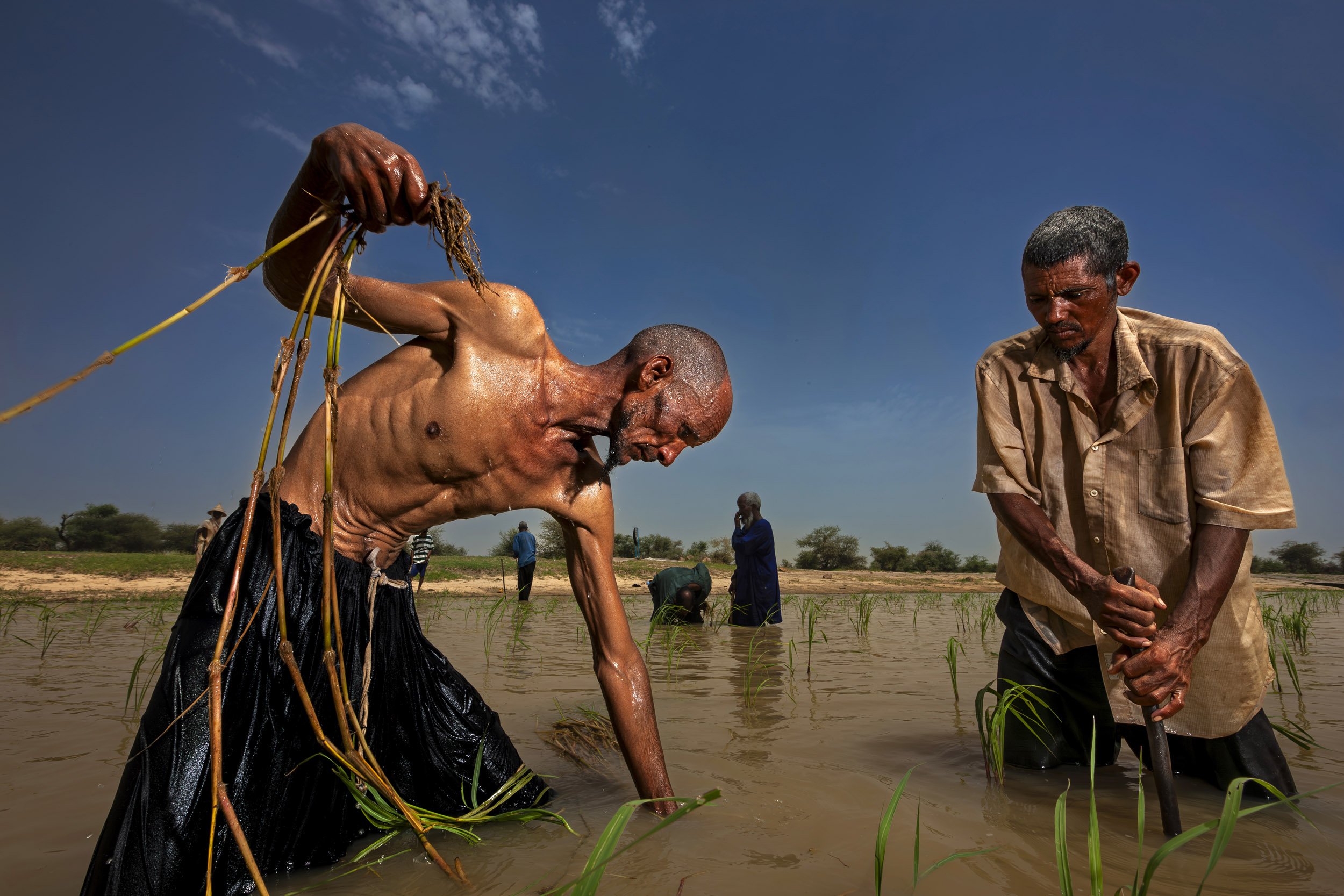
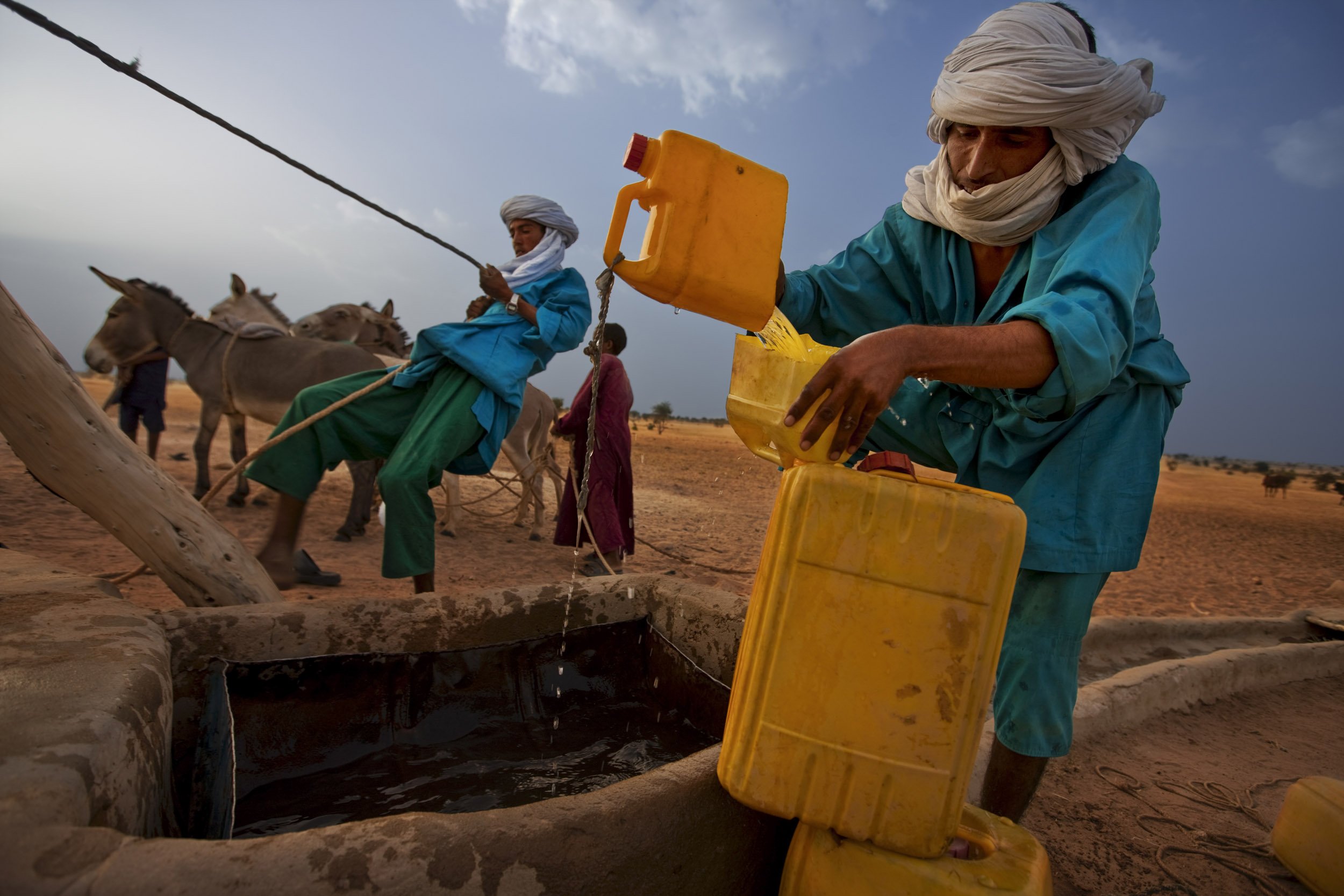
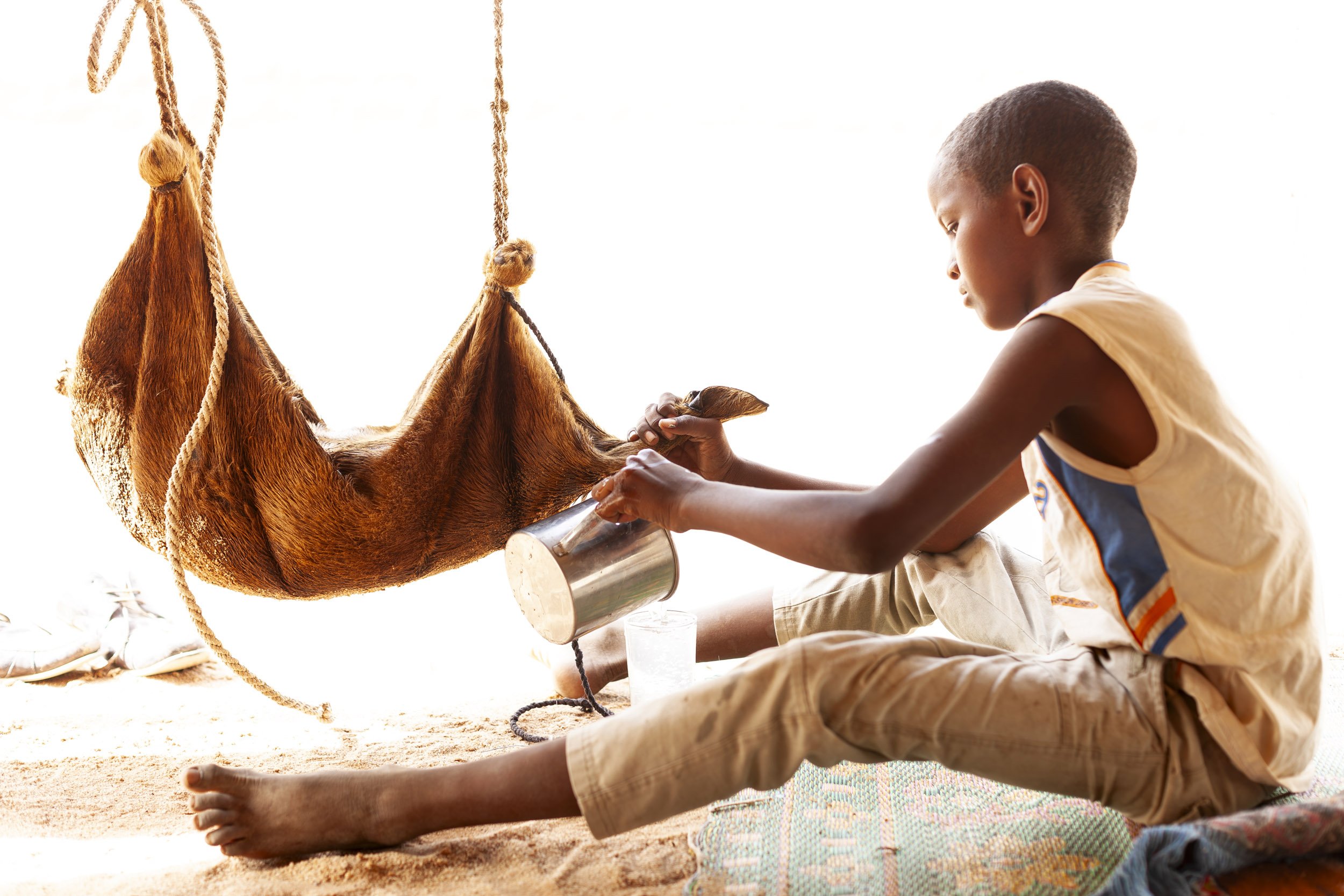
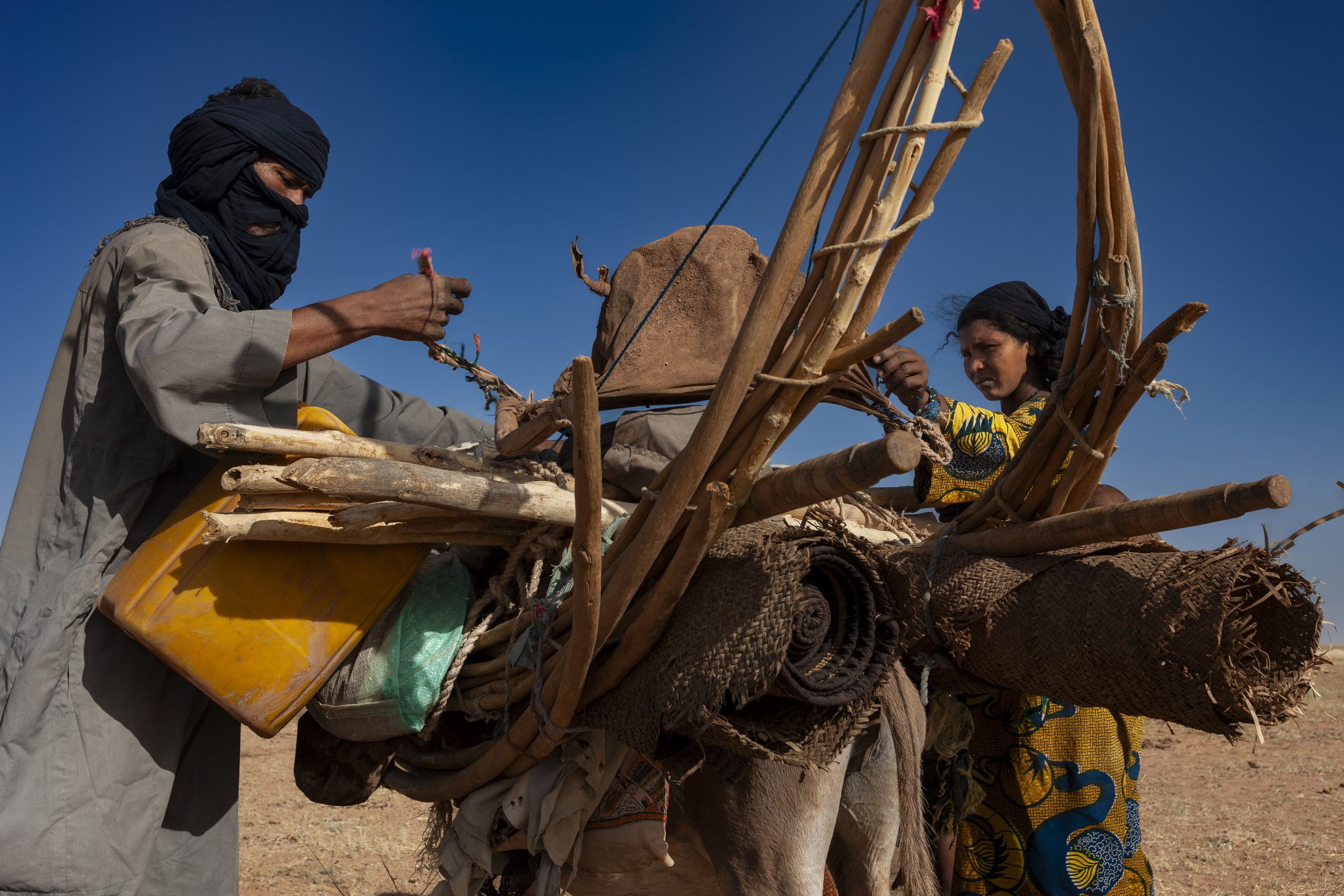
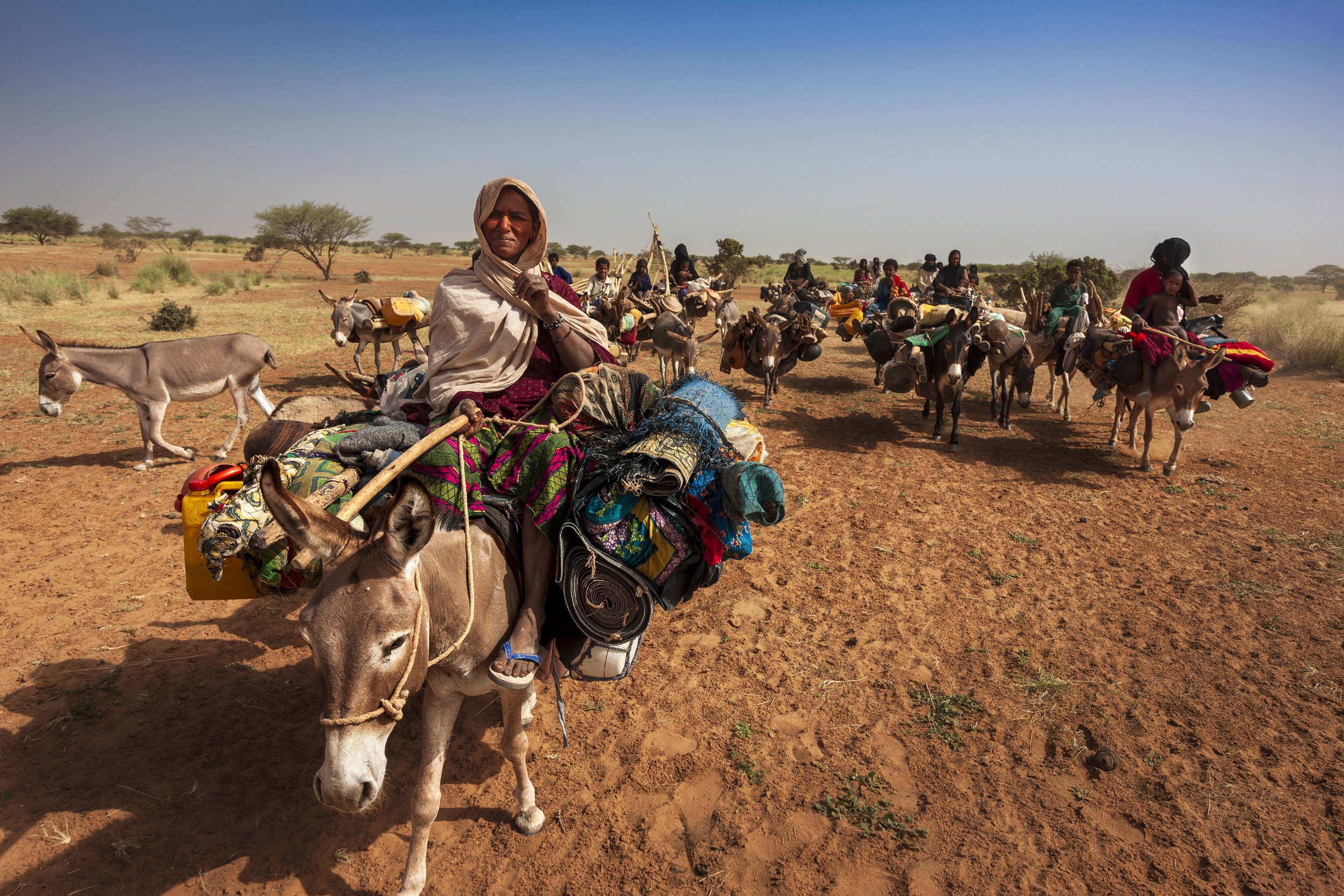
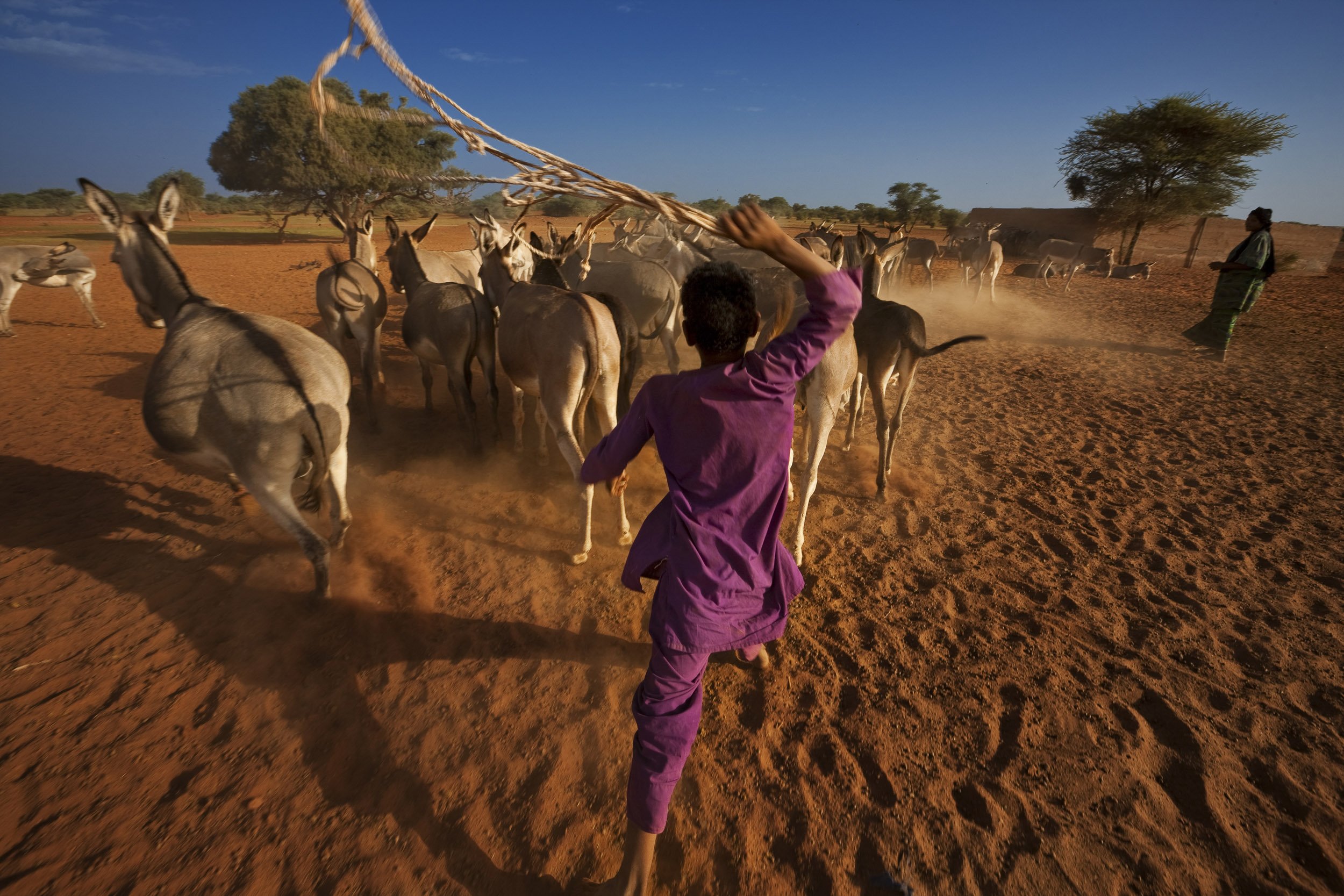
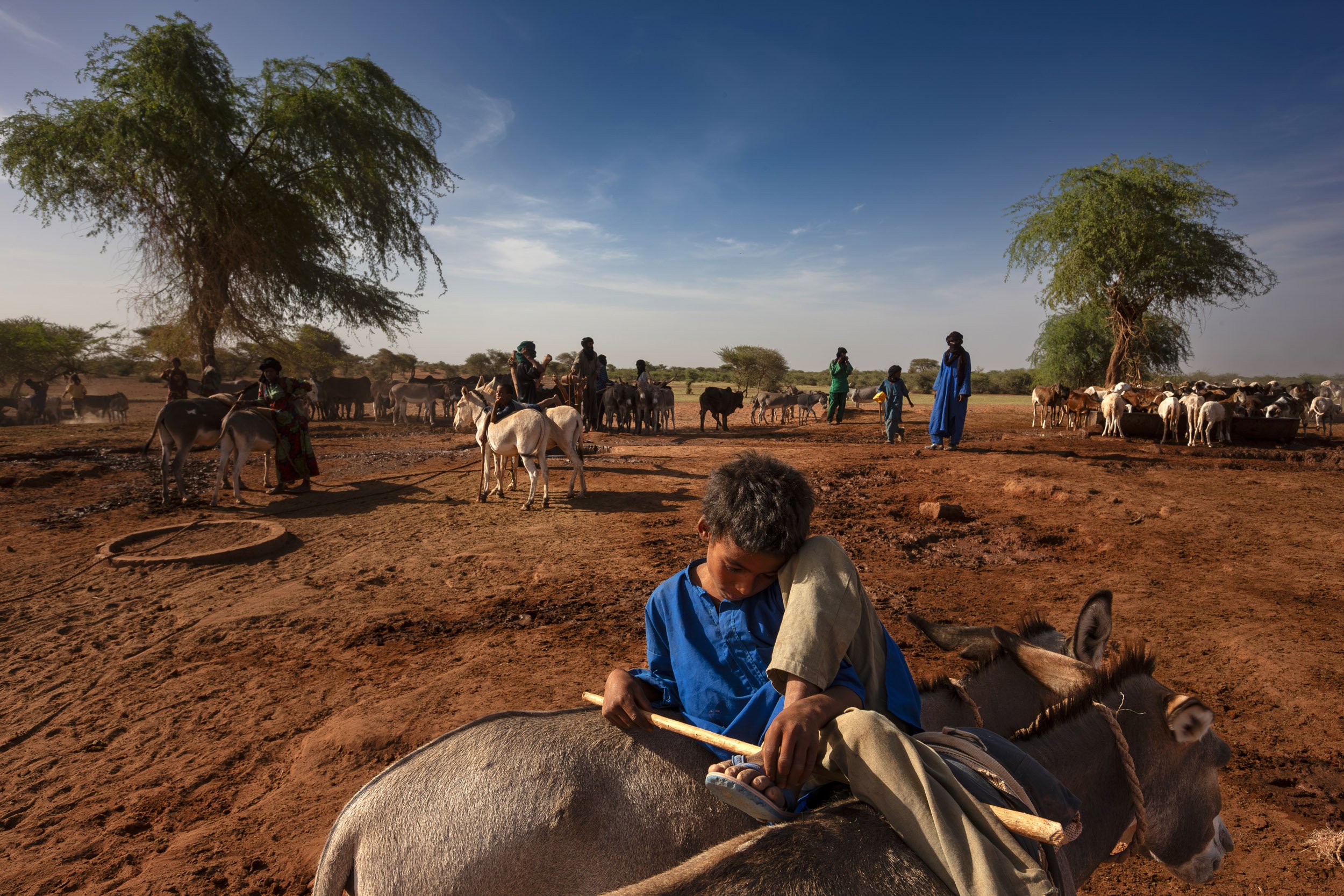
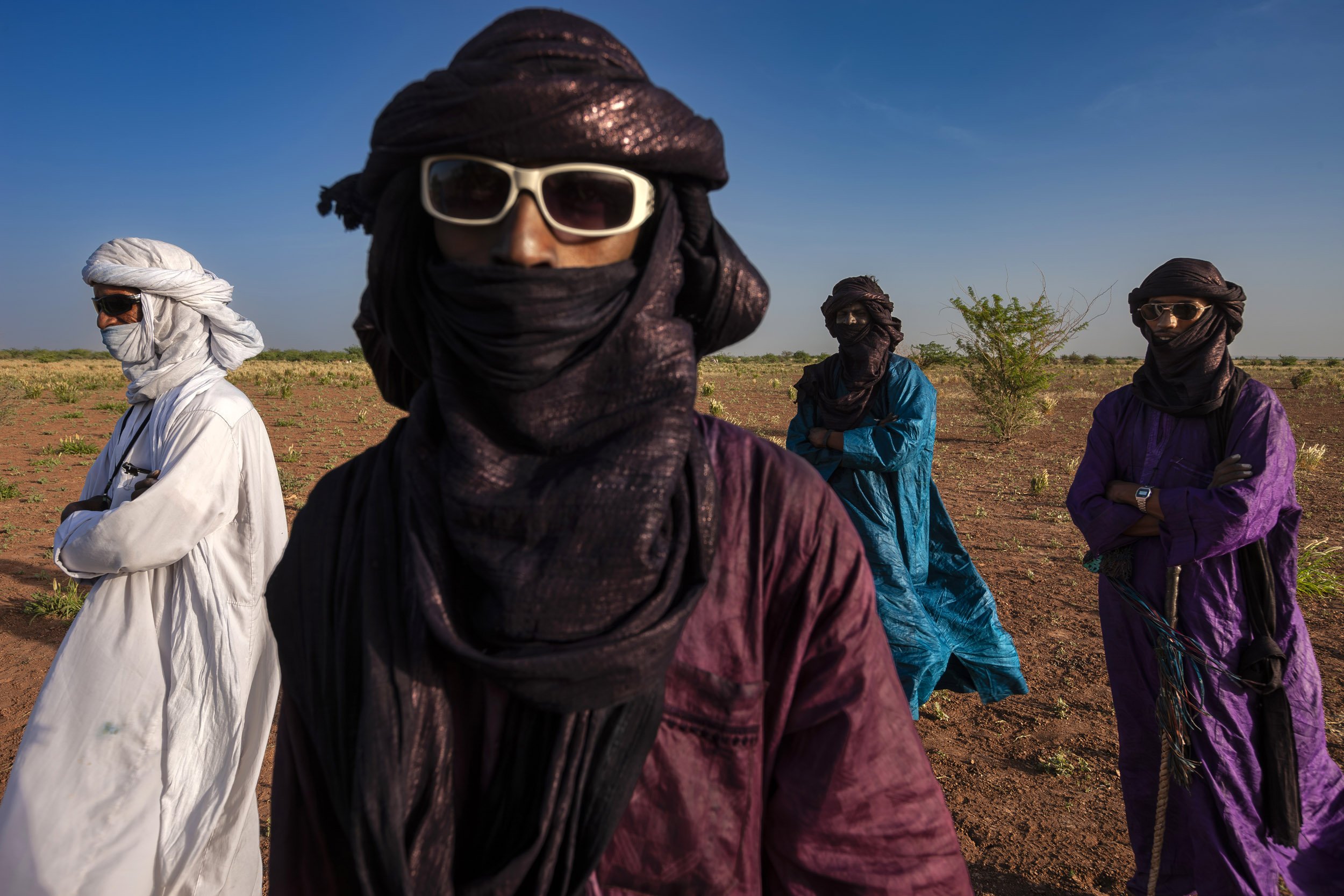
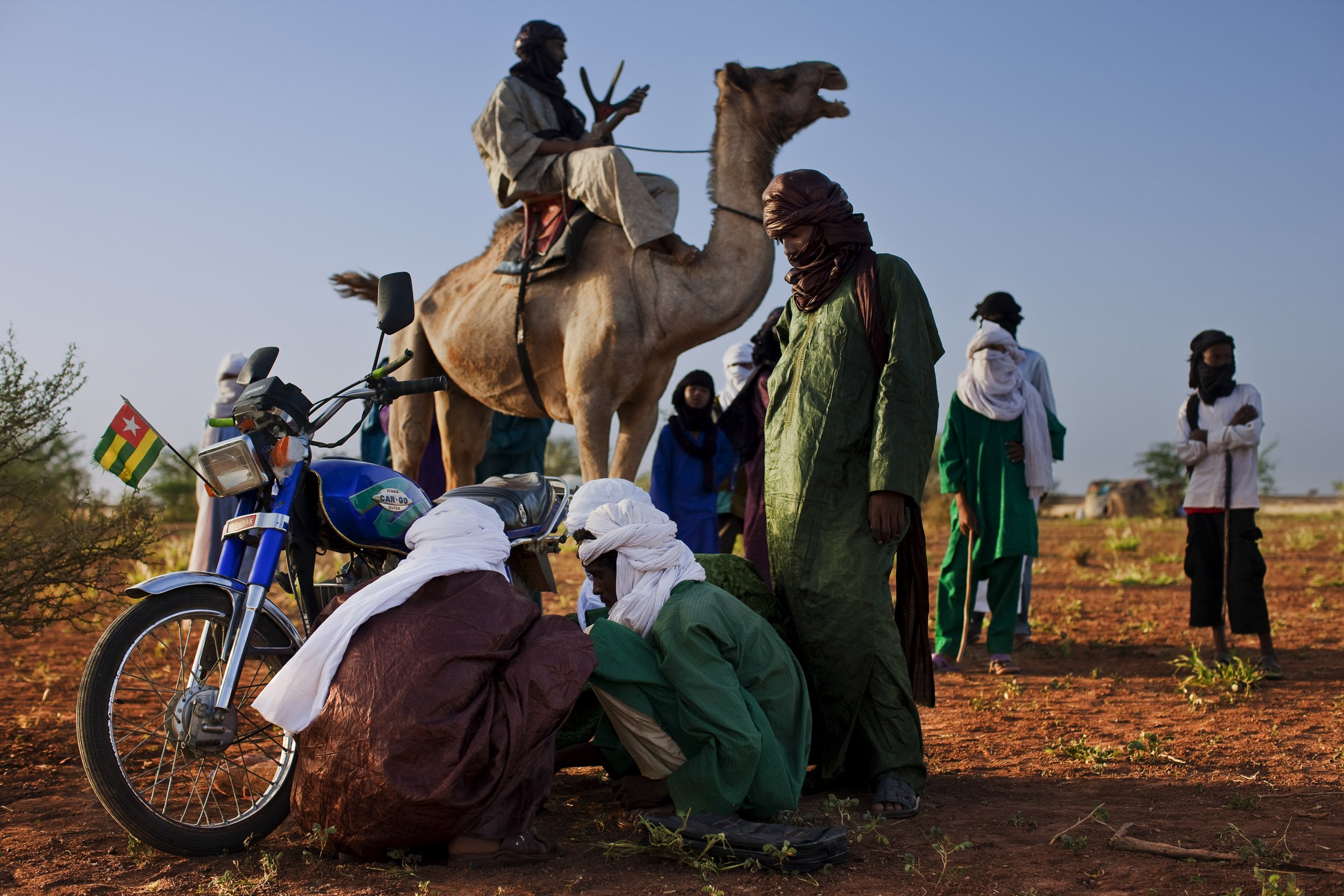
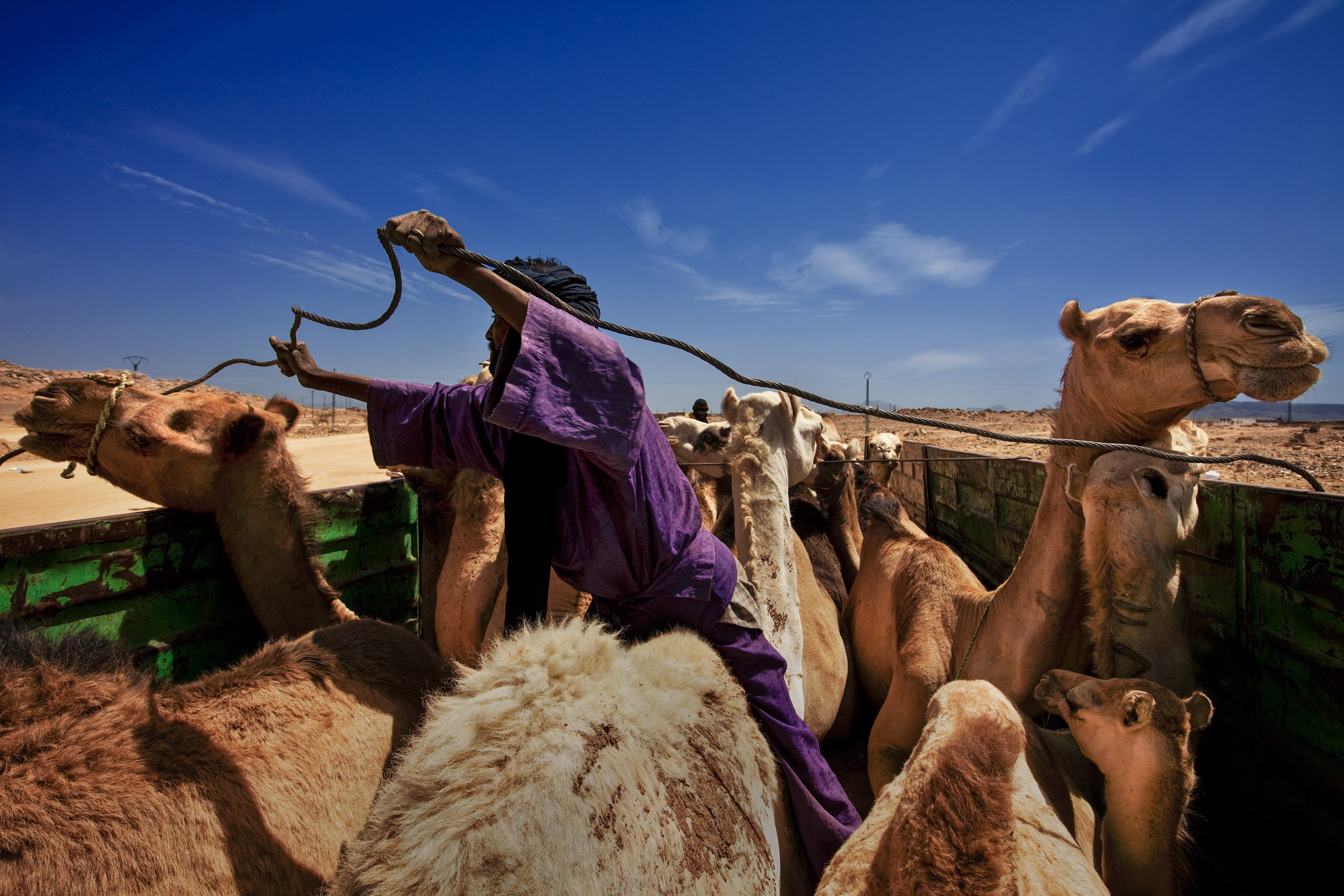
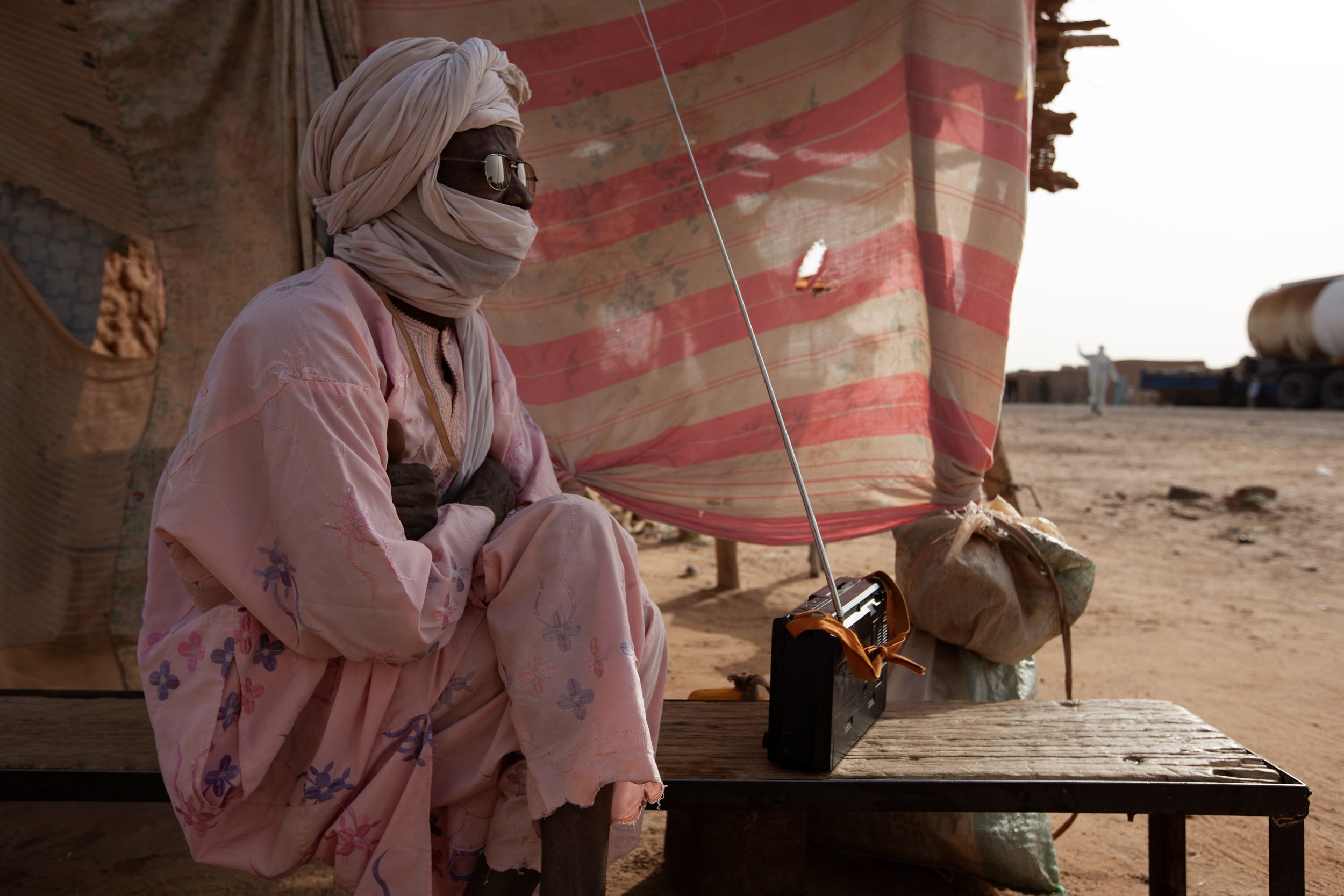
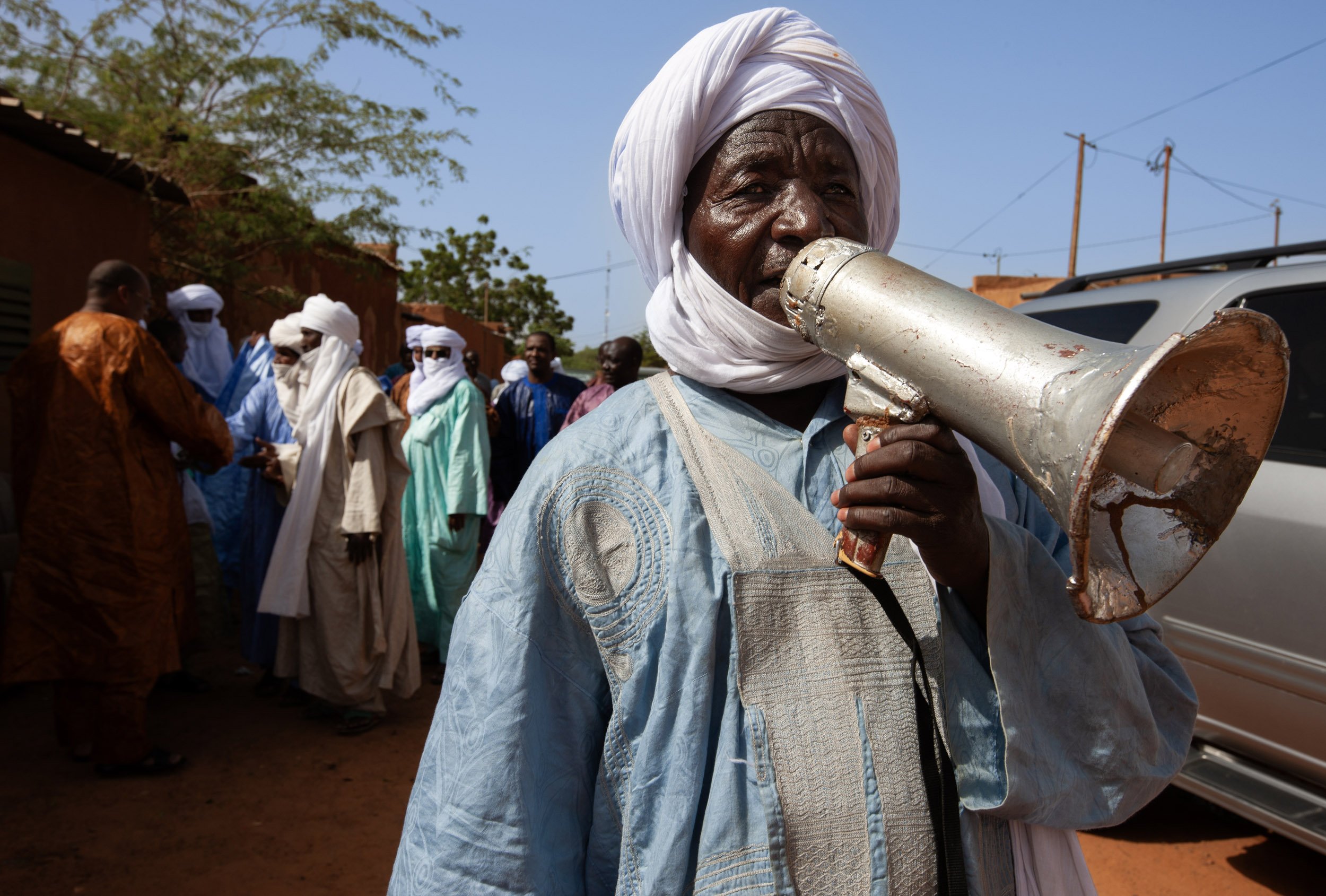
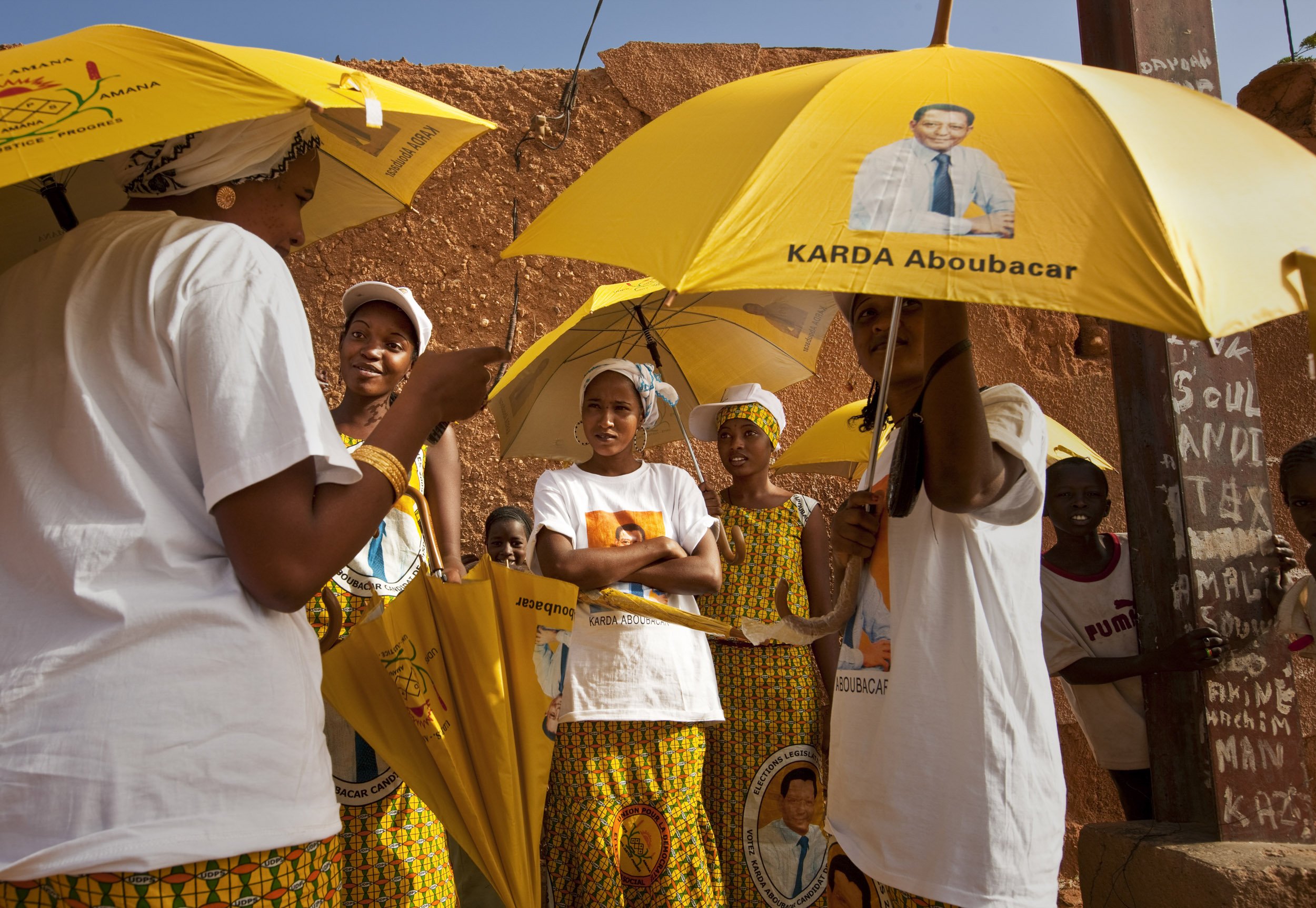
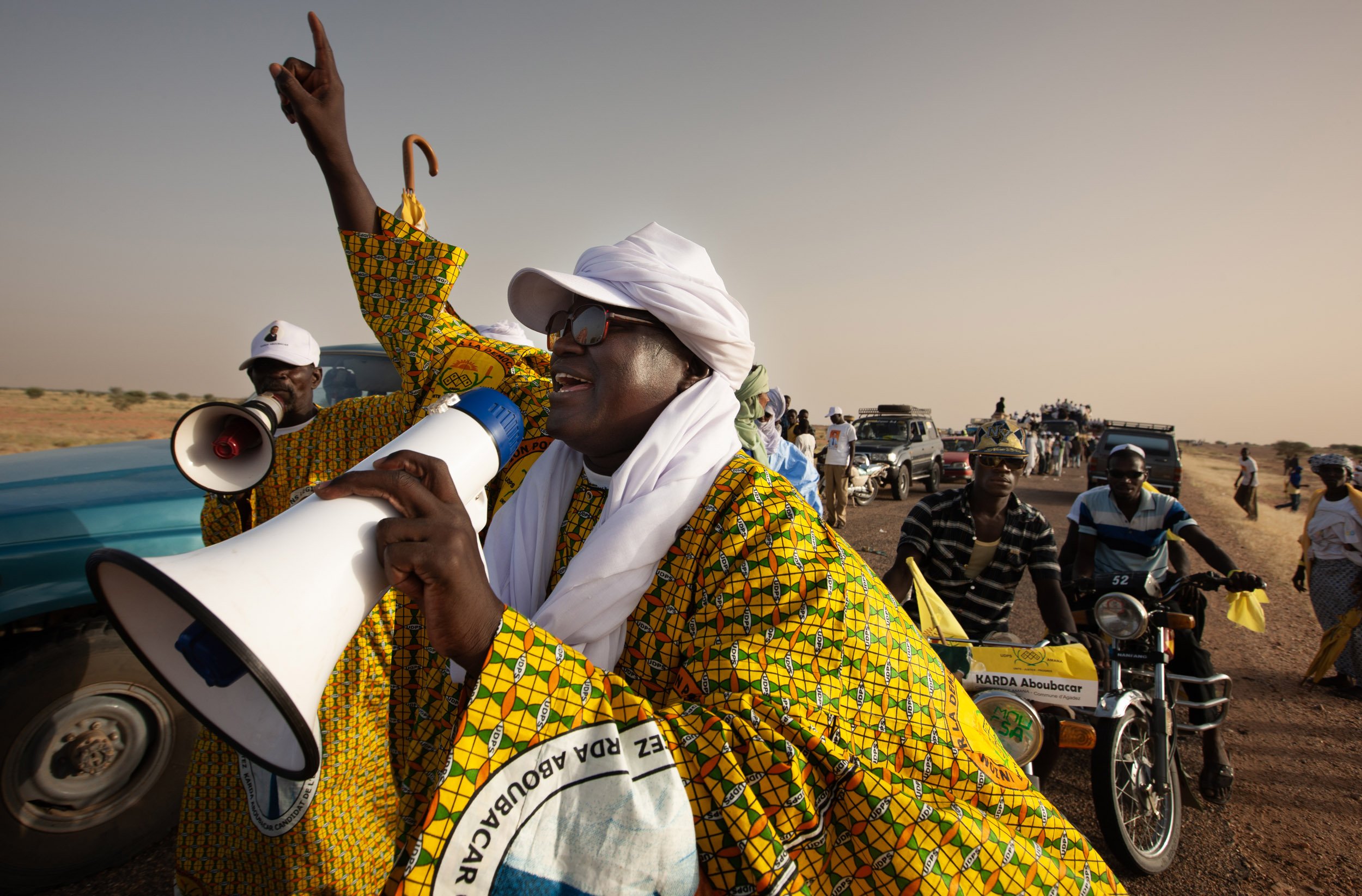
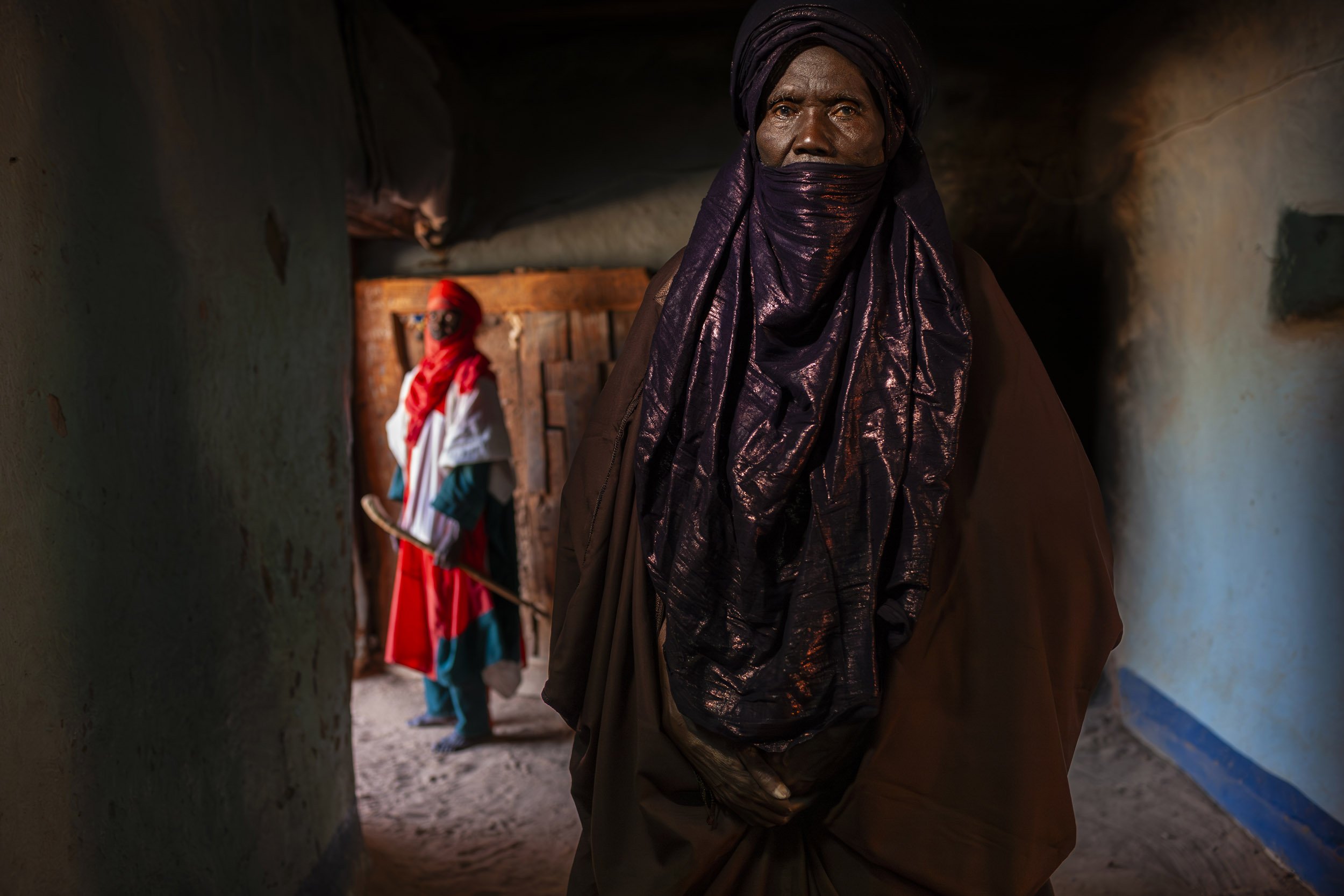
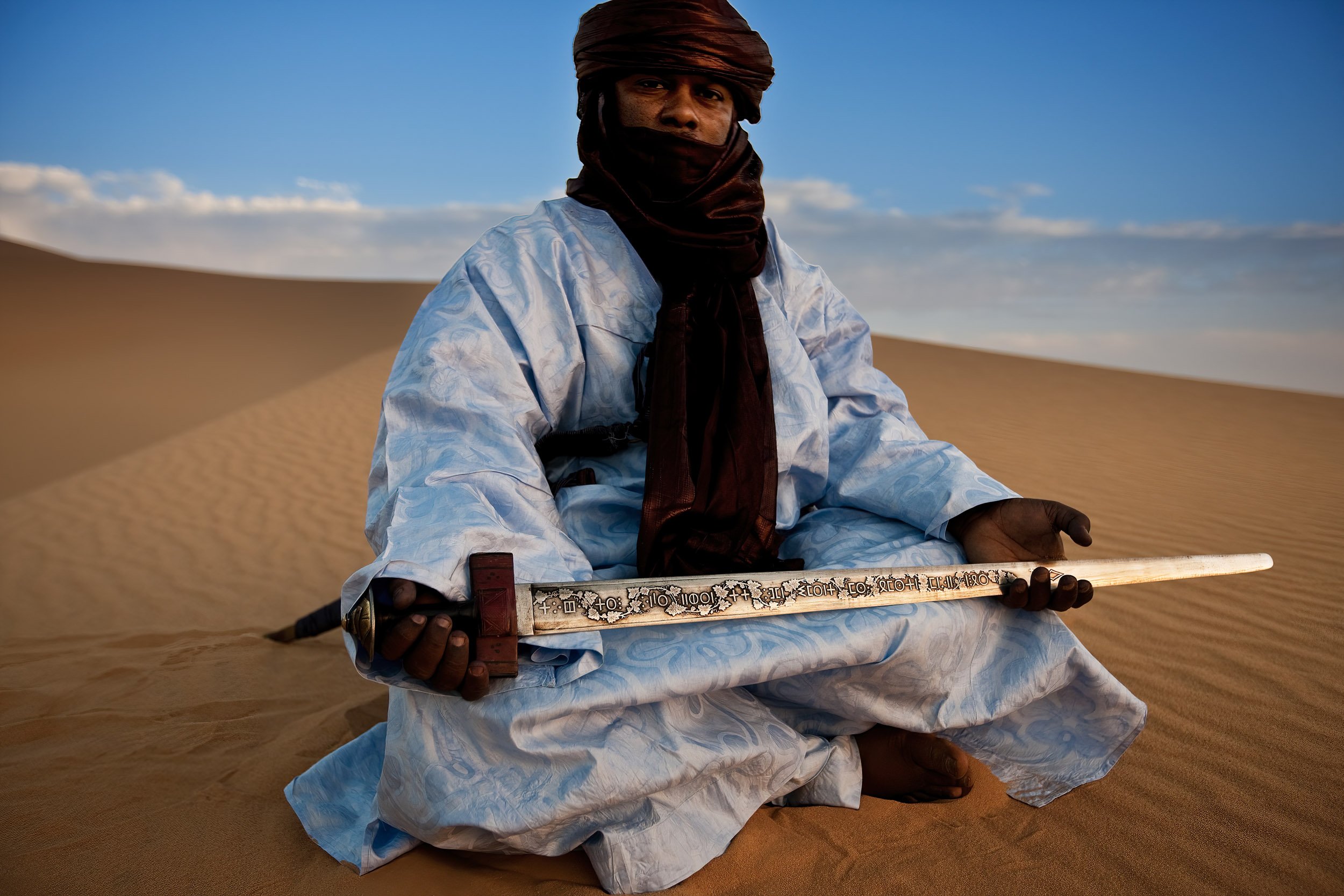
TIMBUKTU REGION, MALI, 21 SEPTEMBER 2009: Tuareg Nomads end the Ramadan fast in the desert about 50 kilometers outside of Timbuktu with prayer and dancing, Timbuktu Region, Mali, September 21 2009. (Photo by Brent Stirton/National Geographic.)
INGAL, NIGER, OCTOBER 2009: Two young Tuareg women have their hair dressed by other Tuareg women inside a traditional nomad tent at a Tuareg Nomad camp, Ingal Region, Niger, 11 October 2009. Tuareg Nomads have two traditional priorities, their animals and access to water. This group has moved to this region at this time to enjoy the remaining good grassland of the rainy season and will soon move again to be close to a good water source. The nomads survive on a diet of millet and camel milk which is occasionally supplemented by goat meat. (Photo by Brent Stirton/National Geographic.)
INGAL, NIGER, OCTOBER 2009: Scenes at a Baptism in a Tuareg Nomad camp, Ingal Region, Niger, 11 October 2009. Tuareg Baptism is very simple, three names are discussed by elders and then straws are drawn to choose the final name. The women perform a ritual of walking around the tent in a line with the leading woman brandishing two knives to symbolically cut away misfortune from the future of the child. The women then dance and sing and play the drums while men prepare goat mead and drink tea and discuss things while people visit from the surrounding nomad camps. Tuareg Nomads have two traditional priorities, their animals and access to water. This group has moved to this region at this time to enjoy the remaining good grassland of the rainy season and will soon move again to be close to a good water source. The nomads survive on a diet of millet and camel milk which is occasionally supplemented by goat meat. (Photo by Brent Stirton/National Geographic.)
TIMBUKTU, MALI, JANUARY 2010: A young Tuareg artisan boy, Anara Ag Hamay Cisse, 13 years old, stands in the dunes outside of Timbuktu, the mythical Northern Mali city, January 18, 2010. (Photo by Brent Stirton/Reportage by Getty images.)
TIMBUKTU, MALI, JANUARY 2010: Two Tuareg men drive a traditional Camel caravan laiden with salt tablets on twenty camels making the 16 day journey through the desert from Taodenni, a salt mine in the north of Mali, to the home of an Arab businessman in Timbuktu, Mali, 22 January 2010. The salt industry is in transition, long the province of the Tuareg and their camel caravanss, modernization has seen the Arabs come to dominate this trade, using powerful trucks to transport the salt over the desert in a tenth of the traditional time with far more salt onboard. As a result the camel caravans are now seen as the poor man's alternative and trucks are more and more the route of the future. Disputes between the clans of the Tuareg have also seen the caravans become far smaller, they are no longer incentivised to work together for a large caravan and it is rare to see a caravan of more than 20 camels nowadays. Everytime the caravan stops, the camels must be unloaded and it is hard and brutal work, many young Tuaregs would rather do something else or work with the Arab traders and their trucks. The Tuareg men on this caravan feel that the trade will continue on camels but that it will be the poor who undertake the long, arduous journey as they have no alternative. Ironically, most of the route with the exception of two small zones is now undertaken by the camel caravan on the same road that is used by the trucks. (Photo by Brent Stirton/Reportage by Getty images.)
AGADEZ, NIGER, SEPTEMBER 2009: Scenes at the Agadez animal market, Niger 29 September 2009. (Photo by Brent Stirton/National Geographic.)
AGADEZ REGION, NIGER, SEPTEMBER 2009: Tuareg master sword maker Abda Ahmoudou, 35, works on Tuareg swords in his workshop in Agadez city, Niger, 30 September 2009. Tuareg swords are seen as an important symbol for a Tuareg man but functions primarily as decoration and less as a defensive weapon nowadays. The best swords says Ahmoudou are made from the driveshafts of 1960's LandRover driveshafts which apparently produce the best weight and the straightest piece of metal with which to fashion the sword. The swords can fetch prices often in excess of 150 000 CFA, around $350. "A man without a sword is missing something. Every Tuareg man must have a sword. It would take me a month to explain the reasons behind the Tuareg sword, every sword has a name based on the quality of the blade and the swordmaker. "(Photo by Brent Stirton/National Geographic.)
ASSEKREM, TASSILI DU HOGGAR, SOUTHERN ALGERIA, APRIL 2009: Achmed, a Tuareg guide and elder photgraphed in a mountain cabin in the Tassili Du Hoggar, a series of beautiful rock plateaus that begin approximately 300km's south of Tamanrasset and extend all the way to the Niger border, 17 April 2009, Assekrem, Tassili Du Hoggar. These images were photographed from a small mountaintop cloister run by followers of the Frenchman Charles De Foucald. Foucald, once a hedonistic 19th century playboy, became devoutly religous and moved to Tamanrasset and in 1911 chose Assekrem as the site of his hermitage. He was assasinated by Tuaregs in 1916 after he was suspected of being a French spy. (Photo by Brent Stirton/National Geographic.)
TASSILI 'N AJJER, SOUTHERN ALGERIA, APRIL 2009: Images of famed tourist site and traditional Tuareg land, Tassili 'n Ajjer, in the south of Algeria, 02 May 2009. (photo by Brent Stirton/National Geographic Magazine.)
ASSEKREM, TASSILI DU HOGGAR, SOUTHERN ALGERIA, APRIL 2009: Images in the Tassili Du Hoggar, a series of beautiful rock plateaus that begin approximately 300km's south of Tamanrasset and extend all the way to the Niger border, 17 April 2009, Assekrem, Tassili Du Hoggar. These images were photographed from a small mountaintop cloister run by followers of the Frenchman Charles De Foucald. Foucald, once a hedonistic 19th century playboy, became devoutly religous and moved to Tamanrasset and in 1911 chose Assekrem as the site of his hermitage. He was assasinated by Tuaregs in 1916 after he was suspected of being a French spy. (Photo by Brent Stirton/National Geographic.)
INGAL, NIGER, OCTOBER 2009: Tuareg men and their camels at a Baptism in a Tuareg Nomad camp, Ingal Region, Niger, 11 October 2009. Tuareg Baptism is very simple, three names are discussed by elders and then straws are drawn to choose the final name. The women perform a ritual of walking around the tent in a line with the leading woman brandishing two knives to symbolically cut away misfortune from the future of the child. The women then dance and sing and play the drums while men prepare goat mead and drink tea and discuss things while people visit from the surrounding nomad camps. Tuareg Nomads have two traditional priorities, their animals and access to water. This group has moved to this region at this time to enjoy the remaining good grassland of the rainy season and will soon move again to be close to a good water source. The nomads survive on a diet of millet and camel milk which is occasionally supplemented by goat meat. (Photo by Brent Stirton/National Geographic.)
INGAL, NIGER, OCTOBER 2009: Tuareg Nomads on the move to a place of better grazing and water supply, Ingal Region, Niger, 10 October 2009. This group has been in this region for the rainy season, taking advantage of easy water access and good grasses for the animals. The moving is done in stages, usually the Camel herd goes first with a few men, then come the goats and then the rest of the Nomads follow with all their possessions mounted onto donkeys. Tuareg nomad tents are lightweight using wood from the south of Niger, the matting and material which cover them fold down easily. Tuareg Nomads have two traditional priorities, their animals and access to water. This group has moved to this region at this time to enjoy the remaining good grassland of the rainy season and now have to move again to be close to a good water source. The nomads survive on a diet of millet and camel milk which is occasionally supplemented by goat meat. (Photo by Brent Stirton/National Geographic.)
TIMBUKTU, MALI, JANUARY 2010: Two Tuareg men drive a traditional Camel caravan laiden with salt tablets on twenty camels making the 16 day journey through the desert from Taodenni, a salt mine in the north of Mali, to the home of an Arab businessman in Timbuktu, Mali, 22 January 2010. The salt industry is in transition, long the province of the Tuareg and their camel caravanss, modernization has seen the Arabs come to dominate this trade, using powerful trucks to transport the salt over the desert in a tenth of the traditional time with far more salt onboard. As a result the camel caravans are now seen as the poor man's alternative and trucks are more and more the route of the future. Disputes between the clans of the Tuareg have also seen the caravans become far smaller, they are no longer incentivised to work together for a large caravan and it is rare to see a caravan of more than 20 camels nowadays. Everytime the caravan stops, the camels must be unloaded and it is hard and brutal work, many young Tuaregs would rather do something else or work with the Arab traders and their trucks. The Tuareg men on this caravan feel that the trade will continue on camels but that it will be the poor who undertake the long, arduous journey as they have no alternative. Ironically, most of the route with the exception of two small zones is now undertaken by the camel caravan on the same road that is used by the trucks. (Photo by Brent Stirton/Reportage by Getty images.)
TIMBUKTU, MALI, JANUARY 2010: Two Tuareg men drive a traditional Camel caravan laiden with salt tablets on twenty camels making the 16 day journey through the desert from Taodenni, a salt mine in the north of Mali, to the home of an Arab businessman in Timbuktu, Mali, 22 January 2010. The salt industry is in transition, long the province of the Tuareg and their camel caravanss, modernization has seen the Arabs come to dominate this trade, using powerful trucks to transport the salt over the desert in a tenth of the traditional time with far more salt onboard. As a result the camel caravans are now seen as the poor man's alternative and trucks are more and more the route of the future. Disputes between the clans of the Tuareg have also seen the caravans become far smaller, they are no longer incentivised to work together for a large caravan and it is rare to see a caravan of more than 20 camels nowadays. Everytime the caravan stops, the camels must be unloaded and it is hard and brutal work, many young Tuaregs would rather do something else or work with the Arab traders and their trucks. The Tuareg men on this caravan feel that the trade will continue on camels but that it will be the poor who undertake the long, arduous journey as they have no alternative. Ironically, most of the route with the exception of two small zones is now undertaken by the camel caravan on the same road that is used by the trucks. (Photo by Brent Stirton/Reportage by Getty images.)
TIMBUKTU, MALI, JANUARY 2010: Two Tuareg men drive a traditional Camel caravan laiden with salt tablets on twenty camels making the 16 day journey through the desert from Taodenni, a salt mine in the north of Mali, to the home of an Arab businessman in Timbuktu, Mali, 22 January 2010. The salt industry is in transition, long the province of the Tuareg and their camel caravanss, modernization has seen the Arabs come to dominate this trade, using powerful trucks to transport the salt over the desert in a tenth of the traditional time with far more salt onboard. As a result the camel caravans are now seen as the poor man's alternative and trucks are more and more the route of the future. Disputes between the clans of the Tuareg have also seen the caravans become far smaller, they are no longer incentivised to work together for a large caravan and it is rare to see a caravan of more than 20 camels nowadays. Everytime the caravan stops, the camels must be unloaded and it is hard and brutal work, many young Tuaregs would rather do something else or work with the Arab traders and their trucks. The Tuareg men on this caravan feel that the trade will continue on camels but that it will be the poor who undertake the long, arduous journey as they have no alternative. Ironically, most of the route with the exception of two small zones is now undertaken by the camel caravan on the same road that is used by the trucks. (Photo by Brent Stirton/Reportage by Getty images.)
TIMBUKTU, MALI, JANUARY 2010: Two Tuareg men drive a traditional Camel caravan laiden with salt tablets on twenty camels making the 16 day journey through the desert from Taodenni, a salt mine in the north of Mali, to the home of an Arab businessman in Timbuktu, Mali, 22 January 2010. The salt industry is in transition, long the province of the Tuareg and their camel caravanss, modernization has seen the Arabs come to dominate this trade, using powerful trucks to transport the salt over the desert in a tenth of the traditional time with far more salt onboard. As a result the camel caravans are now seen as the poor man's alternative and trucks are more and more the route of the future. Disputes between the clans of the Tuareg have also seen the caravans become far smaller, they are no longer incentivised to work together for a large caravan and it is rare to see a caravan of more than 20 camels nowadays. Everytime the caravan stops, the camels must be unloaded and it is hard and brutal work, many young Tuaregs would rather do something else or work with the Arab traders and their trucks. The Tuareg men on this caravan feel that the trade will continue on camels but that it will be the poor who undertake the long, arduous journey as they have no alternative. Ironically, most of the route with the exception of two small zones is now undertaken by the camel caravan on the same road that is used by the trucks. (Photo by Brent Stirton/Reportage by Getty images.)
TIMBUKTU, MALI, JANUARY 2010: Two Tuareg men drive a traditional Camel caravan laiden with salt tablets on twenty camels making the 16 day journey through the desert from Taodenni, a salt mine in the north of Mali, to the home of an Arab businessman in Timbuktu, Mali, 22 January 2010. The salt industry is in transition, long the province of the Tuareg and their camel caravanss, modernization has seen the Arabs come to dominate this trade, using powerful trucks to transport the salt over the desert in a tenth of the traditional time with far more salt onboard. As a result the camel caravans are now seen as the poor man's alternative and trucks are more and more the route of the future. Disputes between the clans of the Tuareg have also seen the caravans become far smaller, they are no longer incentivised to work together for a large caravan and it is rare to see a caravan of more than 20 camels nowadays. Everytime the caravan stops, the camels must be unloaded and it is hard and brutal work, many young Tuaregs would rather do something else or work with the Arab traders and their trucks. The Tuareg men on this caravan feel that the trade will continue on camels but that it will be the poor who undertake the long, arduous journey as they have no alternative. Ironically, most of the route with the exception of two small zones is now undertaken by the camel caravan on the same road that is used by the trucks. (Photo by Brent Stirton/Reportage by Getty images.)
TIMBUKTU, MALI, JANUARY 2010: Two Tuareg men arrive in Timbuktu with their traditional Camel caravan laiden with salt tablets after making the 16 day journey through the desert from Taodenni, a salt mine in the north of Mali, to the home of Arab businessman in Timbuktu, Mali, 22 January 2010. The men are greeted warmly by the Arab traders who will now move the salt both across Mali and further afield. The salt industry is in transition, long the province of the Tuareg and their camel caravanss, modernization has seen the Arabs come to dominate this trade, using powerful trucks to transport the salt over the desert in a tenth of the traditional time with far more salt onboard. As a result the camel caravans are now seen as the poor man's alternative and trucks are more and more the route of the future. Disputes between the clans of the Tuareg have also seen the caravans become far smaller, they are no longer incentivised to work together for a large caravan and it is rare to see a caravan of more than 20 camels nowadays. Everytime the caravan stops, the camels must be unloaded and it is hard and brutal work, many young Tuaregs would rather do something else or work with the Arab traders and their trucks. The Tuareg men on this caravan feel that the trade will continue on camels but that it will be the poor who undertake the long, arduous journey as they have no alternative. Ironically, most of the route with the exception of two small zones is now undertaken by the camel caravan on the same road that is used by the trucks. (Photo by Brent Stirton/Reportage by Getty images.)
INGAL, NIGER, OCTOBER 2009: Tuareg men gather in a Tuareg Nomad camp, Ingal Region, Niger, 11 October 2009. The men are here to discuss things with a local Tuareg political candidate. They will eat together, drink traditional tea and then sleep during the afternoon heat. Tuareg Nomads have two traditional priorities, their animals and access to water. This group has moved to this region at this time to enjoy the remaining good grassland of the rainy season and will soon move again to be close to a good water source. The nomads survive on a diet of millet and camel milk which is occasionally supplemented by goat meat. (Photo by Brent Stirton/National Geographic.)
TAMANARANSSET, SOUTHERN ALGERIA, APRIL 2009: A Tuareg Nobleman related to Tuareg royalty stands in a courtyard in Tamanarasset, Southern Algeria, 14th April 2009. Tuareg Nobility is no longer recognised by the Algerian authorities but continues to matter to the Tuaregs themselves. The Tuareg Royal line ended in 1902 when the Tuareg were finally conclusively defeated at the Battle of Tit, an area 45 km outside of Tamanaransset. Tamanarasset is a former Tuareg town which has now been taken over by Algerian Arabs as well as many other immigrant groups, partly as a result of the Algerian Civil War and also as a strategic economic and military base for the Algerian government. (Photo by Brent Stirton/National Geographic.)
TIMBUKTU, TIN-TELOUT VILLAGE, SEPTEMBER 2009: Tin-Telout Tuareg village scenes on the outskirts of Timbuktu, September 10, 2009. This village is made up of sedentary Tuareg people who fled the Tuareg Rebellion and subsequent Mali Tuareg purges. They lived as refugees in Mauritania in poor conditions, having left all their possesions and livestock behind when they fled Mali. They only returned to Mali after the peace accord was signed and their leader had personally been back to see for himself if it was safe. They now live sedentary lives alongside Songhay people in Tin-Telout raising goats and cattle, they have adoped this sedentary practise as a joint result of long periods of drought and instability. (Photo by Brent Stirton/National Geographic.)
TIMBUKTU, SEPTEMBER 2009: Two young men go through the Tuareg Chesh ceremony where each is ceremonially turbanned in front of their families by an elder man, Timbuktu, 20 September 2009. This signifies their coming of age and elegibility to marry and be recognised as a man of the clan. These Tuaregs are Bela, a former slave of the Tuareg dating back to the 15th century. They are now considered Tuareg and have adopted all the customs of Tuareg as well as the Tamashek language. (Photo by Brent Stirton/National Geographic.)
TIMBUKTU, SEPTEMBER 2009: Two young men go through the Tuareg Chesh ceremony where each is ceremonially turbanned in front of their families by an elder man, Timbuktu, 20 September 2009. This signifies their coming of age and elegibility to marry and be recognised as a man of the clan. These Tuaregs are Bela, a former slave of the Tuareg dating back to the 15th century. They are now considered Tuareg and have adopted all the customs of Tuareg as well as the Tamashek language. (Photo by Brent Stirton/National Geographic.)
TIMBUKTU, TIN-TELOUT VILLAGE, SEPTEMBER 2009: Tin-Telout Tuareg village scenes on the outskirts of Timbuktu, September 10, 2009. This village is made up of sedentary Tuareg people who fled the Tuareg Rebellion and subsequent Mali Tuareg purges. They lived as refugees in Mauritania in poor conditions, having left all their possesions and livestock behind when they fled Mali. They only returned to Mali after the peace accord was signed and their leader had personally been back to see for himself if it was safe. They now live sedentary lives alongside Songhay people in Tin-Telout raising goats and cattle, they have adoped this sedentary practise as a joint result of long periods of drought and instability. (Photo by Brent Stirton/National Geographic.)
TIMBUKTU, SEPTEMBER 2009: Tuareg nomads and their families camped on the outskirts of Timbuktu during the rainy season, September 6, 2009. The nomads have used this route for centuries, using the same campsites as their forefathers for centuries. They remain in place to fatten up the animals on grasses produced during the rainy season and then head out back into the desert on their nomadic routes. Timbuktu is a historical Malian city, a long established centre of learning for Africa, Islam is at the heart of that learning as is medicine, science, law and technology. (Photo by Brent Stirton/National Geographic.)
INGAL, NIGER, OCTOBER 2009: Scenes at a Baptism in a Tuareg Nomad camp, Ingal Region, Niger, 11 October 2009. Tuareg Baptism is very simple, three names are discussed by elders and then straws are drawn to choose the final name. The women perform a ritual of walking around the tent in a line with the leading woman brandishing two knives to symbolically cut away misfortune from the future of the child. The women then dance and sing and play the drums while men prepare goat mead and drink tea and discuss things while people visit from the surrounding nomad camps. Tuareg Nomads have two traditional priorities, their animals and access to water. This group has moved to this region at this time to enjoy the remaining good grassland of the rainy season and will soon move again to be close to a good water source. The nomads survive on a diet of millet and camel milk which is occasionally supplemented by goat meat. (Photo by Brent Stirton/National Geographic.)
INGAL, NIGER, OCTOBER 2009: Scenes at a Baptism in a Tuareg Nomad camp, Ingal Region, Niger, 11 October 2009. Tuareg Baptism is very simple, three names are discussed by elders and then straws are drawn to choose the final name. The women perform a ritual of walking around the tent in a line with the leading woman brandishing two knives to symbolically cut away misfortune from the future of the child. The women then dance and sing and play the drums while men prepare goat mead and drink tea and discuss things while people visit from the surrounding nomad camps. Tuareg Nomads have two traditional priorities, their animals and access to water. This group has moved to this region at this time to enjoy the remaining good grassland of the rainy season and will soon move again to be close to a good water source. The nomads survive on a diet of millet and camel milk which is occasionally supplemented by goat meat. (Photo by Brent Stirton/National Geographic.)
TIMBUKTU REGION, MALI, 21 SEPTEMBER 2009: Tuareg Nomads end the Ramadan fast in the desert about 50 kilometers outside of Timbuktu with prayer and dancing, Timbuktu Region, Mali, September 21 2009. (Photo by Brent Stirton/National Geographic.)
TOUWA, NIGER, SEPTEMBER 2009: A young Tuareg girl, Mariam Francois Acosta, 17, a girl descended from mixed Tuareg French blood, prepares for her wedding in the Niger city of Touwa, Spetember 25 2009. She is tended by the female members of her family and her friends. It is similar to a traditional wedding except for the nature of the clothing which is worn. She is dressed and made up, a meal is eaten, there is dancing with a Tuareg band on electric guitars, everyone goes to the Mosque at 3pm to give thanks for the wedding and after that she is considered married. That evening a party is thrown with more music and dancing. The bride and groom do not appear together for an official nuptials, it all occurs seperately. The name of the groom is Ibrahim Mahmoudane. (Photo by Brent Stirton/National Geographic.)
TOUWA, NIGER, SEPTEMBER 2009: A young Tuareg girl, Mariam Francois Acosta, 17, a girl descended from mixed Tuareg French blood, prepares for her wedding in the Niger city of Touwa, Spetember 25 2009. She is tended by the female members of her family and her friends. It is similar to a traditional wedding except for the nature of the clothing which is worn. She is dressed and made up, a meal is eaten, there is dancing with a Tuareg band on electric guitars, everyone goes to the Mosque at 3pm to give thanks for the wedding and after that she is considered married. That evening a party is thrown with more music and dancing. The bride and groom do not appear together for an official nuptials, it all occurs seperately. The name of the groom is Ibrahim Mahmoudane. (Photo by Brent Stirton/National Geographic.)
INGAL, NIGER, OCTOBER 2009: Evening scenes in a Tuareg Nomad camp, Ingal Region, Niger, 04 October 2009. Tuareg Nomads have two traditional priorities, their animals and access to water. This group has moved to this region at this time to enjoy the remaining good grassland of the rainy season and will soon move again to be close to a good water source. The nomads survive on a diet of millet and camel milk which is occasionally supplemented by goat meat. (Photo by Brent Stirton/National Geographic.)
INGAL, NIGER, OCTOBER 2009: Scenes at a Baptism in a Tuareg Nomad camp, Ingal Region, Niger, 11 October 2009. Tuareg Baptism is very simple, three names are discussed by elders and then straws are drawn to choose the final name. The women perform a ritual of walking around the tent in a line with the leading woman brandishing two knives to symbolically cut away misfortune from the future of the child. The women then dance and sing and play the drums while men prepare goat mead and drink tea and discuss things while people visit from the surrounding nomad camps. Tuareg Nomads have two traditional priorities, their animals and access to water. This group has moved to this region at this time to enjoy the remaining good grassland of the rainy season and will soon move again to be close to a good water source. The nomads survive on a diet of millet and camel milk which is occasionally supplemented by goat meat. (Photo by Brent Stirton/National Geographic.)
ZAGADO, NORTHERN NIGER, APRIL 2009: Images of Tuareg Nomad people gathered around a well site in Zagado, Nothern Niger, 7 April 2009. (Photo by Brent Stirton/National Geographic.)
INGAL, NIGER, OCTOBER 2009: Evening scenes of a Baptism in a Tuareg Nomad camp, Ingal Region, Niger, 11 October 2009. Tuareg Baptism is very simple, three names are discussed by elders and then straws are drawn to choose the final name. The women perform a ritual of walking around the tent in a line with the leading woman brandishing two knives to symbolically cut away misfortune from the future of the child. The women then dance and sing and play the drums while men prepare goat mead and drink tea and discuss things while people visit from the surrounding nomad camps. Tuareg Nomads have two traditional priorities, their animals and access to water. This group has moved to this region at this time to enjoy the remaining good grassland of the rainy season and will soon move again to be close to a good water source. The nomads survive on a diet of millet and camel milk which is occasionally supplemented by goat meat. (Photo by Brent Stirton/National Geographic.)
INGAL, NIGER, OCTOBER 2009: Early morning scenes at a Baptism in a Tuareg Nomad camp, Ingal Region, Niger, 11 October 2009. Tuareg Baptism is very simple, three names are discussed by elders and then straws are drawn to choose the final name. The women perform a ritual of walking around the tent in a line with the leading woman brandishing two knives to symbolically cut away misfortune from the future of the child. The women then dance and sing and play the drums while men prepare goat mead and drink tea and discuss things while people visit from the surrounding nomad camps. Tuareg Nomads have two traditional priorities, their animals and access to water. This group has moved to this region at this time to enjoy the remaining good grassland of the rainy season and will soon move again to be close to a good water source. The nomads survive on a diet of millet and camel milk which is occasionally supplemented by goat meat. (Photo by Brent Stirton/National Geographic.)
INGAL, NIGER, OCTOBER 2009: Evening scenes in a Tuareg Nomad camp, Ingal Region, Niger, 11 October 2009. Tuareg Nomads have two traditional priorities, their animals and access to water. This group has moved to this region at this time to enjoy the remaining good grassland of the rainy season and will soon move again to be close to a good water source. The nomads survive on a diet of millet and camel milk which is occasionally supplemented by goat meat. (Photo by Brent Stirton/National Geographic.)
INGAL, NIGER, OCTOBER 2009: Early morning scenes at a Tuareg Nomad camp, Ingal Region, Niger, 08 October 2009. Tuareg Nomads have two traditional priorities, their animals and access to water. This group has moved to this region at this time to enjoy the remaining good grassland of the rainy season and will soon move again to be close to a good water source. The nomads survive on a diet of millet and camel milk which is occasionally supplemented by goat meat. (Photo by Brent Stirton/National Geographic.)
INGAL, NIGER, OCTOBER 2009: Early morning scenes at a Baptism in a Tuareg Nomad camp, Ingal Region, Niger, 11 October 2009. Tuareg Baptism is very simple, three names are discussed by elders and then straws are drawn to choose the final name. The women perform a ritual of walking around the tent in a line with the leading woman brandishing two knives to symbolically cut away misfortune from the future of the child. The women then dance and sing and play the drums while men prepare goat mead and drink tea and discuss things while people visit from the surrounding nomad camps. Tuareg Nomads have two traditional priorities, their animals and access to water. This group has moved to this region at this time to enjoy the remaining good grassland of the rainy season and will soon move again to be close to a good water source. The nomads survive on a diet of millet and camel milk which is occasionally supplemented by goat meat. (Photo by Brent Stirton/National Geographic.)
INGAL, NIGER, OCTOBER 2009: Scenes at a Baptism in a Tuareg Nomad camp, Ingal Region, Niger, 11 October 2009. Tuareg Baptism is very simple, three names are discussed by elders and then straws are drawn to choose the final name. The women perform a ritual of walking around the tent in a line with the leading woman brandishing two knives to symbolically cut away misfortune from the future of the child. The women then dance and sing and play the drums while men prepare goat mead and drink tea and discuss things while people visit from the surrounding nomad camps. Tuareg Nomads have two traditional priorities, their animals and access to water. This group has moved to this region at this time to enjoy the remaining good grassland of the rainy season and will soon move again to be close to a good water source. The nomads survive on a diet of millet and camel milk which is occasionally supplemented by goat meat. (Photo by Brent Stirton/National Geographic.)
INGAL, NIGER, OCTOBER 2009: Early morning scenes at a water well used by a number of nearby Tuareg Nomad camps, Ingal Region, Niger, 04 October 2009. Tuareg Nomads have two traditional priorities, their animals and access to water. This group has moved to this region at this time to enjoy the remaining good grassland of the rainy season and will soon move again to be close to a good water source. The nomads survive on a diet of millet and camel milk which is occasionally supplemented by goat meat. (Photo by Brent Stirton/National Geographic.)
DAG ALLAL, TIMBUKTU, MALI, SEPTEMBER 2009: Tuareg men plant grass in the banks of the Niger River to grow a forage crop for their animals and for sale in the markets in the sedentary Tuareg village of Dag Allal in Mali on 11 September 2009. Unusual amongst Tuareg for their sedentary, non-nomadic existence, these Tuaregs remain in place all year and care for their animals by utilising agricultural techniques. They have received help from the Millenium Village Project which aims to empower local communities through education. They grow rice and forage grass in the nearby Niger river, using a canal and small pump to divert water into ricepaddies. Their leader, El Hadg Agali Ag Mohammoud, 70, explains that reasons of drought, rebellion, identity issues and a lack of union amongst the Tuareg caused this group to choose to remain in one place, "We live here all year, we take care of our animals by growing the grass that they wouldn't normally have in the hot summer months, other Tuareg don't always understand this, they think that this grass grows naturally. We sometimes have to prevent them taking it, we have to explain that we grow it for our animals and it is not free. Sometimes there is a confrontation as a result, this is not the traditional Tuareg way so we have to explain it to them. I think in the future there will be more Tuareg living this way. "(Photo by Brent Stirton/National Geographic.)
TABALAK, NIGER, SEPTEMBER 2009: Impoverished Tuareg lift water from a very deep well using donkey teams, Tabalak, Niger, September 26, 2009. (Photo by Brent Stirton/National Geographic.)
MARARABA, NIGER, SEPTEMBER , 2009: Scenes of Tuareg semi-nomadic life from the small transit town of Mararaba, Niger, September 27 2009. This small town is an intersection point for Agadez and Niamey. (Photo by Brent Stirton/National Geographic.)
INGAL, NIGER, OCTOBER 2009: Tuareg Nomads on the move to a place of better grazing and water supply, Ingal Region, Niger, 10 October 2009. This group has been in this region for the rainy season, taking advantage of easy water access and good grasses for the animals. The moving is done in stages, usually the Camel herd goes first with a few men, then come the goats and then the rest of the Nomads follow with all their possessions mounted onto donkeys. Tuareg nomad tents are lightweight using wood from the south of Niger, the matting and material which cover them fold down easily. Tuareg Nomads have two traditional priorities, their animals and access to water. This group has moved to this region at this time to enjoy the remaining good grassland of the rainy season and now have to move again to be close to a good water source. The nomads survive on a diet of millet and camel milk which is occasionally supplemented by goat meat. (Photo by Brent Stirton/National Geographic.)
MARARABA, NIGER, SEPTEMBER , 2009: Scenes of Tuareg semi-nomadic life from the small transit town of Mararaba, Niger, September 27 2009. This small town is an intersection point for Agadez and Niamey. (Photo by Brent Stirton/National Geographic.)
INGAL, NIGER, OCTOBER 2009: Early morning scenes at a water well used by a number of nearby Tuareg Nomad camps, Ingal Region, Niger, 04 October 2009. Tuareg Nomads have two traditional priorities, their animals and access to water. This group has moved to this region at this time to enjoy the remaining good grassland of the rainy season and will soon move again to be close to a good water source. The nomads survive on a diet of millet and camel milk which is occasionally supplemented by goat meat. (Photo by Brent Stirton/National Geographic.)
INGAL, NIGER, OCTOBER 2009: Early morning scenes of Tuareg Nomads bringing their animals to a well for drinking water, Ingal Region, Niger, 11 October 2009. Tuareg Nomads have two traditional priorities, their animals and access to water. This group has moved to this region at this time to enjoy the remaining good grassland of the rainy season and will soon move again to be close to a good water source and grazing for their goats, camels, cows and donkeys. Every morning the animals are milked and then walked to water at a busy well 3 kilometers away. The main family in this group is Amitame Bouloume and his wife Bitti Taowa, the other families are all their relatives. They have been utilising this camp area since 1984. There is a well here which was originally build for a nomad school but which now supports a number of nomad groups in the region. Amitame says, "Living in the city is like living in prison. Nomads love this way of life. If we have easy access to water then everything is good. Our only concern is healthcare for our children and for pregnant women and water for our animals." The nomads survive on a diet of millet and camel milk which is occasionally supplemented by goat meat. (Photo by Brent Stirton/National Geographic.)
INGAL, NIGER, OCTOBER 2009: Tuareg men gather in a Tuareg Nomad camp, Ingal Region, Niger, 11 October 2009. The men are here to discuss things with a local Tuareg political candidate. They will eat together, drink traditional tea and then sleep during the afternoon heat. Tuareg Nomads have two traditional priorities, their animals and access to water. This group has moved to this region at this time to enjoy the remaining good grassland of the rainy season and will soon move again to be close to a good water source. The nomads survive on a diet of millet and camel milk which is occasionally supplemented by goat meat. (Photo by Brent Stirton/National Geographic.)
INGAL, NIGER, OCTOBER 2009: Tuareg men repair a small engined motorcycle in a Tuareg Nomad camp while a man on the more traditional camel looks on, Ingal Region, Niger, 09 October 2009. Motorbikes have become the emergency vehicle of the Tuareg nomads. They are used to get sick people to help quickly and to convey messages in areas where there is no cellphone coverage. For most nomad transport the camel is still the vehicle of choice. Tuareg Nomads have two traditional priorities, their animals and access to water. This group has moved to this region at this time to enjoy the remaining good grassland of the rainy season and will soon move again to be close to a good water source. The nomads survive on a diet of millet and camel milk which is occasionally supplemented by goat meat. (Photo by Brent Stirton/National Geographic.)
TAMANARANSSET, SOUTHERN ALGERIA, APRIL 2009: Algerian Arabs load camels for sale at the local camel market in Tamanarasset, Southern Algeria, 14th April 2009. The Camel trade used to be a Tuareg business but Arabs have largely taken it over in Tamanarasset. Tamanarasset is a former Tuareg town which has now been taken over by Algerian Arabs as well as many other immigrant groups, partly as a result of the Algerian Civil War and also as a strategic economic and military base for the Algerian government. (Photo by Brent Stirton/National Geographic.)
MARARABA, NIGER, SEPTEMBER , 2009: Scenes of Tuareg semi-nomadic life from the small transit town of Mararaba, Niger, September 27 2009. This small town is an intersection point for Agadez and Niamey. (Photo by Brent Stirton/National Geographic.)
TOUWA, NIGER, SEPTEMBER 2009: A "Griot," profesionalpublic announcer broadcasts the wedding of young Tuareg girl, Mariam Francois Acosta, 17, a girl descended from mixed Tuareg French blood, in the Niger city of Touwa, Spetember 25 2009. She is tended by the female members of her family and her friends. It is similar to a traditional wedding except for the nature of the clothing which is worn. She is dressed and made up, a meal is eaten, there is dancing with a Tuareg band on electric guitars, everyone goes to the Mosque at 3pm to give thanks for the wedding and after that she is considered married. That evening a party is thrown with more music and dancing. The bride and groom do not appear together for an official nuptials, it all occurs seperately. The name of the groom is Ibrahim Mahmoudane. (Photo by Brent Stirton/National Geographic.)
AGADEZ, NIGER, OCTOBER 2009: Elections scenes with supporters of popular Tuareg Candidate Karada Aboubacar on the streets of the Northern Niger city of Agadez, Niger, October 2 2009. This is the first year in history where there have been no Arab candidates and many Tuareg Candidates, a move linked to Niger President Tangier's anti-corruption policy which reputedly has removed many other candidates from eligibility. (Photo by Brent Stirton/National Geographic.)
AGADEZ, NIGER, OCTOBER 2009: Elections scenes with supporters of popular Tuareg Candidate Karada Aboubacar on the streets of the Northern Niger city of Agadez, Niger, October 2 2009. This is the first year in history where there have been no Arab candidates and many Tuareg Candidates, a move linked to Niger President Tangier's anti-corruption policy which reputedly has removed many other candidates from eligibility. (Photo by Brent Stirton/National Geographic.)
AGADEZ REGION, NIGER, SEPTEMBER 2009: The Sultan of Agadez, Niger, 29 September 2009. The Sultan is not Tuareg but is chosen by the Tuareg as a neautral mediator between all three Kels of the Tuareg in the northern Niger region for the resolution of disputes and other mediations. His postion is solid evidence of the lack of unity between Tuareg tribes today. (Photo by Brent Stirton/National Geographic.)
DJANET, ALGERIA, 3 MAY: A Tuareg man poses with the sword handed to the Tuareg leader by the French after the Tuareg were finally defeated at the battle of Tit, photographed in the desert outside the Tuareg town of Djanet, on April 9, 2009. (Photo by Brent Stirton/National Geographic.)
